

Best Self-Guided Walking Tour of Dublin (With Map)
By Author Keith O'Hara
Posted on Last updated: December 29, 2023

If you’re after a self-guided walking tour of Dublin that packs a punch, you’ve landed in the right spot.
I’ve lived in Ireland’s capital for 34 years and I’m very confident you’ll love the mini-itinerary that I’ve outlined below.
It includes a one and two day option and it takes in the main things to do in Dublin , unique sights that tourists tend to miss and some historical pubs, too.
Our free Dublin walking tour follows a clear, logical route to ensure that you make the most of your time here. Dive on in!
Table of Contents
Day 1 of our self-guided walking tour of Dublin

Click to enlarge image
The Dublin walking tour map above will give you an overview of where our route will take you over each day.
As you can see, each day has a clear route and packs in a mix of key attractions and places you hopefully won’t have heard of.
If you want a guided tour, you’ll find organised Dublin walking tours with excellent reviews right here (affiliate link).
Money saving tip: If you’re planning on visit some of the main fee-paying attractions in the city, the Dublin Pass can save you €50+
1. Molly Malone Statue

Photos via Shutterstock
Day 1 of our self-guided walking tour of Dublin kicks-off at the now-iconic Molly Malone Statue on Suffolk Street in the heart of the city.
The bronze statue shows Molly, a famous character from the Irish song ‘Molly Malone’, who sold ‘Cockles and Mussels’ on the streets of the capital.
The statue was erected in 1988 and it has moved a handful of times. You won’t spend long here, but it’s a nice starting point for your stroll!
2. Trinity College
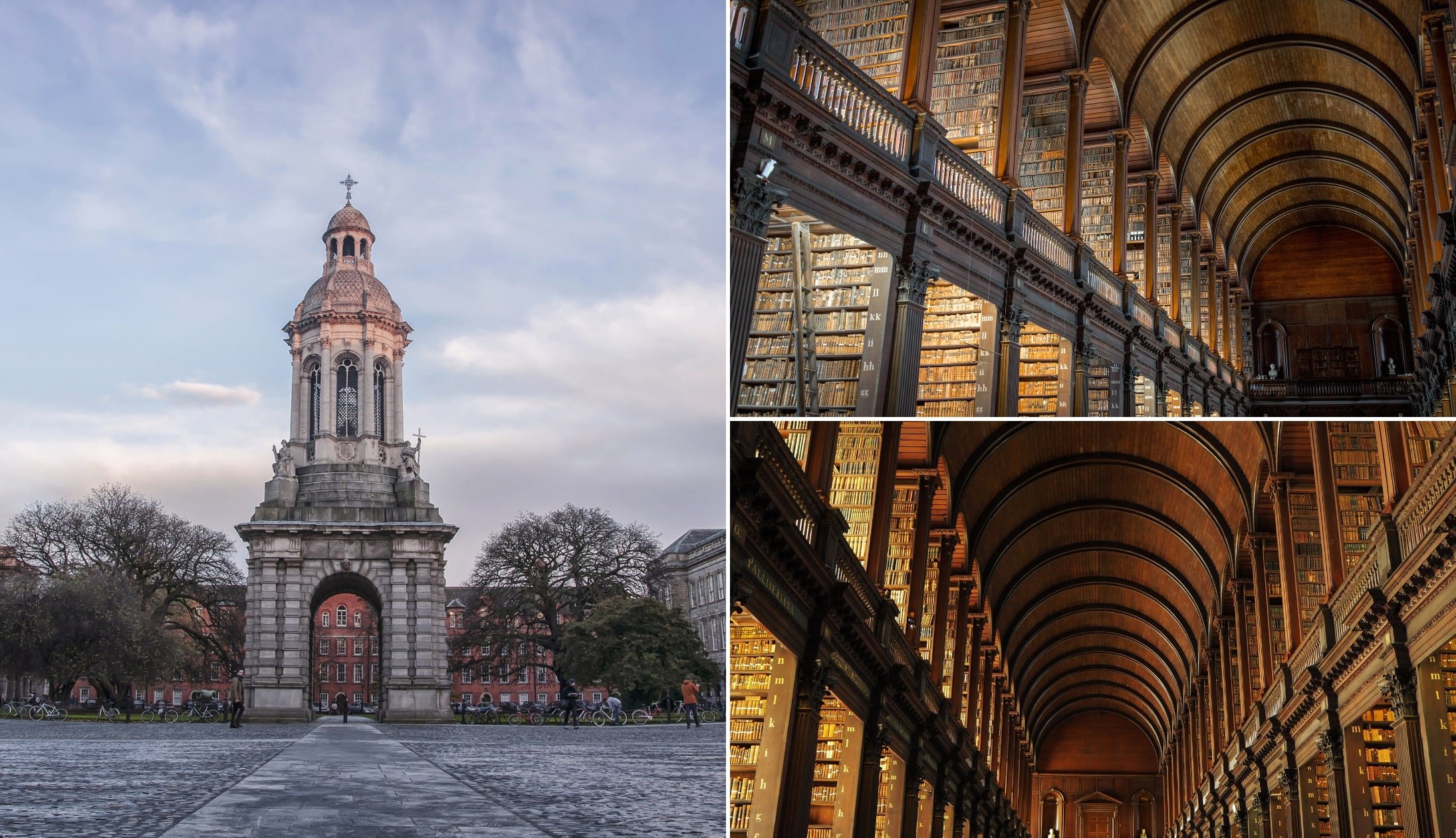
Our second stop of the day is a handy 2-minute walk from the first! Trinity College is one of the most famous landmarks in Ireland .
It is a renowned educational institution and it was established in 1592. It’s also inside the grounds of Trinity that you’ll find the ancient Book of Kells .
Trinity is the oldest university in Ireland and you can take a ramble through its impressive grounds, admire its magnificent architecture and tour the wonderful Long Room Library .
It’s in the Long Room that you’ll find 200,000+ of the college’s oldest books. It’s worth booking the skip-the-line ticket here as it gets busy ( this ticket gets you access to Trinity and Dublin Castle).
Related reads: See our guides on where to stay in Dublin + the best hotels in Dublin in 2024
3. The Palace Bar
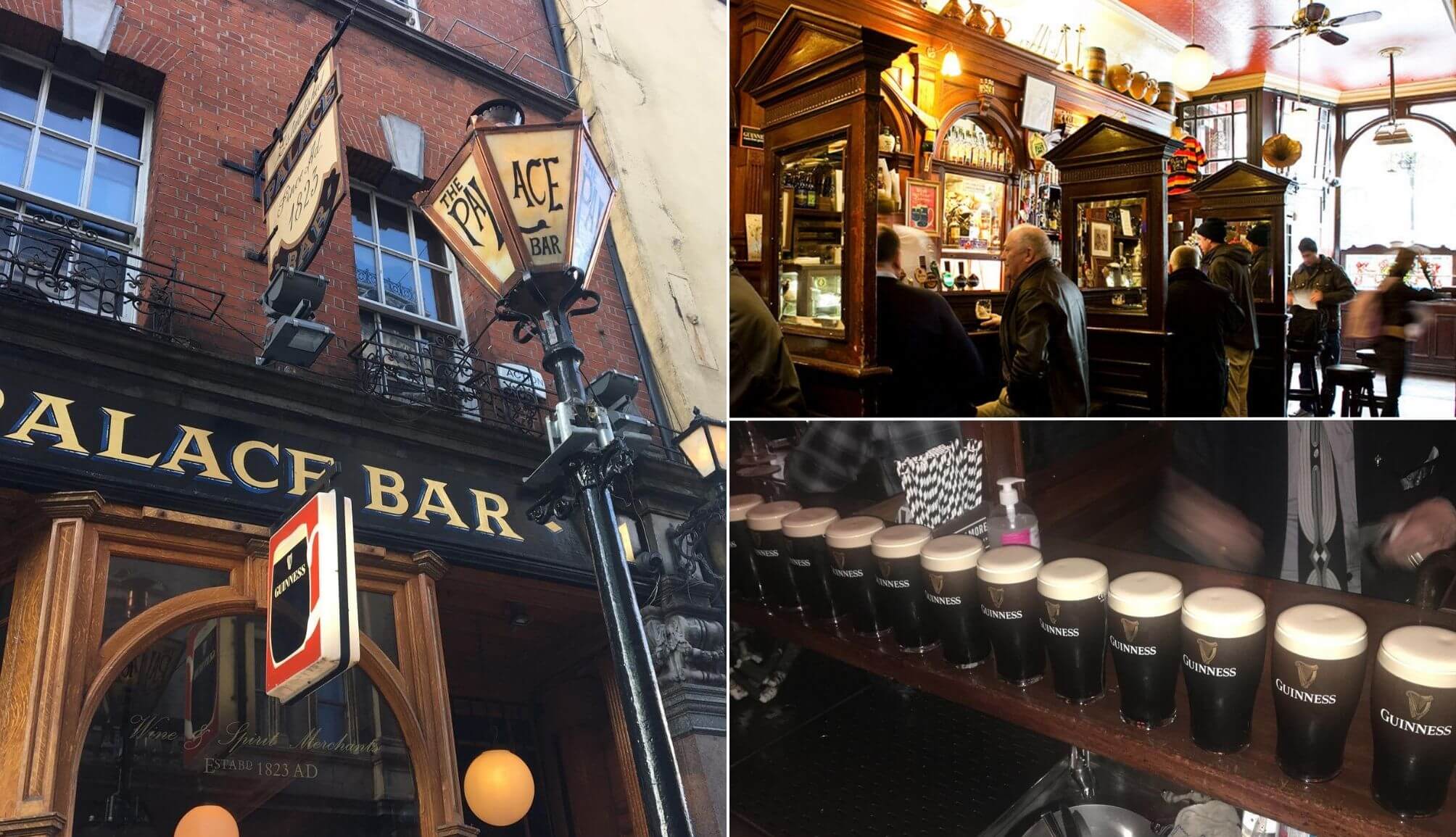
Photos via The Palace on FB
The next stop on our self-guided walking tour of Dublin is going to be a brief one (I’m not suggesting you go drinking at this stage of the day!).
While there are many old pubs in Dublin , few are as visually impressive as the Palace Bar, which you’ll find a 3-minute walk from Trinity.
This pub was built in 1823 and it stands today, many years later, as a Victorian shrine, of sorts. Admire its impressive interior, first, and then saunter inside for a nosey (you can return here later).
It’s located just inside the cobbled streets of Temple Bar , so you can have a nosey around this area, if you like.
Related reads: See our guides on the best pubs in Dublin , the best Guinness in Dublin and the best pubs with live music in Dublin
4. O’Connell Bridge

When you’re ready, take the 3-minute walk to O’Connell Bridge, which spans the murky waters of Dublin’s River Liffey.
O’Connell Bridge replaced Gandon’s Carlisle Bridge, which opened in 1794. The bridge that stands to this day opened back in 1880 and cost £70,000 to build.
It measures at 148 ft in length and 160 ft in width. Named after political leader Daniel ‘The Liberator’ O’Connell it boasts impressive features, like its impressive lanterns.
Related reads: See our guides on spending 1 day in Dublin , 2 days in Dublin and 3 days in Dublin
5. The General Post Office

Walk up the historic O’Connell Street (be careful – there are plenty of dodgy characters that hang around here) and head straight from the The General Post Office (GPO) – it’s around a 4-minute walk from the last stop.
The GPO was built during the early 19th century and it’s here that you’ll see some of the more impressive architecture in Dublin , courtesy of the buildings neoclassical design.
This building played a key part in Irish history during the Easter Rising of 1916 when it served as the rebel headquarters. You can take a tour here that’ll immerse you in the city’s past.
6. The Spire

One of the more unique places you’ll visit on this walking tour of Dublin is the Spire – it’s less than 1-minute walk from the GPO… you can’t miss it.
Also known as ‘the Monument of Light’ (along with many other colourful nicknames…), the Spire stands 394 feet tall and it was erected in 2003.
I’ll be honest – the Spire is impressive when viewed from afar, but there’s no real point of seeing it up close.
7. The Ha’penny Bridge
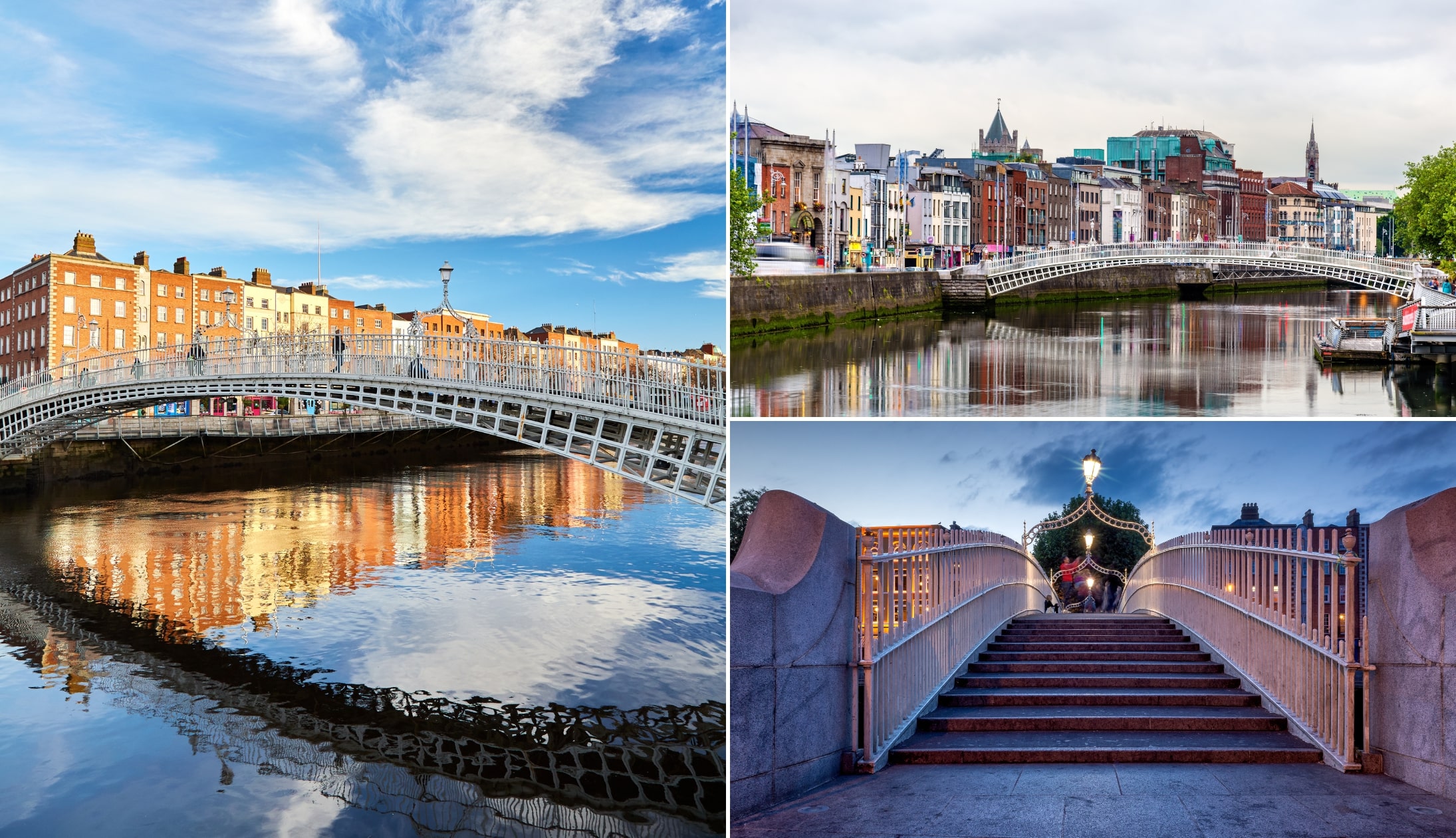
The next stop on our self-guided walking tour of Dublin is a 7-minute walk from the Spire and it’s arguably one of the most beautiful bridges in Europe!
The Ha’penny Bridge , officially known as the Liffey Bridge, is an iconic pedestrian bridge that spans the River Liffey that was built in 1816.
It’s name comes from the fact that you once had to pay a toll to cross the bridge. The cost was a Ha’penny and there were turnstiles at either end of the bridge.
The bridge is a little slice of ‘old-Dublin’ that still used heavily to this day. It’s believed that around 27,000 people cross it each day.
Related read: See our guide on how to get around Dublin
8. St. Michan’s Church
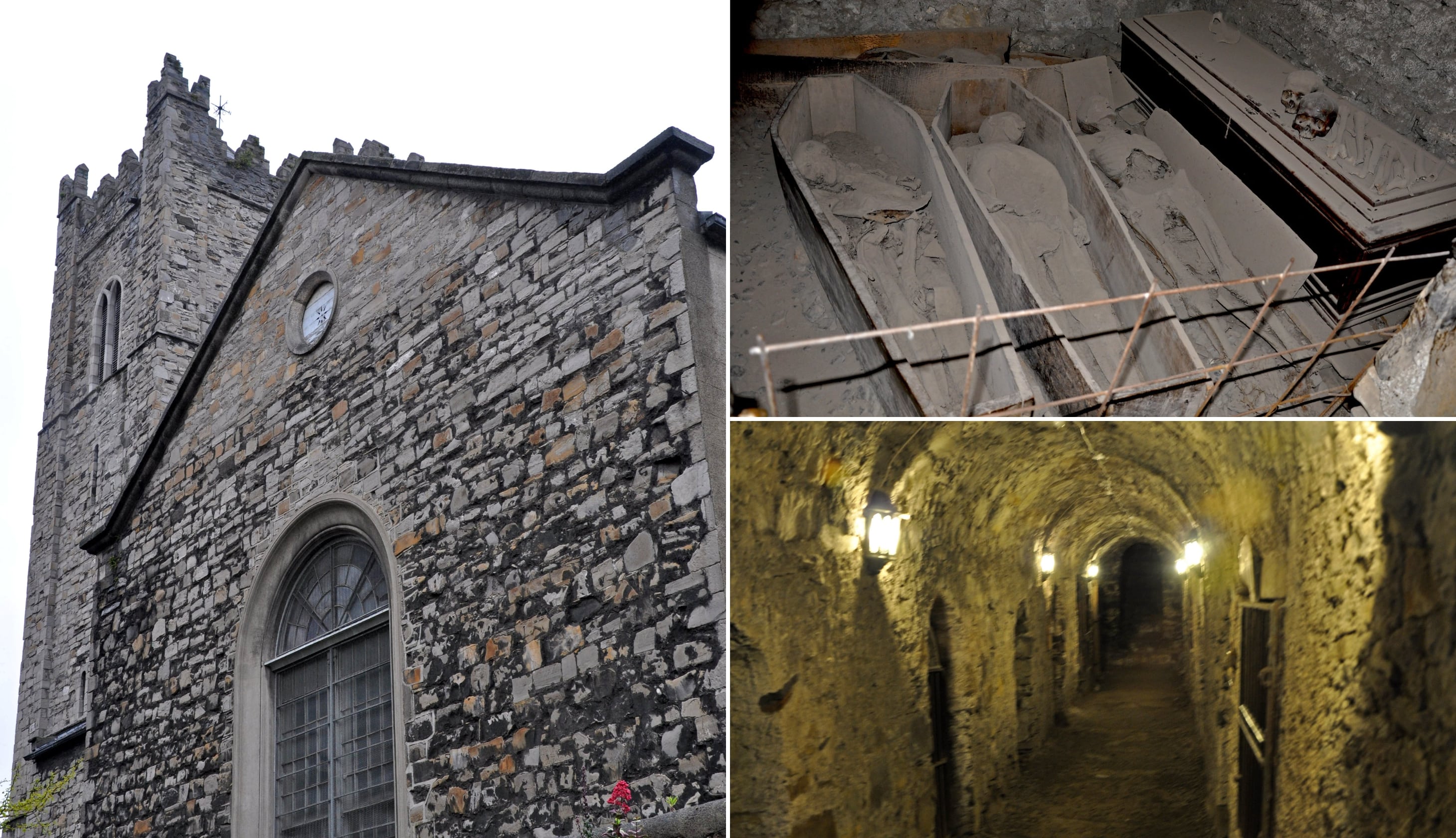
Photos with thanks to Jennifer Boyer
You won’t find our next stop, St. Michan’s Church , on many Dublin walking tours, however, it’s well-worth a visit.
It’s a 12-minute walk from the Ha’penny Bridge and it’s here that you’ll find a historic building that dates back to the 11th century.
Oh, you’ll also find crypts with mummies… yes, mummies. In fact, some of the mummies at St. Michan’s are thought to be over 400 years old.
If you’re looking for unique things to see in the capital, make sure to add this one to your self-guided walking tour of Dublin.
9. The Brazen Head

We’re off Dublin’s oldest pub, next – The Brazen Head (a 4-minute walk from St. Michan’s).
The present building that you see today dates back to 1754, local legend claims that the site has housed a tavern since 1198.
And though no documents exist to prove that, we know that there’s been a licensed alehouse here since the mid 17th-century at least (which is old enough!).
If you’re feeling peckish, this is a handy lunch-spot. It’s well worth visiting either way as this place is steeped in history .
10. Christ Church Cathedral
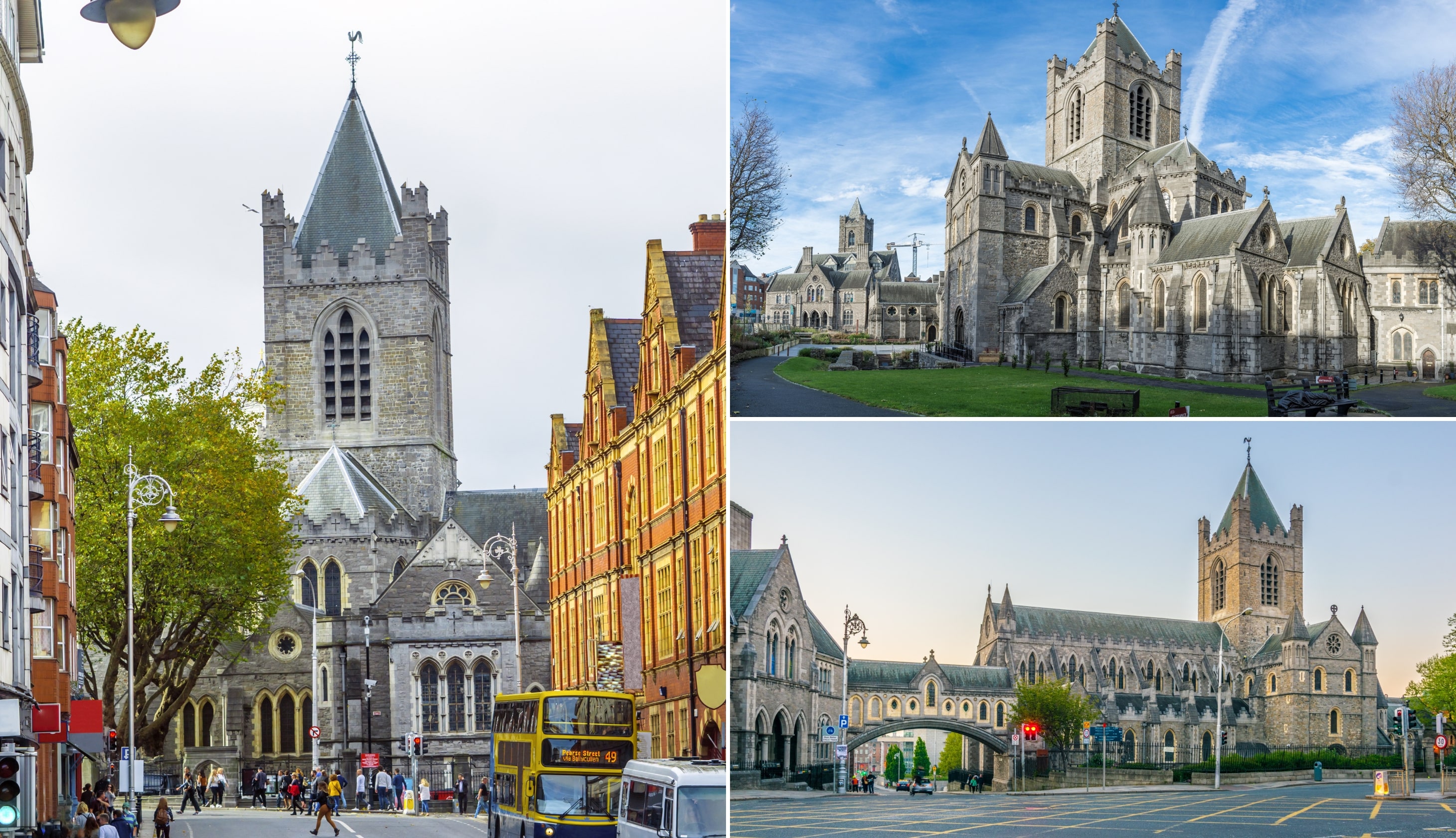
One of the most popular stops on this self-guided walking tour of Dublin is the stunning Christ Church Cathedral , a 6-minute walk from The Brazen Head.
Christ Church Cathedral was founded in the early 11th century under the Viking king Sitruic Silkenbeard (amazingly, that is his real name!).
Originally built as a wooden structure in 1030 with the help of an Irish priest, it was rebuilt in stone in 1172.
The current Gothic-style cathedral, with its striking architecture and impressive interior, has been standing since the 12th century.
11. Dublin Castle
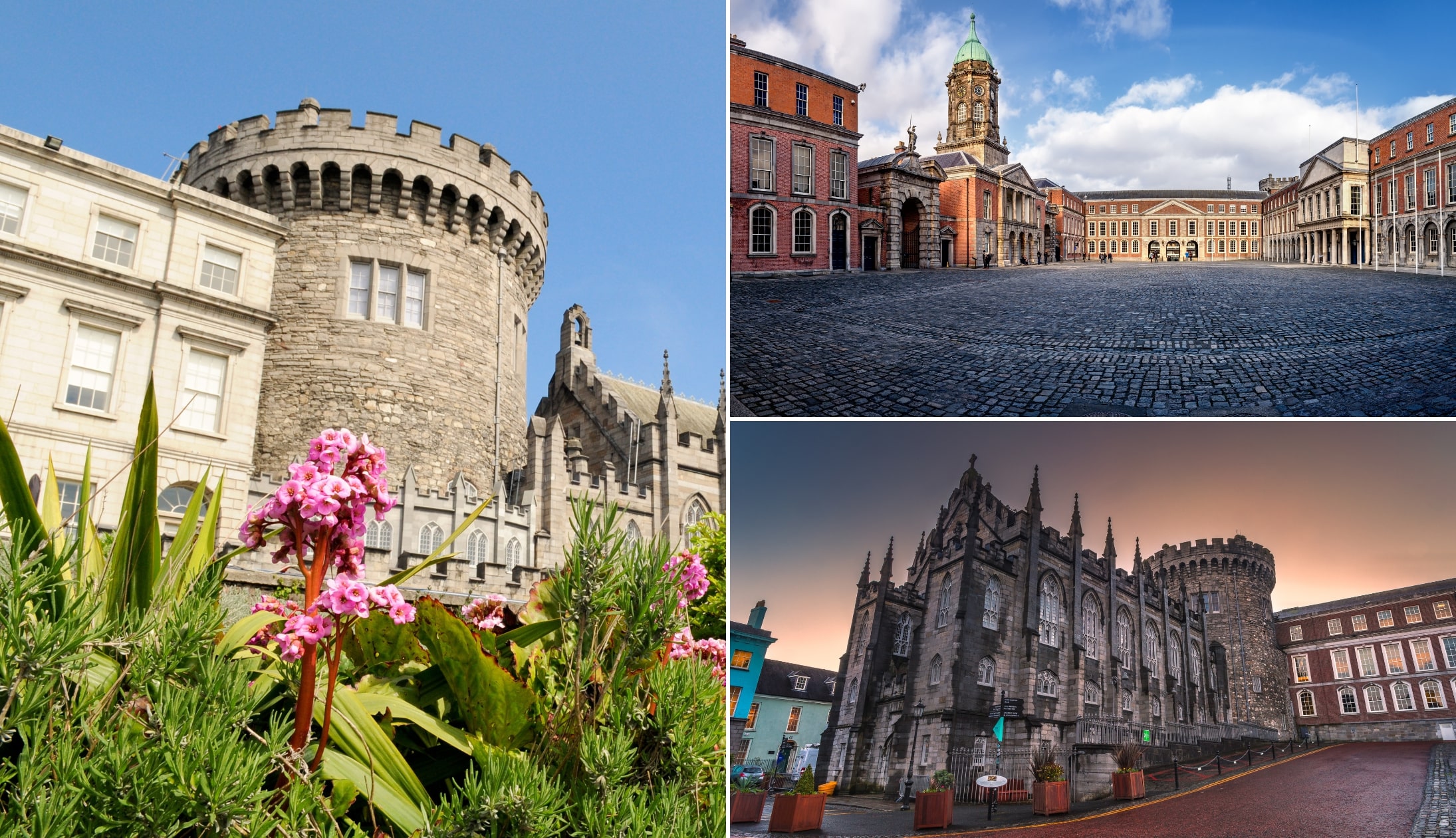
Few castles in Ireland receive visitor numbers like our next stop. Dublin Castle is a 4-minute walk away and it’s here you’ll find an impressive structure that dates back over 800 years.
Originally developed as a medieval fortress under the orders of King John of England, work on Dublin Castle was started by Meiler Fitzhenry in 1204 when the city was under Norman rule following the invasion of 1169.
Constructed on elevated ground once occupied by an earlier Viking settlement, it was completed in 1230 and took on the look of a classic Norman courtyard design.
One of the most prominent parts of the castle today, the imposing Record Tower is the only surviving tower of the original Medieval fortifications.
While its rectangular battlements on the roof are actually a 19th-century addition, they look pretty convincing!
Related read: See our guide on the best castles in Dublin
12. St. Patrick’s Cathedral
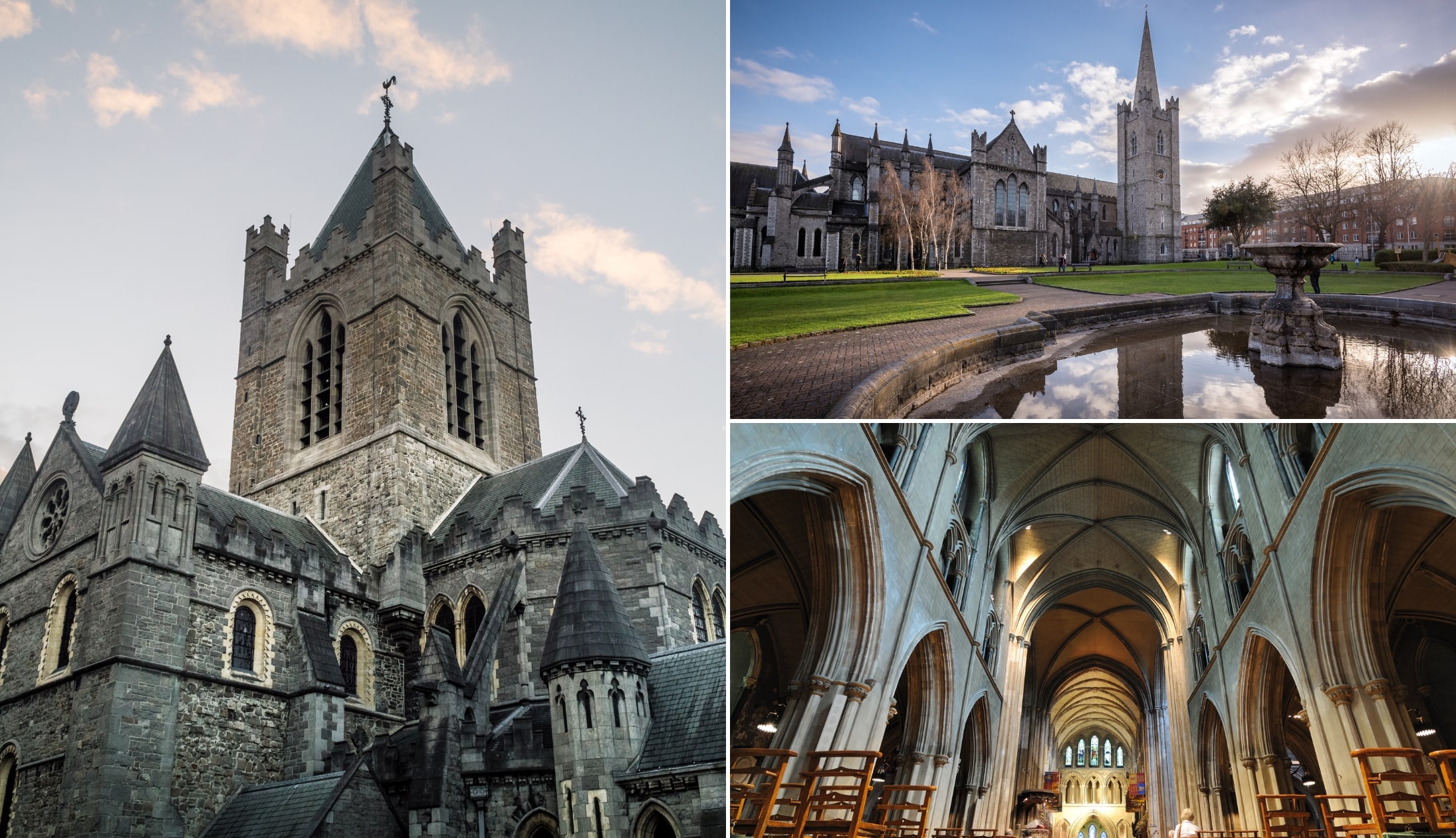
Another firm favourite on this self-guided walking tour of Dublin is located a 12-minute walk from the castle.
St. Patrick’s Cathedral is a historic religious landmark that was founded in 1191. It’s the largest church in Ireland and it boasts Gothic architecture.
When you arrive here, take some time to saunter around the part and admire the cathedral’s exterior, before heading inside to get an eyeful of its outstanding interior.
13. The Guinness Storehouse
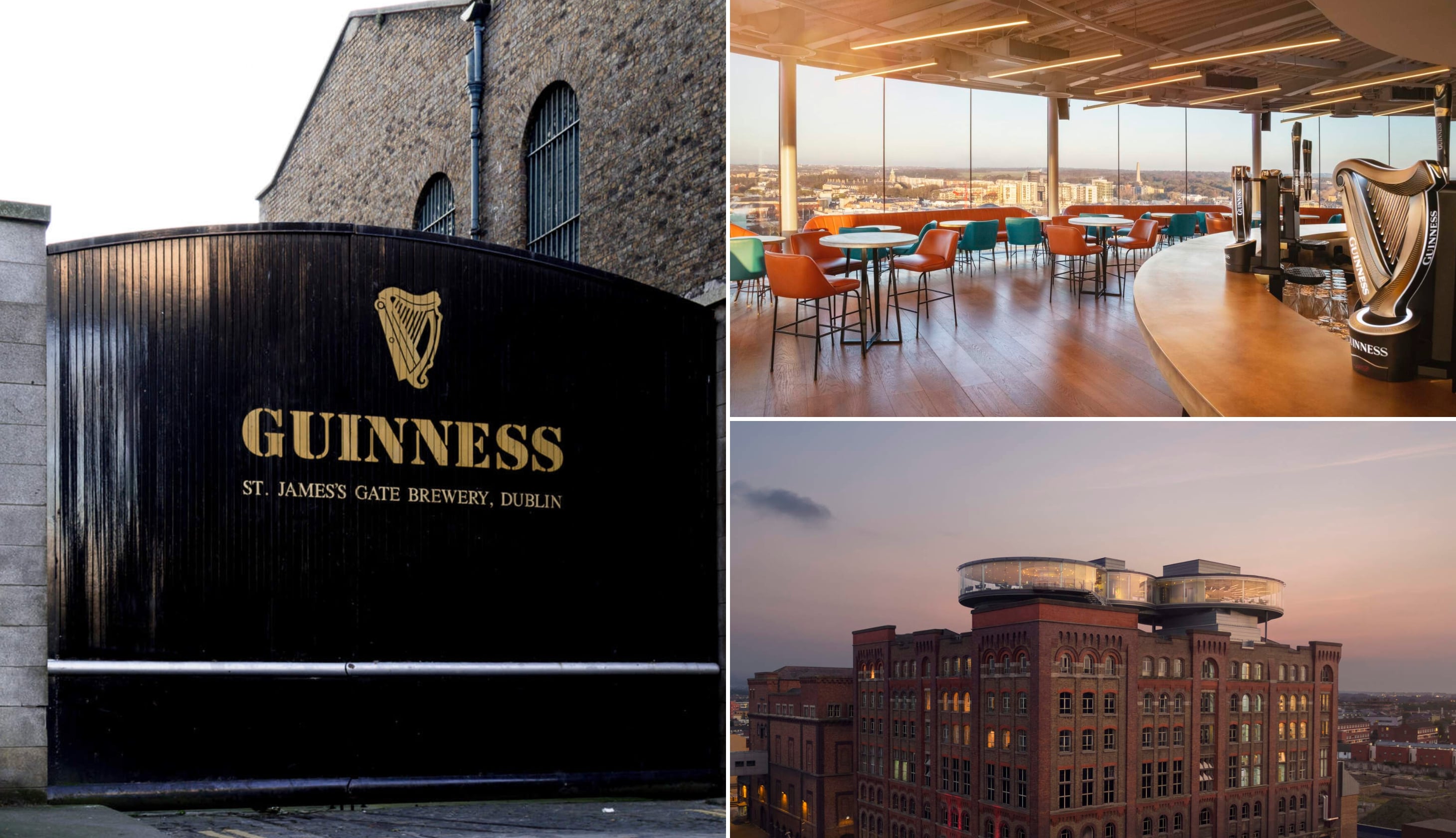
Photos © Diageo via Ireland’s Content Pool
Few Dublin walking tours can resist rounding off a day of strolling at The Guinness Storehouse , which is a 17-minute walk from St. Patrick’s Cathedral.
Book your tickets in advance (self-guided or guided) and immerse yourself in the story of the most famous of the many Irish beers .
The building itself is part of the Guinness Brewery and it acts as a seven-story visitor centre that takes visitors through the history of Guinness along with how it’s made and more.
The tour finishes on the rooftop in the impressive Gravity Bar that overlooks Dublin City and beyond.
Day 2 of our self-guided walking tour of Dublin

1. St. Stephen’s Green

We’re going to kick-start day two of our self-guided walking tour of Dublin at St. Stephen’s Green , which is often referred to as the ‘Lungs of Dublin’.
You’ll find the nine hectare/22-acre park at the top of busy Grafton Street when it’s home to commemorative sculptures, extensive trees and a large pond.
It has a pretty wild history that few are familiar with (read more here ) and it’s a nice, calm spot to kick-start the day!
2. Leinster House
The second stop of the day takes us 4 minutes down the road to Leinster House – the epicenter of Irish politics.
This is an impressive Georgian building that dates back to the 18th century. Now, while you can take a guided tour, if you like, you’re arguably best off admiring Leinster House from afar.
Unless you’re interested in politics, that is – in that case head on in for a journey back through Ireland’s political past.
3. National Gallery of Ireland

Photo left: Cathy Wheatley. Others: James Fennell (Tourism Ireland)
The National Gallery of Ireland is a 5-minute walk from Leinster House and it’s here you’ll find one of the most popular museums in Dublin .
It’s also one of the best free things to do in Dublin when it’s raining! For visiting art enthusiasts, the National Gallery of Ireland is an absolute must.
This cultural treasure trove houses a vast collection of paintings, sculptures, and decorative arts spanning various periods, from the Renaissance to the present.
Ireland’s artistic heritage can go overlooked by tourists and locals alike – this is an excellent opportunity to immerse yourself in it.
4. Merrion Square
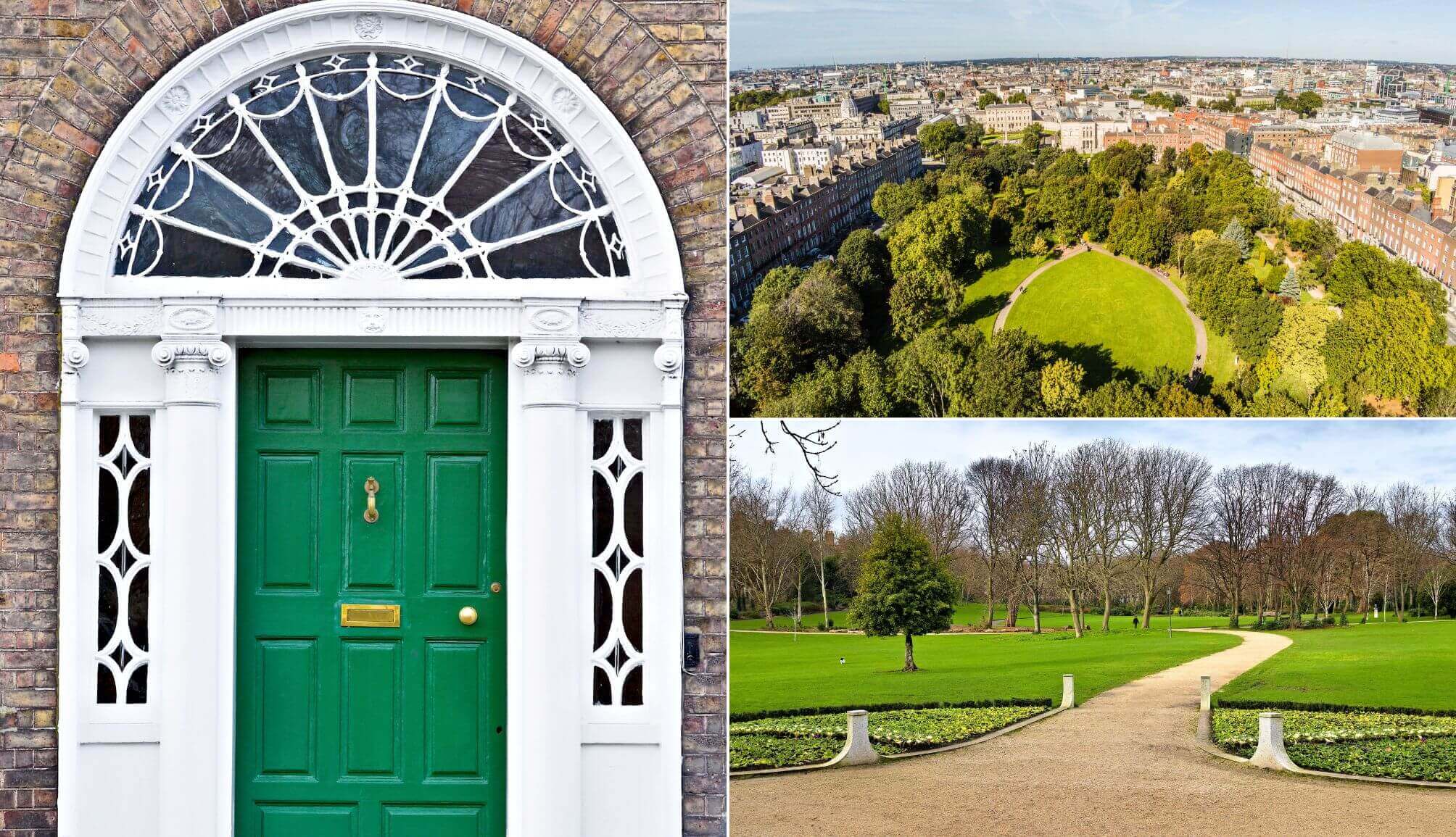
Located in Dublin’s charming Georgian quarter, Merrion Square is a delightful mix of greenery and history (and it’s only 5 minutes from our last stop).
The square boasts finely manicured gardens that feel a far-cry from the busy city streets that lay just minutes away.
If you head for a stroll through its grounds, you’ll stumble upon impressive sculptures (including one of Oscar Wilde).
5. Irish Whiskey Museum

Photos by Brian Morrison via Failte Ireland
If you’re taking this self-guided walking tour of Dublin and it’s raining, our next stop will provide some welcome respite from the elements!
You’ll find the Irish Whiskey Museum a handy 15-minute stroll from Merrion Square and it’s here that you’ll discover the story behind the coveted Irish Whiskey .
I’ve done this tour in recent years and it offers a good mix (terrible pub intended…) of sippin’ and storytellin’.
You’ll get an insight into the history of whiskey and how it’s made and there’s also a tasting at the end.
6. Mulligan’s
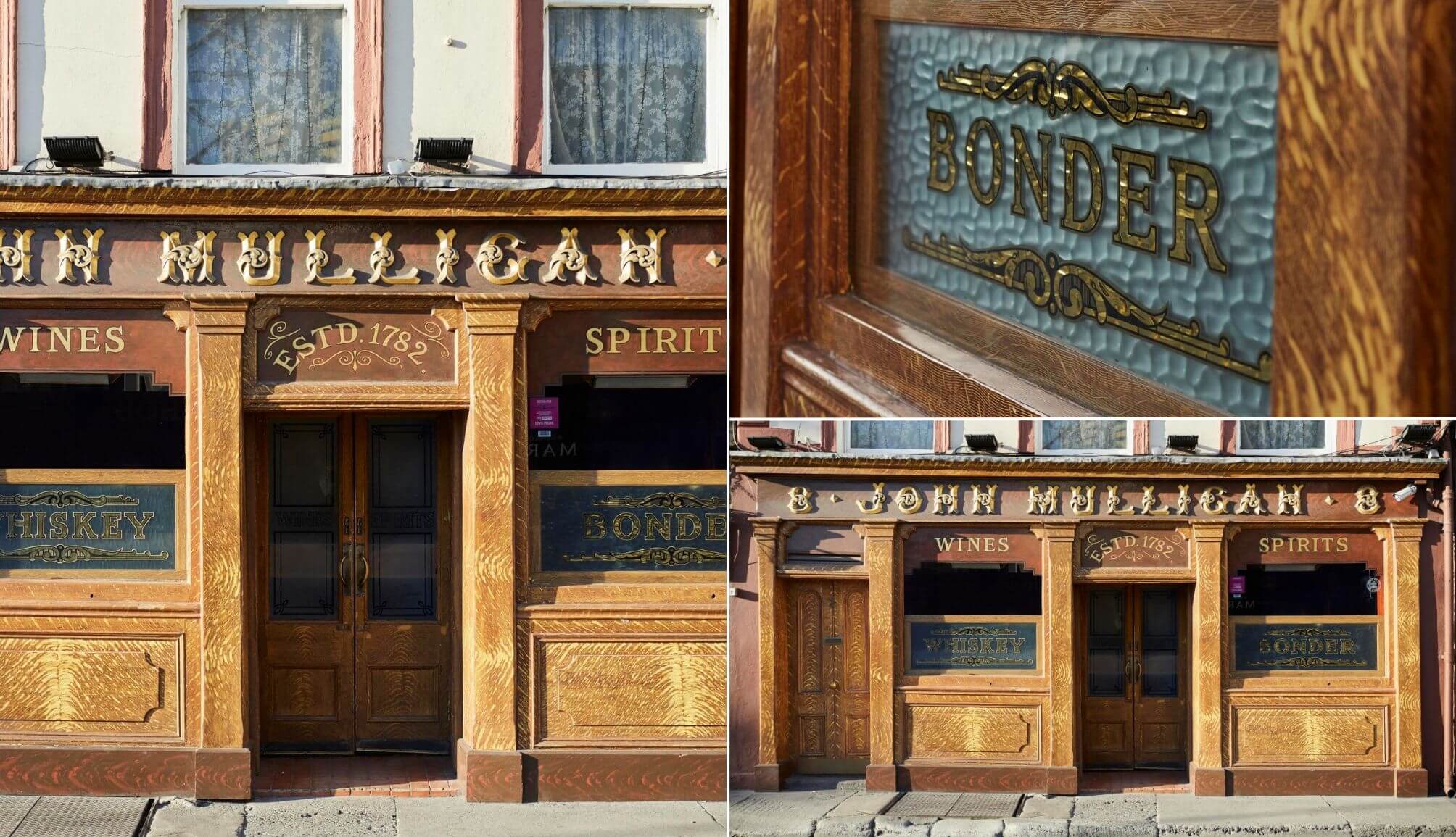
© Tourism Ireland
Many Dublin walking tours take you to the busy pubs in Temple Bar . However, if you want to dodge the tourist traps, take the 6-minute walk from the Whiskey Museum to Mulligan’s.
You’ll find it on Poolbeg Street where it’s loved by locals and tourists alike for its old-worlde charm.
The pub received its license in 1782 but it operated as a Shebeen (a place where drink was sold illegally) for many years before.
The biggest compliment that I can give Mulligan’s is that walking through its doors makes you feel like you’ve stepped back in time.
Expect a lovely, traditional interior, a fine pint of Guinness and a furnishings that have stood the test of time.
7. The Custom House

The next stop on our self-guided walking tour of Dublin is the magnificent Custom House, a 4-minute walk from Mulligan’s.
This is an architectural marvel on Dublin’s waterfront and it was designed by James Gandon in the late 18th century.
The Custom House is famous for its neoclassical facade which is best admired from afar, first, before up close.
The building is now home to the Department of Housing.
8. The Famine Memorial

Dublin’s Famine Memorial is a poignant tribute to one of Ireland’s darkest chapters in history.
Located on Custom House Quay, a 4-minute walk from the Custom House, these haunting sculptures depict the devastating impact of the Great Famine in the 19th century.
The memorial serves as a solemn reminder of the suffering endured by the Irish people during that time and stands as a testament to the resilience and spirit of those who lived through the tragedy.

Photo left: Eileen Coffey. Others: Ros Kavanagh (via Fáilte Ireland)
The next stop on our self-guided walking tour of Dublin is a handy 2-minute walk from The Famine Memorial.
EPIC The Irish Emigration Museum explores the profound impact that Irish emigrants have had across the world.
The museum is housed inside a vaulted space and stories are told via interactive exhibitions and striking displays.
You’ll need to pay into this one but it’s well-worth it (especially if it’s raining!).
10. The Jeanie Johnston

Photo left: Gareth McCormack. Others: Dylan Vaughan (via Failte Ireland)
Many Dublin walking tours omit the brilliant Jeanie Johnston Famine Ship which sits a 2-minute walk from the EPIC Museum.
The Jeanie Johnston is an impressive replica of the original ship that transported Irish emigrants to North America during the Great Famine.
The ship is a floating museum that offers an insight into the challenges faced by those Irish men and women that sought a better life across the pond.
You can take a guided tour here where you’ll be immersed in a story that shaped the very DNA of Ireland.
Dublin walking tours FAQs
We’ve had a lot of questions over the years asking about everything from ‘What’s a good route with free attractions?’ to ‘What unique stops should be included?’.
In the section below, we’ve popped in the most FAQs that we’ve received. If you have a question that we haven’t tackled, ask away in the comments section below.
What’s a good route for a self-guided walking tour of Dublin?
If you use our Dublin walking tour map above, you’ll find a clear, logical route that takes in the city’s top sights over the course of two days. You could easily chop and change this route if needed.
Can you walk around Dublin in a day?
You can see the main sights in Dublin city in one day. If you follow the route on our Dublin walking tour map, you’ll only be walking from attraction-to-attraction for a total of 1.5 to 2 hours.
Can you walk around Dublin easily?
Yes. Dublin City is very walkable. Once you have a clear itinerary and know where you’re visiting and when, you’ll have no problem exploring the city on a self-guided walking tour of Dublin.
Keith O’Hara has lived in Ireland for 35 years and has spent most of the last 10 creating what is now The Irish Road Trip guide. Over the years, the website has published thousands of meticulously researched Ireland travel guides, welcoming 30 million+ visitors along the way. In 2022, the Irish Road Trip team published the world’s largest collection of Irish Road Trip itineraries . Keith lives in Dublin with his dog Toby and finds writing in the 3rd person minus craic altogether.
This site uses Akismet to reduce spam. Learn how your comment data is processed .
Jetsetting Fools
Travel Far. Discover More. Spend Less.
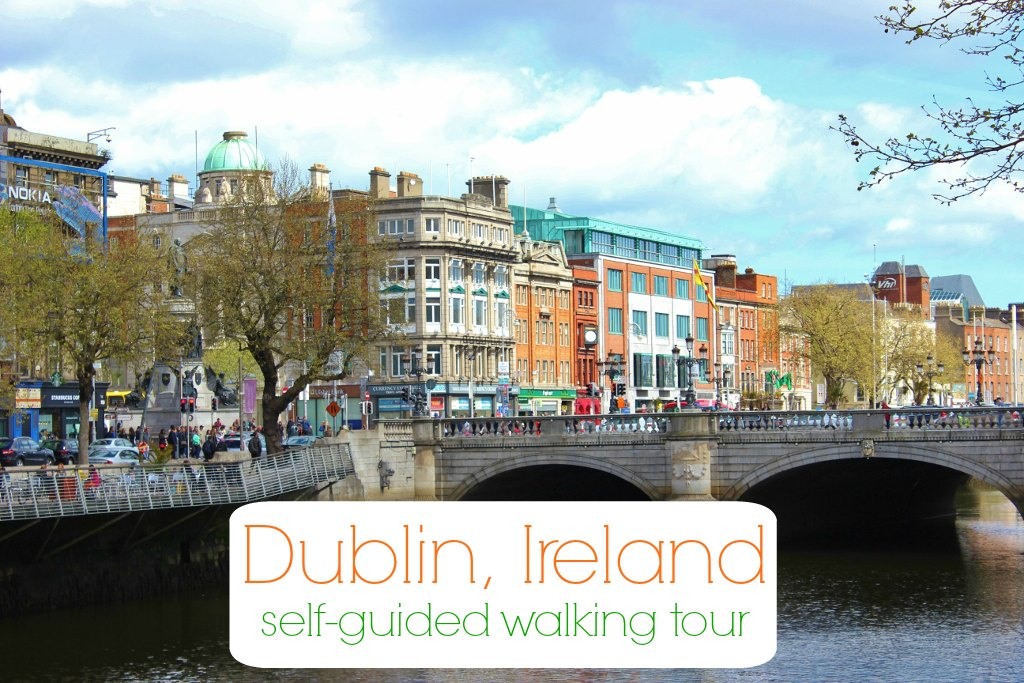
Dublin Walking Tour: A Self-Guided Walk To Dublin, Ireland Sights
Welcome to JetSetting Fools, here you will find our best travel tips for destinations worldwide. Some of the links on this site are Affiliate Links and if you use them to make a purchase, we may earn a commission. For more information, read our Disclosure Policy .
Dublin, Ireland is home to numerous iconic sights and historic attractions – and the best way to see them is on a Dublin Walking Tour. We have devised a go-at-your-own-pace Free Self Guided Walking Tour of Dublin that features the best of the city.
The top places to visit in Dublin are clustered together in the heart of the city center, which allows guests the opportunity to explore on foot. Travelers can use our easy-to-follow Self-Guided Dublin Walking Tour to navigate to the top sights… for free ! We even include a helpful Dublin Walking Tour Map to help you make your way.
Free Walking Tour Dublin, Ireland
Our free walking tour of Dublin is a self-guided adventure to top attractions. The walk focuses on downtown Dublin and is an easy, flat stroll through the city center. Our Dublin sightseeing tour, without any stops, should take about 2 hours at a casual pace.
How To Use Our Free Walking Tour Dublin
For each sight on our Dublin free tour, we provide a brief introduction, as well as some background information. Additionally, we include directions from one sight to the next. You will find our helpful map of Dublin tourist attractions – plus a printable Dublin, Ireland tour map – at the end of the article.
The route includes 15 Must-See Dublin Attractions, many of which can be entered. Some sights are free, while other require a ticket (we indicate if there is an admission fee). If you plan on entering several sights, the Dublin Pass will likely save you money and so will our article covering 50 Free Things To Do in Dublin !
Why Use Our Dublin Walking Tour Free Route
If you only have one day, this free walking tour of Dublin, Ireland will surely get you acquainted with the city, as it includes stops at all the top things to see. Visitors can complete the walk of Dublin highlights in just 2 hours, but those who are entering attractions can plan a full day of sightseeing.
Those with 2 days in Dublin – or more – can use our Free Tour Dublin Walk on the first day of their trip to get oriented. We also offer recommendations for more things to do in Dublin at the end of the article.
Free Tours Dublin: What You Need To Know
Our Free Tour of Dublin, Ireland is as advertised: absolutely free! Visitors simply follow our step-by-step tour as outlined below to the top sights. Our self-guided tour allows travelers to experience Dublin at their own pace and enter attractions as desired.
Walking Tour Dublin: Free & Guided
Visitors will see touts for many Free Tours in Dublin that are guide-led. However, it is essential to understand that a Guided Dublin Free Walking Tour is not, in fact, free. These Free Walking Tours Dublin are tip based – and guides expect (and hopefully deserve) tips.
While we have outlined our Best Free Walking Tour of Dublin, visitors may opt to join one of the many guided tours. There are many themed guided walks in Dublin, including historical walking tours, street art tours and Dublin food tours. We feature a few of the highly-rated Dublin walking tours – that are guided and require a fee – at the end of the article.
Save, Pin or Bookmark our Free Dublin Walk to use during your trip to Ireland!
Dublin Walking Tour: 15 Sights To See

Our self-guided, free tour of Dublin begins at Saint Patrick’s Cathedral. Use the provided links or the downtown Dublin Map at the end of the post to navigate from sight to sight.
#1 St. Patrick’s Cathedral in Dublin, Ireland

The first sight on our city tour of Dublin is the iconic St. Patrick’s Cathedral. It was on this site that in 450 AD St. Patrick baptized the first Irish converts. St. Patrick’s Cathedral was completed in 1191 and is the largest church in Ireland. The spire reaches 140 feet.
The cathedral is one of the top attractions in Dublin and visiting requires an entry ticket. Buy your ticket now and download it to your phone!
Map Directions from St. Patrick’s Cathedral to St. Stephen’s Green.
#2 St. Stephen’s Green

The second attraction on our Dublin, Ireland sightseeing tour is St. Stephen’s Green. The 22-acre park in the center of Dublin was created in 1664 and has been open to the public since 1880. St. Stephen’s Green features a pond, a bandstand, memorials, statues, several paths and green lawns. If you wish, you can visit the official site for more information about the park.
If there is time in your Dublin itinerary, consider having a relaxing picnic in the park. Alternatively, explore the area directly north of St. Stephen’s Green. Top attractions in the vicinity are museums (The Little Museum of Dublin, The National Museum of Ireland Archeology, The National Gallery of Ireland), the Irish parliament building (called Leinster), the historic Mansion House (the residence of the Lord Mayor of Dublin) and Merrion Square Park.
Map Directions from Saint Stephen’s Green to Grafton Street.
#3 Grafton Street

The pedestrian-only shopping district, Grafton Street, is the next stop on our tour – and one of the must-see sights in Dublin. Grafton Street leads from St. Stephen’s Green to Trinity College and features long-standing stores, recognizable brands, and historic cafes.
Sights to look for are the Brown Thomas Department Store (opened in 1849), Weir & Sons jewelry store (opened in 1869) and Bewley’s Café (opened in 1927).
Grafton Street is also popular with street performers and musicians that entertain the passers-by. In fact, even U2’s Bono has performed on Grafton. No Dublin visit is complete without strolling the iconic street.
Map Directions from Grafton Street to Irish Whiskey Museum.
#4 Irish Whiskey Museum

Whiskey is firmly part of Irish history. Today, distilleries dot the city landscape – each one offering their own story and tastings of their product. At the Irish Whiskey Museum, however, visitors get an unbiased version of the history of Irish whiskey…plus a chance to taste the product from several distillers.
The Irish Whiskey Museum is conveniently located on Grafton Street – making it a popular stop on walking tours in Dublin, Ireland.
While tickets are required for the tour and tasting experiences at the Irish Whiskey Museum, visitors are free to stop in and check out the bar and shop. If you are skipping the guided tour, brush up on your Irish whiskey history .
Map Directions from Irish Whiskey Museum to Trinity College.
#5 Dublin Trinity College

The famous Trinity College is the next stop on our Dublin walk (and it’s just across the street from the Whiskey Museum).
Established in 1592, Trinity College is Ireland’s oldest university and a must see in Dublin. The official name is College of the “Holy and Undivided Trinity of Queen Elizabeth near Dublin”, but is just called Trinity College for short.
Some of the college’s famous attendees are Oscar Wilde, Bram Stoker, Samuel Becket and Courtney Love. The 47-acre campus has buildings arranged in squares around a bell tower and the library houses the Book of Kells (buy your fast-track ticket ).
Map Directions from Trinity College to the Irish House of Parliament.
#6 Irish House of Parliament

Directly opposite the main entrance to Trinity College is the former Irish House of Parliament, and today houses the Bank of Ireland. The building is both architecturally and historically significant, which is why it is an important stop on walks around Dublin.
Built in the mid-1700s, the Irish House of Parliament was the first ever specifically designed parliament structure, in that it featured an interior with a dual chamber – one for the House of Lords and one for the House of Commons. It’s a design that is still used today in bicameral government buildings around the world.
In the year 1800, however, it was inside the building that the parliament voted (under bribery and threat of King George III) to abolish itself in order to unite Ireland and Britain under as the United Kingdom of Great Britain and Ireland. It was a relationship that only lasted 22 years.
One odd thing to note about the building is the absence of windows. While there are places for windows, glass panes were never installed as there was a Window Tax that would have driven up the cost.
Want to take a fun detour? Just around the corner from the House of Parliament is one of the most famous statues in Dublin – the Molly Malone Statue ( MAP ). Walk past the front of the Parliament House and turn left on Church Lane and walk about a block to find the famous Molly Malone. She is a character in an Irish song – a fishmonger by day and prostitute by night. The statue is often referred to as ‘The Tart with the Cart’ and visitors rub her bosoms for good luck.
Map Directions from Parliament Building to O’Connell Street.
#7 O’Connell Street and The Spire

Continue your Free Dublin Walking Tour by making your way north to the O’ Connell Street Bridge. Standing on the bridge, look up the stretch of O’Connell Street as it leads north from the River Liffey. The street has been the site of massive protests, the annual St. Patrick’s Day parades, shellings during the 1916 Easter Rising and a bombing of the Nelson Pillar in 1966.
The street is named after the influential Daniel O’Connell (who is called The Liberator for his part in the Catholic Emancipation and his efforts to repeal the 1800 Act of Union). His statue stands at the north end of the bridge.
Further along the street are many other statues featuring some of Ireland’s most celebrated figures – as well as the Spire of Dublin. Officially called Monument of Light , the Spire was built on the site of Nelson’s Pillar and reaches a height of 390 feet. The needle-like monument stands as a symbol of Dublin.
Map Directions from O’Connell Bridge to Ha’Penny Bridge.
#8 River Liffey and the Ha’Penny Bridge

The next sight on our free Dublin Tour is the River Liffey. The river runs through the center of Dublin, dividing the city into north and south. The river has been an important part of the city’s trade since the time of the Vikings.
Several bridges span the river, including three that are designated pedestrian-only, which makes for nice walks in Dublin. The most popular footbridge is the Liffey Bridge, which dates to 1816 and is better known as the Ha’ Penny Bridge for the 1/2 pence toll once required to cross it.
Map Directions from River Liffey to Temple Bar District.
#9 The Dublin Temple Bar District

Every Dublin itinerary should include one or two stops at a traditional pub! The energetic Temple Bar District on the south side of the river is chock-full of Irish pubs, restaurants and tourist shops – and is one of the Dublin areas most visited by tourists.
Enter the district through the Merchant’s Arch, directly across from Ha’Penny Bridge and turn right onto Temple Bar. It’s fun to simply roam, but Temple Bar Street is not to be missed!
The Temple Bar District is one of the best places in Dublin for a Pub Crawl ( like this one! ). Several of the bars have a line-up of live music starting mid-day and going late into the night. Our favorite pubs in the district are The Temple Bar and The Quays.
Map Directions from Temple Bar to Dame Street and the Olympia Theater.
#10 Dame Street Dublin and The Olympia Theater

The next stop on our free tour of Dublin is Dame Street, a major thoroughfare through the heart of Dublin City Centre. Lined with a mishmash of architectural styles, the street is home to numerous banking institutions, restaurants and shops.
That said, the still-operating Olympia Theater is, perhaps, the most prominent landmark on the street. Opened in 1879, The Olympia Theater is the premier theater and concert hall in the Dublin city center.
The stage has seen a slew of famous acts from Charlie Chaplin to Mumford & Sons. The theater underwent a major overhaul in the 1970s and the original iron and glass awning had to be completely restored after a truck crashed into it in 2004. For more about the history – and upcoming events – visit the official website .
Map Directions from Olympia Theater to Dublin City Hall.
#11 Dublin City Hall

Built as the Royal Exchange in the mid-1800s, the building was transferred to the city government and renamed Dublin City Hall in 1850. The building is still used by the Dublin City Council today.
It is free to visit Dublin City Hall. Step inside the rotunda, where giant columns support the domed ceiling. The murals on the walls of the rotunda tell the story of Dublin’s history, which the tiled floor mosaic depicts the city’s Coat of Arms.
Map Directions from Dublin City Hall to the Dublin Castle.
#12 Dublin Castle

Next up on our Dublin historic walking tour is the grand Dublin Castle. The Dublin Castle was built between 1208 and 1220 as the residence of viceroys.
Although the castle is now used as a conference center and event complex, the buildings of Dublin Castle represent some of the oldest architecture in the city. It remains one of the top tourist attractions in Dublin. It is free to walk on the grounds, but a ticket is required for admission inside, where they also offer tours of Dublin Castle. Get more details for you visit.
Map Directions from Dublin Castle to Christ Church Cathedral.
#13 Christ Church Cathedral of Dublin

The Christ Church Cathedral is the next stop on our tour. One of the top attractions in Dublin, Ireland, the Christ Church Cathedral dates to Medieval times.
The church was built around the year 1030 – making it older than St. Patrick’s and one of the best places to visit in Dublin for a history lesson. It was expanded in 1171, but most of the current structure was built between 1871 and 1878. An entry ticket is required for admission, unless you are there to pray. Visit the official Christ Church website for more information.
Map Directions from Christ Church Cathedral to John’s Lane Church.
#14 John’s Lane Church

Although lesser-known than St. Patrick’s and Christ Church Cathedral, we think the John’s Lane Church is one of the Dublin hidden gems, which is why we include it in our free Dublin walking tour.
The church was built on the previous site of St. John’s Hospital between 1862 and 1895. The French Gothic steeple reaches over 200 feet and is the tallest in Dublin – however, it is the colorful interior that is most striking. John’s Lane Church is one of the churches you can enter in Dublin for free.
Map Directions from John’s Lane Church to The Brazen Head Pub.
#15 The Brazen Head

Claiming to be Ireland’s oldest pub, The Brazen Head is said to have origins dating back to the year 1198. The classic Irish pub features quaint rooms, three bars and live music.
The traditional Brazen Head pub is a perfect place to stop for a pint at the end of a Dublin Self-Guided Walking Tour. For more information, read our article about The Brazen Head and be sure to also check out our Guide to Dublin’s Best Pubs !

MAP OF CITY CENTER DUBLIN, IRELAND
When embarking on Self Guided Walking Tours of Dublin, Ireland, a map is a must! We provided map links to each sight on our free Dublin walk, but we have a few more maps that will help you get from the first to the last stop!
Walking Route for Self Guided Tours in Dublin
Use this link to Google for a Dublin sightseeing map that has turn-by-turn directions for our Self-Guided Walking Tour Dublin, Ireland. Note: While the map does not list every sight, the route is inclusive of all the stops on our tour.

Interactive City Center Map: Dublin, Ireland
Use this link to a Interactive Downtown Dublin Map to help route your way to the sights and attractions listed on our Self-Guided Dublin Walking Tour.

Dublin, Ireland Self-Guided Walking Tour Map PRINTABLE
This is a printable map of Dublin. To print our Dublin, Ireland must-see map, first click on the map to enlarge it, then right-click and select Print.

More Tours and Guided Walks in Dublin
Our above outlined free tour of Dublin is a great way to see the city. In fact, we think it is the Best Free Walking Tour Dublin that allows visitors to see the city at their own pace.
However, visitors who want to learn more about the history of Dublin and meet fellow travelers may want to consider joining a Dublin tour guide for their walk.
The guided tours in Dublin range in price and duration – and focus on specific themes.
Dublin Historical Walking Tour
The history of Dublin is fascinating. Join one of the easy 2-hour walking tours of Dublin that focuses on that vibrant history. Led by a local guide, participants are guided through the city while listening to the interesting facts and information that shaped Dublin. Get the details!
Dublin Pub Crawl
When we think about things to do in Dublin, the first thing that comes to mind is drinking in pubs. We could have easily spent our days in Dublin doing nothing more than sipping pints of Guinness goodness; it really does taste better in Dublin!
However, then we would have missed out on Dublin sightseeing – and we weren’t going to visit Dublin and not see the top tourist attractions!
After a day of Dublin city sightseeing, however, visit the best pubs in Temple Bar on one of the entertaining Dublin night tours to the best bars! Book this tour!
Dublin Dark Side Walking Tour
There is a dark side to Dublin – as evidenced by gruesome stories of the past. On the Dark Dublin Tour participants will learn about the brothels and witches and the Hellfire Club while waltzing through back alleys and dark city streets. Book it…if you dare!
Ghost Tour Dublin
Join one of the Dublin guided tours to the spookiest spots in town! Learn the haunted history of Dublin on a spooky Gravedigger Ghost Tour. Note: This is a bus tour…which will give your feet a much-needed rest. Find out more!
Dublin Literary Pub Crawl
Follow in the footsteps of Ireland’s most famous writers…to the pubs, of course! On this Dublin Literary Tour, listen to stories of the great writers and learn about Dublin’s pub culture. Book the Literary Pub Crawl!
1916 Tour Dublin
The 1916 Tour is a Dublin history tour that focuses on the events of the Uprising. The 1916 Rebellion Walking Tour includes visiting key locations, re-enactments and multi-media presentations for a unique experience. Learn more!
Pro Tip: Looking for free walking tours about the Easter Rising? Use the Self Guided Dublin Walking Tour audio guide podcast for a basic intro.
Food Tour in Dublin
Join a guide for a grazing tour of Dublin on this highly rated Food Tour. Learn about the history and local cuisine while feasting your way past city sights. Reserve your space!
Alternatively, embark on a journey to experience the contemporary food culture with the best bites at a few of the top restaurants. Get the details!
Street Art Tour Dublin
The city of Dublin has a vibrant street art scene. Visitors interested in learning more about the alternative side of Dublin can join the Street Art Tour to find off the beaten path local haunts. Book it!
Dublin Private City Tour
Those who want a personal introduction can join one of the Dublin Private Walking Tours. On this private tour, visitors get to see Dublin with the help of a local guide. Get the details!
For more themed Dublin walking tours, check out these of Dublin City Tours .
More Fun Dublin, Ireland Tours
Once you have the lay of the land, indulge in a few essential Dublin experiences and tours.
- Visit Dublin’s Guinness Storehouse for a connoisseur tasting
- Head to the Jameson Distillery for a lesson on Irish whiskey
- Take a River Liffey cruise
Hop On Hop Off Dublin Tour Bus
Visitors interested in sightseeing without all the walking can catch a ride on one of the Dublin Bus Tours. The Dublin sightseeing bus routes make stops at (or near) all of the top attractions. The bus tickets also include other perks, like on-board commentary, discounts at top sights and a guided Dublin walking tour.
Sightseeing Hop On Hop Off Bus Dublin
The classic, red Hop On Hop Off Tour in Dublin has two routes that stop at 28 places of interest – plus two walking tours included in the price. Visitors can opt for a 1- or 2-Day Pass .
Green Do Dublin Hop On Hop Off Bus
Do Dublin is another tour company that offers a Hop On Hop Off Dublin, Ireland bus service. In addition to the 24- and 48-hour bus tickets , the Dublin tour company tickets also include transportation to and from the airport, as well as use of all Dublin city bus routes – plus free admission to The Little Museum of Dublin.
Top Tip : A Dublin City Bus Tour is also included in the Dublin Pass , which can save money on entry into sights, too!
Tours and Day Trips From Dublin, Ireland

Use the city as a base and explore Ireland on one of many Dublin day trips. Visitors can explore on their own or join one of the highly rated tours that explores the region outside of Dublin City Center.
One of our favorite getaways is a short jaunt to the coastal village of Howth. Visitors can easily plan their own Day Trip To Howth – or book a guided trip . Other simple day trips from Dublin include the beachside community of Bray and the lovely village of Malahide .
Visitors can also travel to Northern Ireland to see the city of Belfast . Again, plan the trip on your own or join a tour from Dublin of Northern Ireland and Giant’s Causeway .
Other popular day tours from Dublin include seeing the stunning Cliffs of Moher (with a stop in quaint Doolin ), Visiting Galway or making a trip to the Blarney Castle (and kissing the Blarney Stone, of course!).
Dublin day tours are offered by many companies. Read reviews from fellow travelers to find the best Ireland tours from Dublin on Viator !
Looking for multi-day Ireland trips? Set out from Dublin to see Ireland highlights on a five-day tour or enjoy the sights of Ireland on a six-day trip .
Travel Tips For Your Dublin Trip
We have just a few final tips for your trip to Dublin! Planning an Ireland trip can feel a bit overwhelming – so we are outlining the essentials below – like where to stay, how to get there and what to pack.
Also check out our 3 Day Dublin Itinerary and 7 Day Ireland Itinerary for even more things to do! If you are coming from abroad, read our advice on Planning a Trip to Europe .
As you make your plans, you will find that staying organized is key. To stay on top of all the details, use our Printable Travel Planner , which includes 25+ pages of travel organization!

Where To Stay in Dublin, Ireland
We think the best place to stay in Dublin, Ireland is in the center, where it is easy to access the top sights and attractions on foot.
That said, during the summer tourist season, top value hotels book up quickly – so you will want to make sure you secure Dublin accommodations in advance of your trip. Before you start your search, read our tips for Booking the Best Hotels .
Two of the highly-rated Dublin hotels are Leonardo Dublin Christchurch and Temple Bar Inn . Budget travelers can search for Dublin Hostels – like Garden Lane Backpackers . Finding a vacation rental through Airbnb is another option on your vacation to Ireland.
Getting To Dublin, Ireland
Dublin can be reached by plane, train, bus, or ferry. Our preferred method of getting anywhere is by flying, we are JetSettingFools, after all! When we do need to purchase cheap plane tickets , we start our search for the best deals on airline fares on Skyscanner .
Flying to Dublin from the US is easy, with direct flights from DC , Philadelphia , Boston , NYC , Chicago , and SFO . Additionally, DUB is well-connected with all major European hubs like London , Frankfurt , Paris , Madrid , Lisbon and Amsterdam !
To get between destinations when flights are not possible, we usually rely on public transportation and take trains or buses. Dublin Bus and Bus Eireann provide bus transportation services in Ireland.
We aren’t keen on driving abroad, but renting a car can often save time and money (especially when traveling with more than two people) – and having a car rental allows for greater discovery.
Dublin Walking Tours: What You Will Need
Now that you know all about the Best Walking Tours of Dublin – plus other fun activities and essentials – it’s time to get ready for your sightseeing!
Make sure you are prepared by bringing the following items along with you. You can find all of our packing hacks and advice on our Packing Page – and grab your FREE packing checklist !
Travel Shoes
Although Downtown Dublin, Ireland is a very walkable, travelers will want to ensure they pack comfortable city walking shoes . I like to wear lightweight, rubber-soled shoes, like Columbia shoes or NB Trainers . Kris prefers wearing Merrell trail shoes, even in the city!
Ireland Weather Attire
The weather in Dublin is always unpredictable. It’s best to bring along a packable raincoat or travel umbrella for your free walking tour of Dublin. For those sunny moments, don’t forget sunglasses , sunscreen and a wide-brimmed travel hat .
Whether you travel with a backpack or a suitcase , you will also want to have a great day bag to organize all your daily travel essentials . When we explore a city on foot, we like to wear small backpacks where we can stow our wallets, keys, map, jacket and umbrella.
Travel Camera
On walking tours of Dublin, Ireland visitors see heaps of top sights. While many travelers use their phone, we believe it is best to invest in an actual travel camera that will take high-quality photographs. We carry a Canon Rebel with a 18-135mm lens . This DSLR is a perfect budget camera for beginner photographers – as it comes bundled with heaps of accessories and is easy to use!
WiFi Connection
In our free Dublin Walking Tour, we include map links to get from sight to sight. However, in order to use those links, you will need a WiFi Connection . While many US cellphone providers offer temporary international data packages, they can be expensive! Instead, we recommend purchasing a WiFi Mobile Hotspot .
Not only can we connect up to ten devices at one time (which is perfect for families or friends traveling together), but we purchase an eSIM in advance and are connected the minute we touch down off that long-haul flight . We would be lost without it – literally! That said, we still think it is also a good idea to carry a paper Dublin map and/or guidebook .
Ireland Travel Insurance
Travel insurance may help in the case of cancelled flights or lost luggage – as well as illness or injury while abroad. Consider traveling protected with World Nomads .
Start planning your trip to Ireland ! Search for the lowest airfares , the best accommodations and fun things to do …then start packing ! Want more travel advice? Head over to our Travel Planning Page for more tips on traveling – and for country-specific information, take a look at our Travel Guides Page !

Pin it! See all of our travel pins on our JetSetting Fools Pinterest Board .

Share This Story!
- Click to share on Pinterest (Opens in new window)
- Click to share on Facebook (Opens in new window)
- Click to share on Twitter (Opens in new window)
- Click to share on LinkedIn (Opens in new window)
29 thoughts on “ Dublin Walking Tour: A Self-Guided Walk To Dublin, Ireland Sights ”
Pingback: Wanderlust: Adventures in Ireland, Part 1 – Not So Subtly Sam
Pingback: Ireland: Some Do’s and Don’ts | Telltale Blush
Pingback: Madeline On Earth – Dublin, Ireland – Many Adventures of Madeline
Pingback: Ireland Frugal Travel - Dublin Part 2 - MoneyAhoy
Pingback: Planning our trip to Dublin - Adventitious Violet
Comments are closed.
This website uses cookies to improve your browsing experience and analyze the use of the website. Learn More

Self-Guided Dublin Tour

This post is a self-guided tour of Dublin that covers all the iconic sites on the city's south bank as well as some lesser-known haunts.
The tour should take approximately 1.5 hours or just a bit less than that. The walk is approximately 1.5 km (just over 1/2 a mile).
Don't forget that you can also book a pay-what-you-like live-guided tour of the city centre with us!

- Start: Viking Longboat Statue
- End: St Stephen's Green
Click the map to enlarge it or to download it to a smartphone.
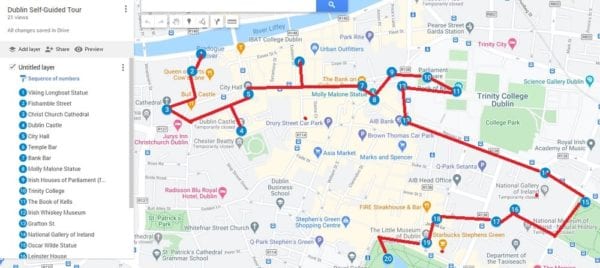
GPS-Enabled Audio Tour
We also offer an audio tour of historic Dublin, researched, written, and recorded by one of our own tour guides.
Here’s a sample.
Book the Dublin audio tour .
1. Viking Longboat Statue
We’ll see a lot of monuments in the course of the walk, and this one wins the prize for the most useful.
It doubles as a bus stop. If you have it to yourself, pretending to row is a classic photo opportunity.

It surprises many visitors, but Vikings are a major part of Dublin’s story.
Initially raiders, in 841, some of them decided to settle down in Ireland, and they established towns along the coast.
2. Fishamble Street
Today, Fishamble Street is lined with modern buildings today, but its history was discovered starting in 1974 when the Dublin City Council decided to move its offices to a four-acre site here.
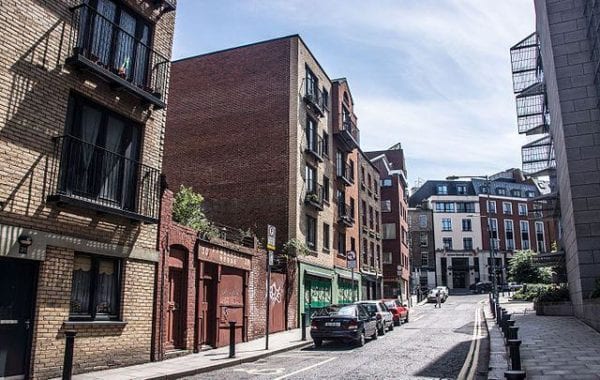
When archaeologists spoke up to say they’d found one of the most intact sites of its age in Europe, residents rallied around the idea of preserving it.
Those artifacts are mainly on display at the National Museum of Ireland, and the sidewalk here has little nods to them.
On the left side of the street, you can find five bronze markers with the shapes of artifacts unearthed here.
3. Handel’s Messiah
Also on the left, as the street begins to bend to the right, is a short, narrow white wall with a decorative arch.
This is the former entrance to the New Music Hall, wherein in 1742 the premiere of Handel’s Messiah was performed.

Messiah is a fixture across the English-speaking world during the Christmas season, and no less so here – except the annual tradition here happens on April 13 th , the same date as the original performance.
And since this is no longer a music venue, it takes place outside.
4. Christ Church Cathedral
There’s a lot to see on the grounds of Christ Church Cathedral – the stunning exterior, a labyrinth in the courtyard if you need somewhere to clear your head, and the interior, available to explore with either a guided or self-guided tour.
Inside, you’ll discover impressive stained glass windows and a mosaic floor, and sacred objects from the building’s history as both a Catholic and a Protestant church.
You'll also find a tower with a world-record-setting number of bells – 19 – and a crypt with the preserved remains of a saint as well as of a mummified cat and rat.
All that inside the oldest structure still in use in Dublin.

The story of this church is long and interesting but you’ll need to learn more with the PDF and/or audio tour version.
If you’re interested in exploring inside, the church hosts services, tours, and music events.
Prayer services are held weekday mornings at 10 and evenings at 5, except on Wednesdays when they hold a choral evensong at 6. Sunday Eucharist is at 11 am.
Tours are available Thursday through Sunday, with first admission at 10 am and last admission at 4:15 pm.
Tickets are 7 Euros and fifty cents for adults with various concessions available.
The tour includes access to the bell tower and crypts, both of which involve stairs.
Tickets: https://www.mytoptickets.com/?3B041324-155D-D234-0AA684C0D2E68919
5. Dublin Castle
For more than seven centuries, Dublin Castle was the center of government in Ireland.
While there are still some older elements under the castle, most of what you can see dates from after a major fire.
It took place in the 17 th century, so the castle was rebuilt in the heyday of Dublin’s famous Georgian style of architecture.
Dublin Castle was built near the meeting of two rivers: the Liffey, where our tour started, and the Poddle, which still merges into the Liffey here, but today flows underground.

If you’d like to visit the castle, it’s open from 9:45 am to 5:45 pm daily, with final admission at 5:15 pm.
Self-guided and guided tours are available. Guided tours are an hour long and cover the State Apartments, the undercroft, and the royal chapel; tickets are 12 Euros with concessions for students, seniors, and children.
Self-guided tours offer access only to the State Apartments and exhibitions; these are 8 Euros, with the same concessions.
6. City Hall
City Hall is open to the public and free to enter.
Right through the door is a vast, impressive, echoing entrance hall with a massive dome, plus a glass elevator so you can see the whole thing from above.
All this opulence comes from the fact that when this was built in the 18 th century, it was the royal stock exchange and custom house.
But, when the city bought it in the 1850s for its current function, they added a floor mosaic with the city seal.

There’s also a rotunda, which is available to visit when it isn’t rented out for events.
And the basement is home to a small gallery with a broad exhibition of artifacts from Dublin’s history.
There’s also a café inside if you’re due to rest a while. The building is open Monday through Saturday, from 10 am to 5:15 pm.
7. Temple Bar And The Irish Rock ‘N’ Roll Museum
Curved St, Temple Bar, Dublin 2
The area you’ve been walking through is called Temple Bar. For newcomers, the name can be confusing – it’s the name of a neighborhood, not a drinking establishment.
For the “Bar” part of the name, think sandbar rather than whiskey bar. It was named for the riverbed it borders.

Today, the bars are of the whiskey rather than the sand variety, and the neighborhood has become a place where art meets nightlife.
The highlight of the neighborhood is its live music venues, and the Irish Rock N Roll Museum was built right in the middle of the action.
Within a few blocks, you’ll find art galleries, theaters, festivals, and lots of bars, more often than not with live music.
There are lots of other things to do in Temple Bar, and it’s well worth exploring this area at more leisure.
It’s also tourist central for Dublin, so scoping things out and making plans during the daytime can save you time after nightfall.
8. Bank Bar
The Bank is a bar and restaurant today, but it started out as a bank.
If you looked inside City Hall earlier, you’ll have gotten an impression of what Irish institutions of commerce looked like in the 18 th century.
This building takes that atmosphere into the late 19 th century.
The current interior was designed in the 1890s, and it was given the stained-glass ceilings, mosaic floors, and generally over-the-top décor that would inspire confidence in investors.

All that grandeur is still there – if you’re here during open hours, you’re welcome to step inside and get a look at the place, whether or not you plan to patronize it.
And if you did decide to stay awhile, you could also see the bank vaults, which are in the basement near the restrooms.
Another treasure on offer is a full replica of the Book of Kells – the main tourist attraction of Trinity College, a couple of stops ahead.
The Bank Bar is open from 11 am to 10 pm daily.
9. Molly Malone Statue
This is Molly Malone. She’s the subject of a song called “Cockles and Mussels,” which is famous to the point of cliché among Irish people.
The title comes from the line “cockles and mussels alive, alive, oh,” which is a cry that street vendors selling mollusks actually used in the 19 th century when the song probably originated.

But its origins are mysterious, and its main character may or may not have been a real person.
Molly Malone is one of the most stereotypical Irish names you could think of.
The character, real or not, meets a tragic end.
After taking up the family business of selling seafood from a cart, she meets the song’s narrator and leaves a strong impression, but then dies of fever and haunts the streets, hawking shellfish for eternity.
And you actually can hear Molly’s voice today.
This is one of the Talking Statues of Dublin – twelve monuments that can talk to you through your phone with the help of a QR code on a plaque located nearby.
10. Irish Houses Of Parliament (Former Location)
We’ve already seen a couple of examples of transformed houses of commerce, a stock exchange turned into a city hall and a bank turned into a bar.
This is a house of parliament turned into a bank.
It was built in 1729 when Ireland was dominated by an English upper class but still had its own legislature.
Like the English Parliament, it was a bicameral or two-house parliament, with a House of Lords and a House of Commons.
They had no permanent home and met where they could, often in religious spaces or private homes, where it could be difficult to even fit all the members, much less do their work gracefully.

This building was commissioned to solve that problem.
The architect was himself a member of parliament, and he designed the first building in the world meant to serve exactly the purpose of a two-house legislature.
In 1800, the Acts of Union, passed by both the English and Irish Parliaments, formally joined the two lands into the United Kingdom.
The Irish Parliament was dissolved. Three years later, the Bank of Ireland acquired the building.
11. Trinity College
What you’re seeing now is the oldest part of Trinity’s campus, mostly consisting of 19 th -century buildings.
Trinity is the single college that makes up the University of Dublin. Similar universities in the UK contain many colleges.
And that was the model the founders had in mind in 1592 when a Church of Ireland archbishop asked the English crown to grant land that had once belonged to a monastery for the creation of a university.

The bell tower, called the Campanile, is the centerpiece of this area – it’s from 1853, so it’s been here long enough to develop some lore.
Trinity is one of the most respected universities in the world, and its alumni can be found in many corners of the present and of history, including the Irish separatist movement.
Several Irish presidents went here, and it’s particularly known for its literary graduates.
James Joyce unsurprisingly wasn’t one of them, but Oscar Wilde, Jonathan Swift, Samuel Beckett, Bram Stoker, and lots of others were.
And when it comes to literary significance, Trinity also has an undeniable claim to fame: the Book of Kells , located in a stunning library just a few steps away from the Campanile.
It’s the university’s main attraction for visitors, but not the only one: the campus is also home to a zoological museum (only open during the summer), a science museum, an art gallery, and a theater.
12. The Book Of Kells
If you don’t know the Book of Kells, it isn’t the kind of book you sit and read.
No one is allowed to touch it, it’s in Latin, and even if you know the language, it’s written so elaborately that it’s almost unreadable.

But the decoration is the point: the Book of Kells is an illuminated manuscript.
It's a copy of the four gospels of the New Testament of the Bible written so artfully that it’s considered Ireland’s single foremost cultural artifact, and one of the greatest works of art of Europe’s Middle Ages.
The word “Kells” comes from the Abbey of Kells, which was where the book was kept for centuries and probably where at least part of it was made.
The building where it’s located is called the Old Library, built in 1712, and the part that houses the book is the Long Room, a 65-meter room that’s remarkably beautiful on its own.
It’s also home to a 15 th -century wooden harp – an instrument that was as essential at one time to Gaelic music as the fiddle is today.
This one is the basis for the harp design seen on the Irish emblem and on the logo of Guinness.

Because abbeys were wealthy, they were targets for Viking raids, and that disruption probably destroyed many works of Insular Art and ended the era of their creation.
Given how fragile the book is, its survival is remarkable, and it’s had some close scrapes.
It was stolen once, probably less for the book itself than for a jeweled cover; the cover was torn off and the book was thrown away, but somehow it was recovered.
13. Irish Whiskey Museum
Famous as Irish whiskey may be, it’s on its way out of a dark age.
After a heyday in the 18 th and 19 th centuries, when there were many hundreds of distilling companies on the island, by 1972 the number was down to one.
That company was Irish Distillers Limited, which produces well-known brands like Jameson, and in 1988, that single company became a subsidiary of a beverage giant based in France.
But 1988 also saw the opening of the first new distillery in Ireland in many decades. And today, there are 32.

This museum opened in 2014 and tells the story of that rise and fall and rise again, going all the way back to the drink’s origins.
The word “whiskey” comes from the Irish phrase “uisce beatha,” which means “water of life” – a straight translation of the Latin “aqua vitae,” which was the medieval name for any kind of solution involving alcohol.
The museum offers tours, a whiskey blending experience, and a brunch.
Of course, it has a bar, which has around 100 whiskeys and hosts live music and other events Friday through Sunday evenings, closing at 10:30 pm.
14. Grafton Street
Grafton Street is Dublin’s most famous corridor for shopping and people watching, and from here until St. Stephen’s Green, where the street ends, it’s pedestrian-only.
The street is mostly retail, and it has a little of everything from high-end to low-end, and some of the oldest businesses here are Dublin or Irish exclusives, mostly high-end shopping.
There’s Brown Thomas, a classy Irish department store, JM Barnardo Furriers, Weir and Sons Jewelers, and James Fox Cigars and Whiskey.

The smallest local businesses are the musicians – Grafton Street is busking central for Dublin.
One other local business to keep an eye out for is Bewley’s Oriental Café, founded in 1927.
Besides a place to stop for coffee or lunch, it’s also a historic hangout for writers – James Joyce not only spent time there but mentioned it in his book Dubliners.
15. National Gallery Of Ireland
Merrion Square West, Dublin 2
The National Gallery has been one of the best places to see art in Ireland since 1854.
It’s got both a national and a continental focus, with plenty of Irish artists, but also lots of other Europeans, from medieval to modern.
The Grand Gallery in particular mixes the two – it’s a long, elegant space showing works from across Enlightenment Europe, but all with some relation to Ireland, whether by artist or subject matter or the painting’s back story.

A local favorite piece is Irish painter Frederic William Burton’s The Meeting on the Turret Stairs .
Or, for some emphatically Irish subject matter, you could find Daniel Maclise’s The Marriage of Strongbow and Aoife , which depicts the cementing by marriage of the alliance between Diarmat Mac Murchada and his Norman allies.
But you can also see Vermeer and Caravaggio and Picasso, among other greats.
Admission is free for the main gallery, with admission sometimes charged for temporary shows.
Exhibitions and events: https://www.nationalgallery.ie/whats-on
16. Oscar Wilde Statue
Oscar Wilde stood out, and in a city full of statues in simple bronze or stone, so does this monument.
Artist Danny Osborne did his research, and given Wilde’s taste for overdressing and living beyond his means.
Osborne chose fitting materials: it’s made of four different stones from places as far apart as Canada and India, with bits of porcelain and bronze, plus the giant chunk of quartz he’s sprawled on, which is the only element sourced from Ireland.

He’s wearing a Trinity necktie and his wedding ring.
The female figure in his view is his wife Constance Lloyd, pregnant with one of their two sons; one of their grandchildren officiated at the unveiling of the monument.
And the male torso is meant to be Dionysus, the ancient Greek god of wine and drama.
Behind the flashy exterior, though, his private life was shaky.
He had a lasting relationship with Lord Alfred Douglas, a young man who introduced him to London’s underground gay scene.
Wilde eventually found himself on trial for sodomy and gross indecency. He was sentenced to prison with hard labor for two years.
With all this in mind, to see what the artist had in mind for this statue, you have to look at it from both sides.
His face is split like a tragicomic mask. Viewed from the right, he’s smiling, and you can see the society man and the quick wit; the other side shows him as he emerged from prison.
Besides reading Wilde’s many words engraved on the statues, you also have another opportunity to hear this statue talk, just like the Molly Malone one; there’s a link to information in the notes.
http://www.talkingstatuesdublin.ie/
17. Leinster House
Leinster House is the home of the Oireachtas, the Irish legislature, since 1922.
As before the Acts of Union, it’s a two-house legislature, but without the distinction between nobility and non-nobility drawn under the old system, and without English names.
Today, the two houses are the Seanad, the upper house, and the Dáil, the lower house, both of which meet here.

Unlike the old Parliament House, Leinster House wasn’t built for the purpose of legislative action.
It was a private residence, finished in 1748 for a man who would eventually become the Duke of Leinster.
But in 1922, when the Oireachtas has its debut at Leinster House, closely watched by hopeful locals and curious international press, it gave them a particularly Irish welcome: the proceedings of the legislature were held in the Irish language.
Fun Fact: Leinster House was partly the basis for the United States’ White House, designed by Irish architect James Hoban.
18. National Museum Of Ireland – Archaeology
This museum covers the history of Ireland from the Stone Age to the Late Middle Ages, along with a few exhibits on the ancient Mediterranean.
The area called the Treasury shows a history of Irish art, from the Iron Age through the development of the church-influenced Insular style (including illuminated manuscripts) to the Viking-influenced style that followed.
Another show focuses on prehistoric gold ornaments made during the Bronze Age.
And another focuses on the more practical items of prehistoric life in Ireland, including a 4500-year-old boat and the island’s oldest known musical instruments.

The last of the permanent exhibitions focus on Viking life in Ireland, including relics from the elaborate burial traditions observed in the Norse religion, as well as Christian art created by those Vikings who settled and converted.
Other exhibits are shown on a temporary basis, and if you’re lucky – or unlucky, depending on how you feel about it – you may see bog bodies.
These are human remains naturally preserved in peat bogs, likely part of an ancient human sacrifice ritual.
Exhibitions: https://www.museum.ie/en-IE/Museums/Archaeology/Exhibitions
Events: https://www.museum.ie/en-IE/Museums/Archaeology/Events
The museum is open Tuesday through Saturday, 10 am to 5 pm, and Sunday and Monday, 1 - 5 pm. Admission is free, as it is at all four of the National Museum of Ireland locations.
19. The Mansion House
Through all of Dublin’s political upheaval and the game of musical chairs its governing institutions have played, this place has been unusually stable: since 1715, it’s been the official home of the Cathaoirleach, the mayor of Dublin.
It’s also been the scene of plenty of other major political moments.
In 1919, the first Dáil, or the lower house of the legislature, met here and spoke the declaration of Irish independence (there was also a centennial celebration of that event in January of 2019).
And in 1921, the Anglo-Irish Treaty, formalizing the terms of separation between the UK and the Republic of Ireland, was signed here.

And before either of those events, this was where Michael Collins, a leader of the Irish separatist movement, evaded arrest by the British military by sweeping the floor and pretending to be a janitor.
Civic ceremonies are held here today, such as when the city bestows the title of Freeman of Dublin, a high honor that comes with grazing rights on the public greens and the duty to defend the city in case of attack.
All kinds of political and cultural figures have been honored in this way, so take a moment to imagine a future siege of Dublin when the city is defended by Michael Gorbachev, Bono and the Edge, and Barack and Michelle Obama.
20. The Little Museum Of Dublin
Next to the national museums we’ve seen, this is a humble place, but it’s also a local favorite.
It’s a scrappy, homemade, self-described “people’s museum,” focused on the part of Dublin history that’s still in living memory – think more U2 paraphernalia and soccer memorabilia than illuminated manuscripts and bog bodies.
It’s also a young museum. In 2011, a call was put out to the public for objects that screamed 20 th century Dublin, and the results were arranged in three floors of a Georgian townhouse.
For Dubliners, it’s a nostalgia experience on top of being educational.
They sell a variety of tickets – for 8 Euros you can get either a roughly hour-long self-guided experience or their staple, a half-hour guided tour.
The same price gets you access to their several themed tours:
- a tour of Irish women’s history every Monday at 4 pm
- a walk of St. Stephen’s Green every day at 3:30 pm
- a tour themed around writers every day at 11:30 am
- a tour within the museum of queer Dublin history every other Saturday at 4 pm.
15 Euros gets you an all-day pass for whatever’s on the day’s schedule.
There are guided options in Irish sign and French, and there’s a free tour of the museum Wednesdays at 11 am.
The building is also home to a project called the City of a Thousand Welcomes, which can arrange, usually with some notice, for you to meet a Dubliner, one-on-one or two-on-one.
21. St. Stephen’s Green
As indicated at the last stop, there’s enough to see in St. Stephen’s Green to make a whole walking tour on its own.
But it’s also a good place for leisure, which may be in order by now.
The park is open 7:30 am to dusk Monday through Saturday, 9:30 am to dusk on Sundays.
From here on the northside of St. Stephen’s Green, you’re just a short walk from the lake that spans most of the park’s width.
When you reach the water, you can make a right and walk a little further to find a bridge crossing a narrow point in the lake and leading to the center of the park, where you’ll find a Victorian flower garden.

To the right from there is a garden designed for blind visitors, with plants chosen for their smell and physical texture, and to the left, in a bend in the lake, a bog garden.
The park was originally a commons used for grazing, but in the 17 th century, homes were built around it, and it became a private park for the residents.
In 1880 it became a public park, thanks to the philanthropic work of the Guinness family, the people behind Guinness beer.
One of them bought the park and paid for its renovation, and today he’s one of the many statues and monuments in the park.
During the Easter Rising, separatists seized the park, dug trenches, and fought against the British military, with a pause in the fighting so a groundskeeper could feed the ducks.
The park still shows the marks of that event: there’s a monument called the Fusilier’s Arch at the northwest entrance, which still has bullet holes in it.
And in the center of the park, opposite the bridge across the lake, is a bronze bust of Constance Markievicz, an Irish woman who fought in the Easter Rising, was the first woman elected to the British Parliament, and also served in the First Dáil and as a minister in the first government of the Republic of Ireland.
This is the end of the tour. We hope you enjoyed it.
Free Walking Tours
Our free walking tour page lists the various pay-what-you-like walks that are available on a daily basis in English and Spanish.
These tours usually last 2.5 - 3 hours each. You can book tours here .
Tourist Passes and Bus Tours
If you purchase a Dublin Pass or GoDublin Card , you'll get small-group guided walking tours included.
A hop-on-hop-off bus ticket will get you easy transportation around the city - directly to Dublin's most popular attractions. Audio guides and guided walks are also offered with each ticket.
Back to top
RELATED POSTS:
- Free Dublin Walking Tours
- Hop-On-Hop-Off Bus Tour
Choose a Destination... I want them all PLUS general travel tips. Amsterdam Berlin Boston Charleston Chicago Dubai Lisbon London Los Angeles Miami Nashville New York City New Orleans Paris Philadelphia Prague Rome San Francisco Washington DC
About The Author

Stephen Pickhardt
North america, united kingdom & ireland, middle east & india, asia & oceania.

15 Sights in One Day | A Self-Guided Walking Tour of Dublin
Dublin city centre is fairly compact and can be easily explored on foot. Knowing the Irish capital very well, I put together an itinerary for a self-guided walking tour of Dublin focusing on sights located in the city centre so you can see as much as possible in one day.
Time spent on this tour depends entirely on you. It can be completed in less than 2 hours if you plan on just getting a feel for the city. Or you can spend all day if you decide to explore further and visit some of the attractions along this walking route of Dublin .
So let’s jump right in!
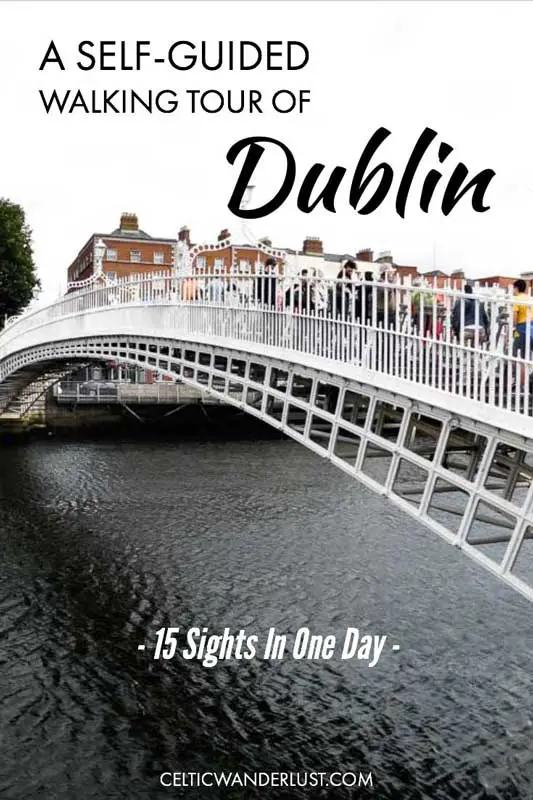
Disclaimer This post may contain affiliate links. If you click on a link, I earn a little money at no extra cost to you.
Best Online Resources to Book your Trip to Dublin
- Getting There | I would recommend Aer Lingus and Air France , two reliable and affordable airlines. If you’re travelling from the UK or France, you can also sail to Dublin with Irish Ferries and Stena Line .
- Where to Stay | You’ll find accommodation for every budget on Booking.com . Cheaper options can be found on Hostelworld .
- Things to Do | You can buy tickets, skip-the-line passes and day trips with GetYourGuide and Viator . Context Travel offers private tours led by local experts.
- Getting Around | Travel from and to Dublin airport with Aircoach or Dublin Express . Transport For Ireland free app will help you navigate the city transport network if you ever need a bus.
- Planning | Lonely Planet Dublin city guide is one of my favourite travel guides when it comes to planning a trip to the Irish capital.
- Travel Insurance | Don’t forget to buy travel insurance before visiting Dublin. Heymondo has a nifty app to help you get the assistance you need while on the go.
More Travel Resources
Self-Guided Walking Tour of Dublin – PART 1
A. O’Connell Street
Start your day on O’Connell Street . This large thoroughfare featuring statues to various Irish political leaders was in large part rebuilt after the violence of the 1916 Easter Rising . O’Connell Street has been the backdrop to several political events over the years and remains today the starting point of public protests and demonstrations.
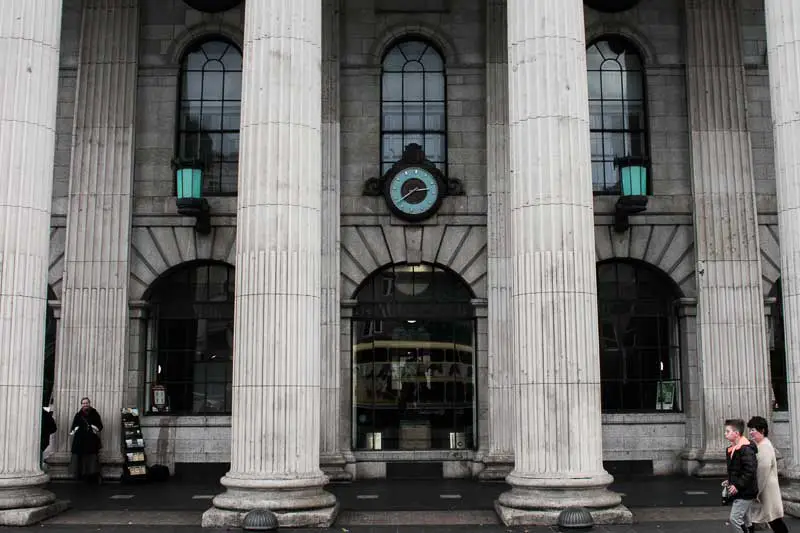
On O’Connell Street is one of Dublin’s main landmarks: the General Post Office . It is still a working post office today, rebuilt after its near-destruction during the 1916 events. Don’t hesitate to have a quick look inside, or why not check out its Easter Rising museum .
Also on O’Connell Street can be found the Spire , a controversial 121-metre-high needle of stainless steel that is now one of Dublin’s most recognisable features.
B. Ha’Penny Bridge
Taking a selfie on the Ha’Penny Bridge is a real cliché that few can resist. It is also a real challenge. Made of cast iron, this elegant but narrow 19th century pedestrian bridge over the River Liffey is a Dubliners’ favourite to cross between the North and South side of the city. Also very popular with tourists, it can become congested at times.
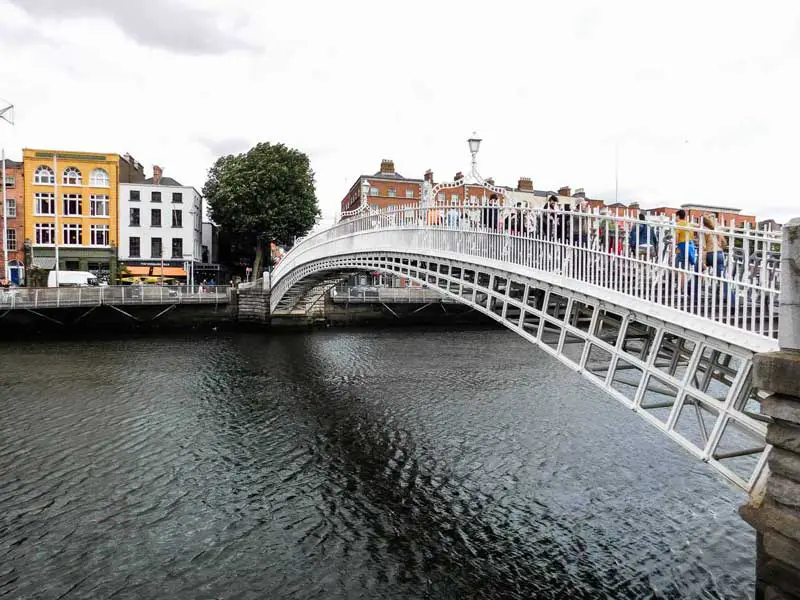
The bridge was built in 1816 to replace rickety ferries used by pedestrians to move between the North and South bank of the river. It owes its name to the toll that people had to pay to cross the river: half a penny.
You might also be interested in: – Ireland Travel Books | The Best Guidebooks to Plan your Irish Adventure – Beyond the Cityscape | The Best Seaside Towns Near Dublin – The 4 Best Distillery Tours in Dublin To Learn About Irish Whiskey – 5 Amazing Places to Visit Near Dublin Without a Car
C. Temple Bar
Once you have crossed the Ha’Penny Bridge, head straight beneath the archway and enter Temple Bar . The most photographed part of Dublin, Temple Bar is famous for its colourful pubs and Irish music pouring down its cobbled streets.
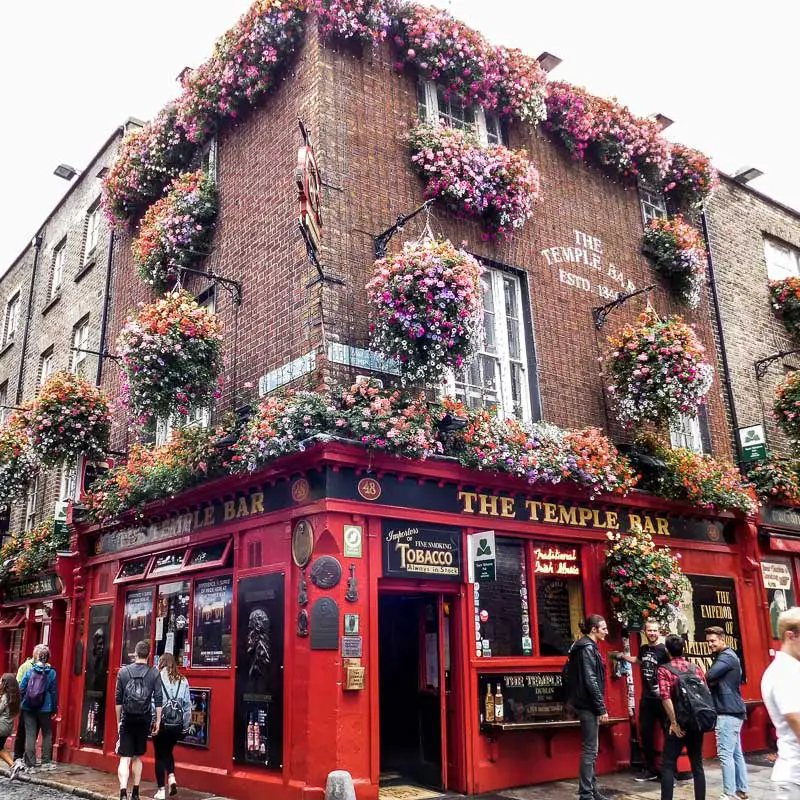
Often decried by locals as a tourist trap charging exorbitant prices for a pint of beer, Temple Bar is also Dublin’s cultural quarter , home to funky vintage shops, interesting art galleries, reputable restaurants and – a favourite of mine – a food market every Saturday.
D. Dublin Castle
Just across from Temple Bar is Dublin Castle . This wonderful piece of Georgian architecture is a must-see castle to visit on your first trip to Dublin . Dating from the 18th century, it replaced an earlier Norman fortress ravaged by a fire in 1684.
You won’t be allowed to enter the building without a ticket, but you can take a stroll around the Upper Yard for free and admire the Chapel Royal from outside.
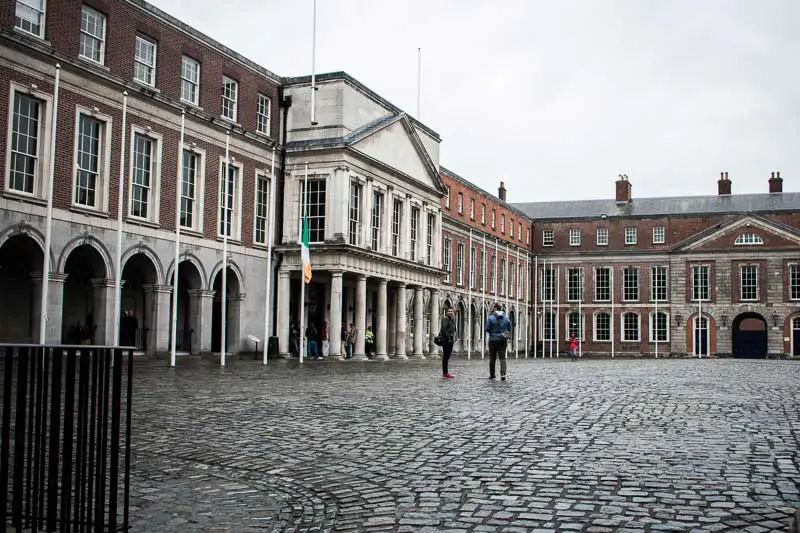
At the back of the Castle can be found the Dubh Linn Gardens , a landscaped haven of peace in bustling Dublin. It is also here you’ll discover the Chester Beatty Library . No doubt one of the best art museums in Dublin, the world renowned Chester Beatty Library is also free to visit. Your chance to take a peek at rare and richly decorated Bibles and Qurans dating back centuries ago.
E. City Hall
Next to Dublin Castle is the City Hall . Built in the 18th century, the building is a great piece of neo-classical architecture. City Hall holds temporary exhibitions and access is free.
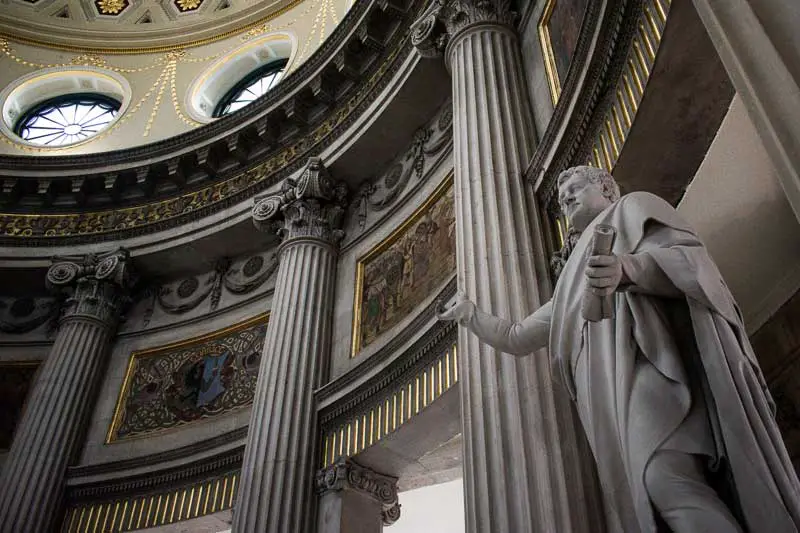
F. Christ Church Cathedral
Five minutes away is Christ Church , Dublin’s oldest cathedral. Extensively restored in the 1870s, it is an interesting mix of 12th-13th century architecture and Victorian Gothic features. Entrance is not free. If you decide to spend some time here, the guided tour will give you the opportunity to ring the bells in the belfry. Cheaper, you can also book a self-guided tour with audio guide (different languages available).
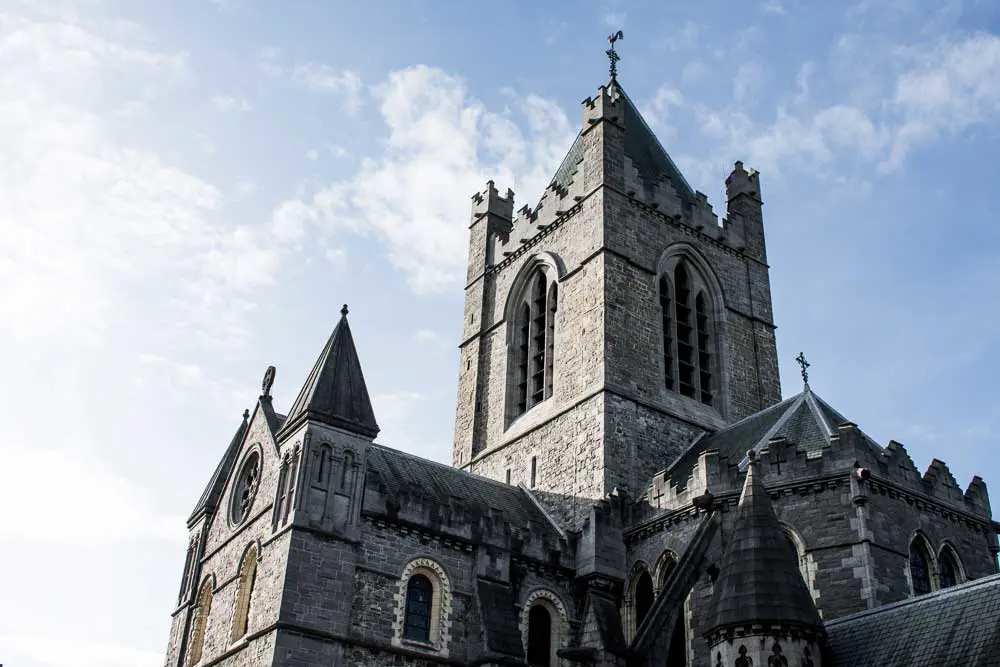
In the Synod Hall of the Cathedral across the bridge is Dublinia , a museum dedicated to Viking and Medieval Dublin that commands the access to the medieval St Michael’s Tower. Entrance is with ticket only.
G. Saint Patrick’s Cathedral
Located 5-10 minutes down St Patrick’s Street, Saint Patrick’s is Dublin’s second cathedral. Jonathan Swift, best known as the author of Gulliver’s Travels, is buried under its floor. He was Dean of the Cathedral from 1713 to 1745. Tickets must be purchased to enter the edifice.
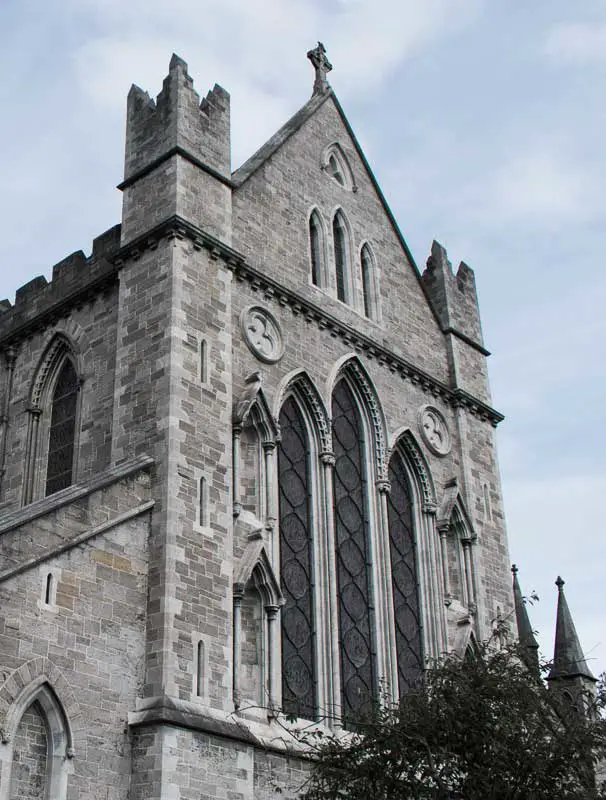
Adjacent to the Cathedral is the picturesque St. Patrick’s Park created in 1901 by Sir Edward Guinness. Around the corner from the Cathedral down St. Patrick’s Close can be found the Marsh’s Library . One of Dublin’s oldest libraries , the Marsh’s Library is a perfectly preserved 18th century library.
H. George’s Street Arcade
This walking itinerary will now take you back to the heart of the city.
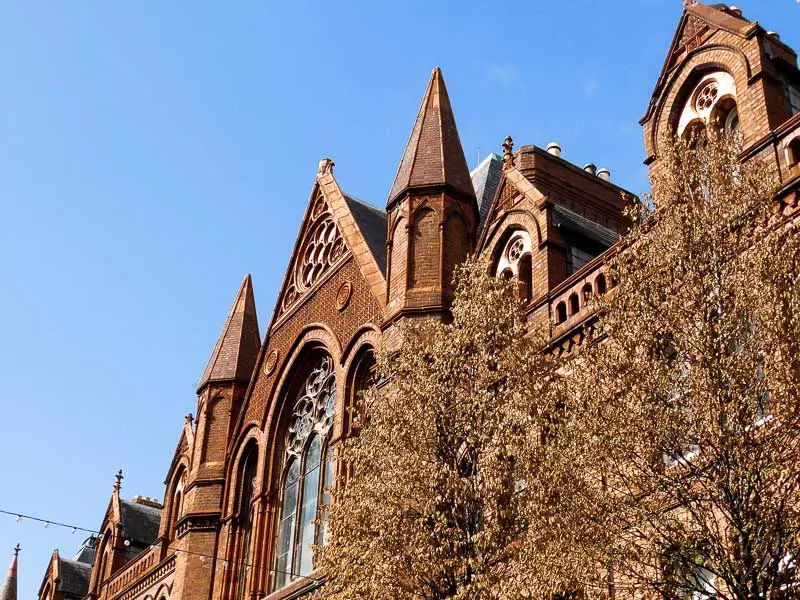
One of Europe’s oldest shopping centres, George’s Street Arcade is a Victorian indoor market home to an eclectic range of stores, stalls and cafés. Visit its vintage shops or browse drawings from local artists. Discover the unexpected in George’s Street Arcade.
I. Powerscourt Centre
In the heart of the Creative Quarter, Powerscourt Centre is a beautiful townhouse elegantly transformed into a shopping centre. Discover designer and craft shops, antique Irish brooches and rings including the famous Claddagh ring , or just take some time to relax with a coffee.
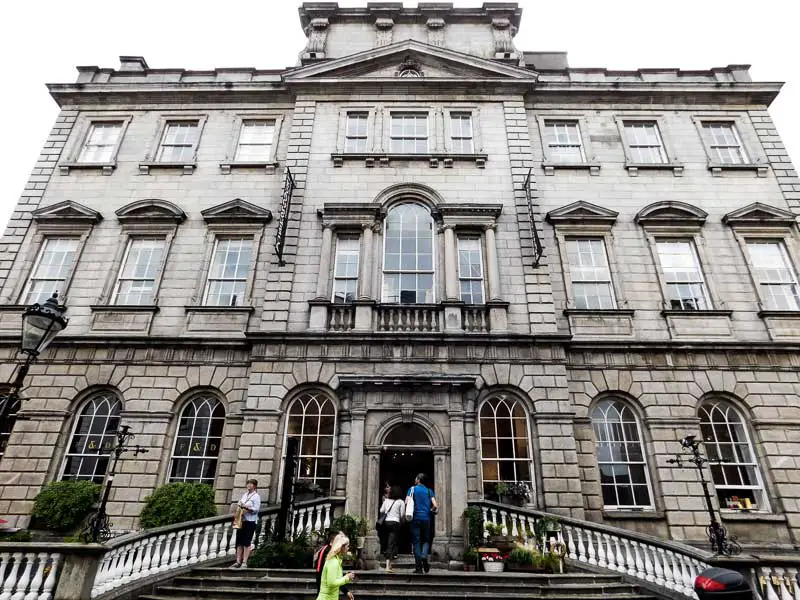
Wander through the streets of the Creative Quarter for more independent stores with locally made products and some of the best Irish craft and souvenir shops in Dublin .
J. Grafton Street
You’ve reached Grafton Street , Dublin’s main shopping district. This pedestrian-only street is home to many high-street brands, from Vans to Victoria’s Secret. On sunny days, Grafton Street is taken over by buskers and inventive entertainers. Talented or not, that’s up to you to decide!
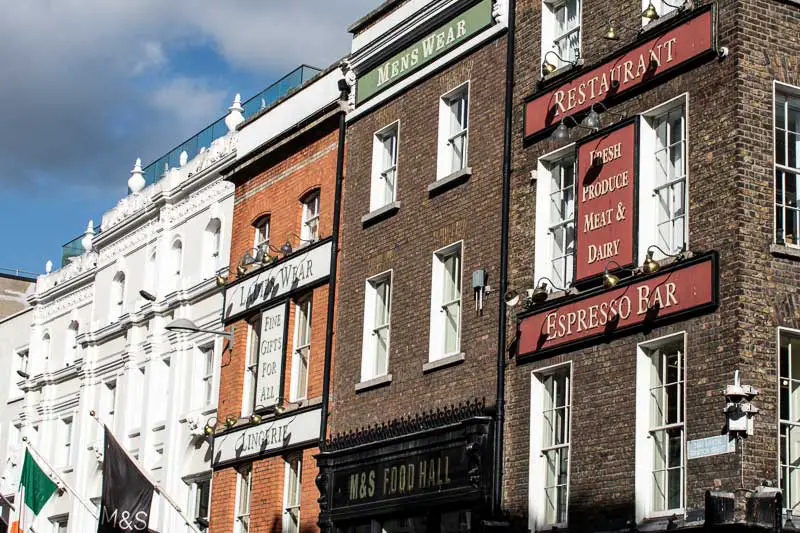
At Grafton Street’s far end sits Stephen’s Green Shopping Centre . Its impressive architecture of glass and steel should convince you to have a peek inside. Across from it can be found the Gaiety Theatre . Every summer, the Gaiety welcomes a world-renowned show: River Dance.
Feeling hungry or tired? Time to get some energy back before exploring further. Cafés and restaurants abound in Grafton Street and nearby side streets. Eat a sandwich on the go, sit on a terrace for a coffee and light bite, or enjoy comforting pub food. There’s something for every taste in and around Grafton Street.
Self-Guided Walking Tour of Dublin – PART 2
Now that you have rested your feet for a little while, let’s get back to our walking tour of Dublin .
A. St. Stephen’s Green
St. Stephen’s Green is Dublin’s largest Georgian garden square and one of the most popular public parks in the city. Donated by Sir Arthur Guinness to the people of Dublin in the 19th century, St. Stephen’s Green has been a respite from the bustling city ever since.
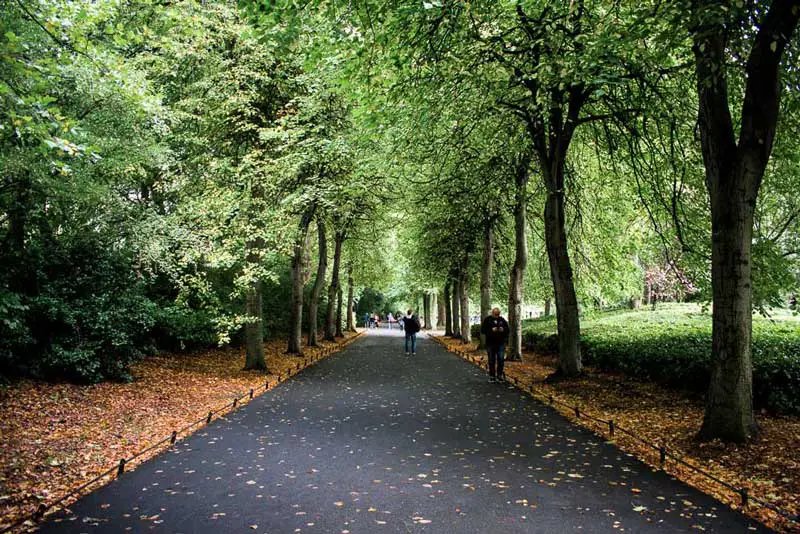
Across from St. Stephen’s Green, you might spot a 300-year-old cemetery on Merrion Row. Established in 1693, it was the burial ground for French Huguenots in Dublin , who fled religious persecution in France.
B. Merrion Square
With elegant Georgian townhouses lined up all around it, Merrion Square is considered Dublin’s finest Georgian garden square. Among other notable residents, famous writers Oscar Wilde and W.B. Yeats lived in those desirable homes, as well as Irish political leader Daniel O’Connell.
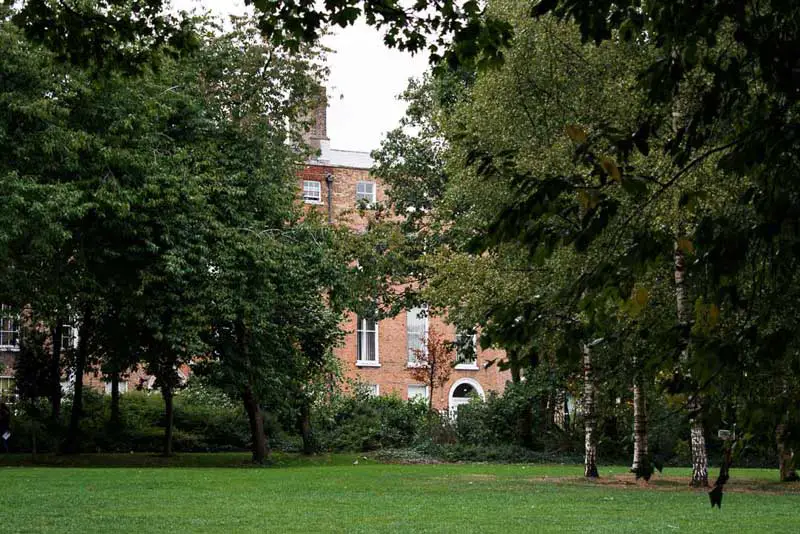
Only open to the public since the 1960s, it is worth wandering around the garden’s well maintained alleys and manicured lawns until you bump into the great Oscar Wilde himself resting on a rock.
Behind a secured gate, Leinster House and the Government Buildings can be observed at a distance from Merrion Square. If you fancy a breath of culture along your walking tour, the National Museum of Ireland and the National Gallery both have their entrances around the corner. If you are visiting the city on a budget, these free Dublin museums have to be on your do-list!
C. Trinity College
Enter Trinity College through Nassau Street. Founded in 1592 by Queen Elizabeth I, Trinity College is Ireland’s oldest surviving university and its most prestigious. You can roam the grounds freely and observe the elegant architecture of its oldest buildings harmoniously arranged in squares.
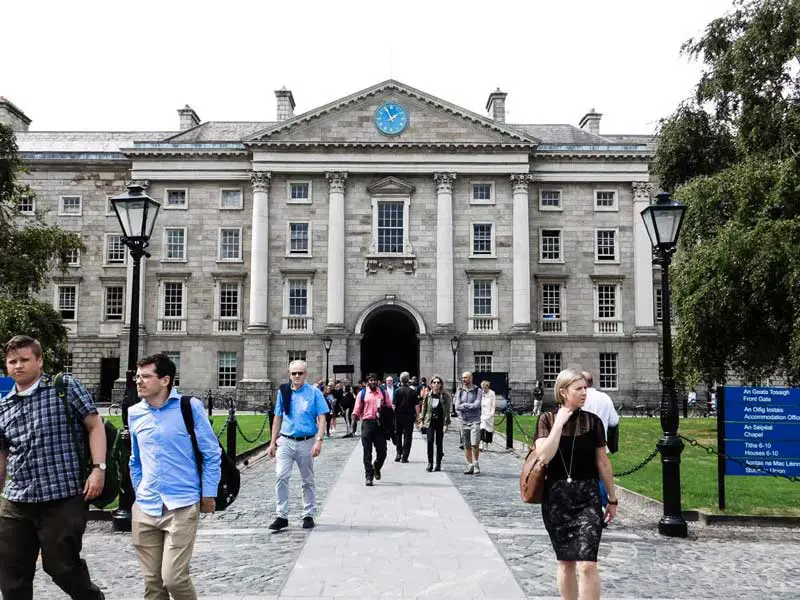
Tours are available from the main entrance on College Green, though not offered all year round. If you have some spare time, visit the Old Library (tickets only) that hosts an exhibition of the famous Book of Kells , an illuminated manuscript believed to date back to the 9th century. The Long Room with its spectacular vaulted ceiling is a must-see masterpiece.
D. Molly Malone
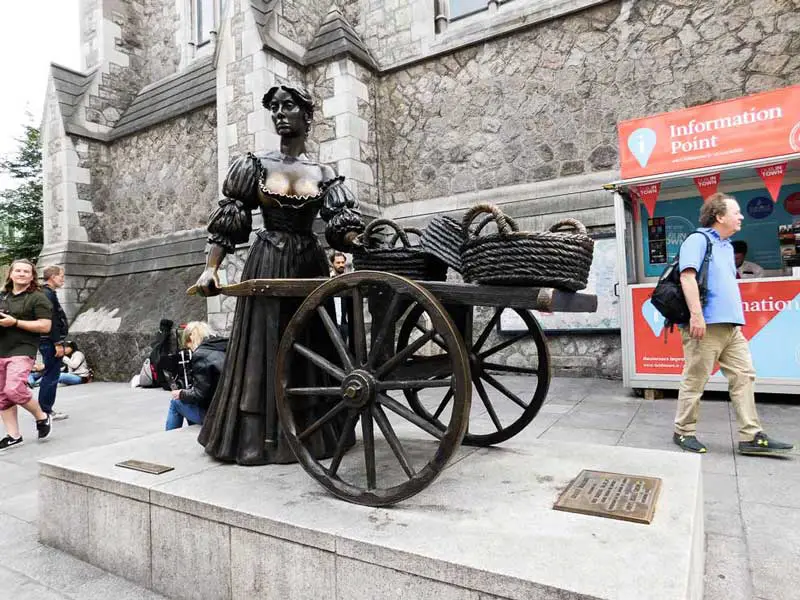
End your self-guided walking tour in front of St Andrew’s Church in St. Andrew’s Street where the statue of Molly Malone is now located. Molly Malone is a fictional fishmonger rendered famous by a popular song of the same name. The song has become the unofficial anthem of Dublin and ending a tour of the city without paying your respect to Molly Malone could be perceived as rude.
Guided Tours for the History Enthusiast
Self-guided tours are great. You can go at your own pace and decide where and how you want to spend your time.
But if, like me, you like learning about the history and interesting anecdotes of the place you visit, why not book a guided tour with someone knowledgeable?
Check out the recommendations below!
Where to Stay in Dublin City Centre
To make the most of your day, I recommend staying in the city centre to allow for an early start. Here are some recommendations of top-rated hotels with the perfect location:
- O’Connell Street: The Gresham
- Ha’Penny Bridge: Zanzibar Lock
- Temple Bar: The Hard Rock Hotel
- Grafton Street: The Westbury Hotel
- Merrion Square: The Alex
Click here for more options, or read the latest reviews on Tripadvisor . Dublin can be very pricey, especially in the summer months. Always book early to get the best deal.
I hope you will enjoy this self-walking tour of Dublin and you will get to see as many sights as possible in just one day. There is so much to see that you might want to come back and explore Dublin even more. Hopefully this Dublin city guide will give you more ideas of things to do during your next visit to this wonderful and lively city.
Disclaimer: This post may contain affiliate links. If you click on a link, I earn a little money at no extra cost to you.
RELATED POSTS
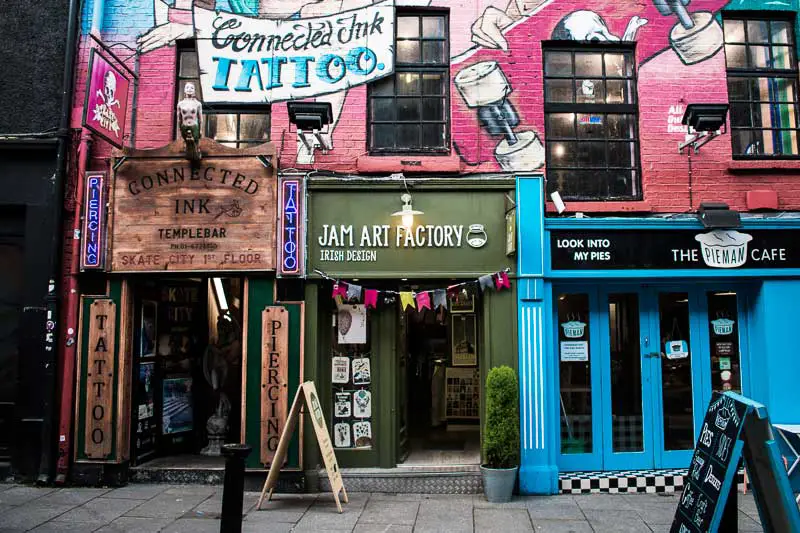
Top Things to Do in Temple Bar, Dublin, That Are Not Tourist Traps
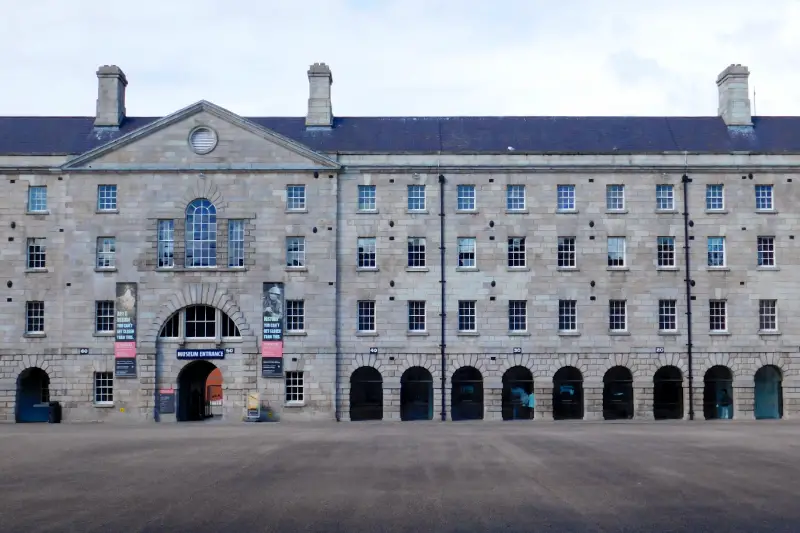
The Best Free Museums in Dublin You’ll Want to See
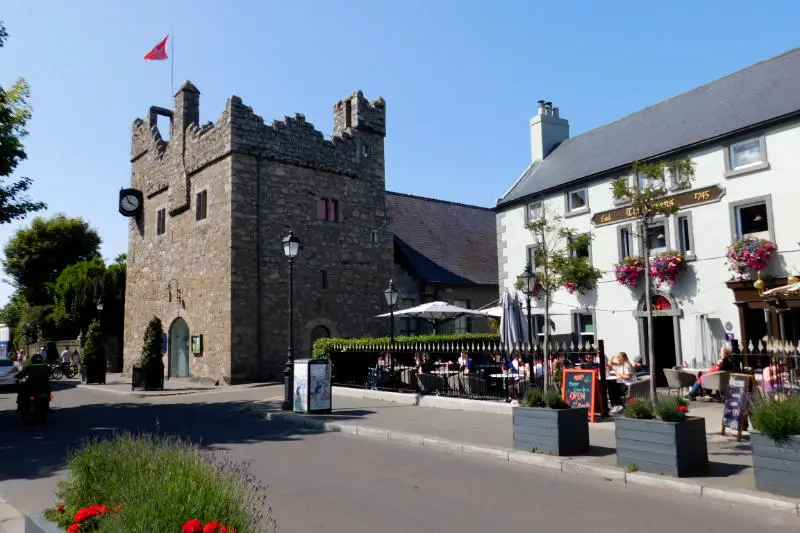
Beyond the Cityscape | The Best Seaside Towns Near Dublin
Leave a reply cancel reply.
Your email address will not be published. Required fields are marked *
Save my name, email, and website in this browser for the next time I comment.
You cannot copy content of this page

Epic Dublin Self Guided Walking Tour
Top 50 attractions on three dublin self guided walking tour, walk 2 – top 16 attractions, guide to temple bar region just south of the river liffey, dublin.
- Dublin Self Guided Walking Tour Walk 1 – Top 18 Attractions, guide to Dublin City Center , North of the River Liffey Dublin, Click HERE
- Dublin Self Guided Walking Tour Walk 3 – Top 16 attractions, guide to Historic Dublin , Click HERE
Use the Dublin Self Guided Walking Tour below to visit the attractions in Dublin that are south of the River Liffey. A complete self guided walk, map and guide to Dublin attractions, including Trinity College, Book of Kells, Statues and Squares. Follow the Dublin Self Guided Walking Tour in black below, to explore the city at your own place. Spend a few hours or two days depending on how you want to complete all three walking tours and how long you want to spend at each attraction. There are three separate Dublin Self Guided Walking: Tour 1- Downtown Central Dublin located north of River Liffey, Tour 2 – Temple Bar Region, St Stephens Green and Grafton Street located south of River Liffey and Tour 3 – Historic Dublin includes Dublin Corporation, Dublin City Hall (and includes parts of the Temple Bar Region)
Dublin Self Guided Walking Tour 2 – Start at Merchants Arch. Break after the walk or you may want to take a break on Grafton Street and then continue onto Dublin Self Guided Walking Tour 3
Download the INTERACTIVE Dublin Self Guided Walking Tour map of Temple Bar Region HERE
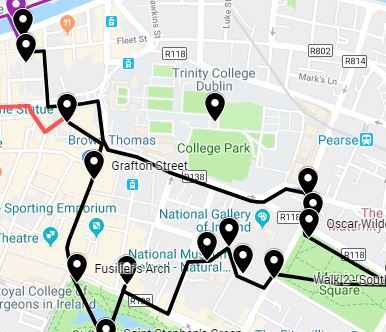

Download PDF Dublin Self Guided Walking Tour and Map of Temple Bar Region Map HERE
Start dublin self guided walking tour 2, 1. merchants’ arch, temple bar: temples bar food market.
Start the Dublin Self Guided Walking tour at Merchants Arch which connects Liffey Street with the Temple bar Area. Walking through the arch you will find vendors, buskers and businesses. Established by an Act of Parliament in 1757, it was seen as a necessary thoroughfare creating a network of streets. The Arch is sometimes viewed as a rundown passage; note the coat of arms above the arch. The Arch is part of Merchants Hall in 1820. Established in 1821, it was once the Merchant Guild Hall and only one of two 19 th century buildings still in use in Dublin.
The Merchants Guild Hall representing almost guilds in existence at the time including a Tailors Guild, A Bricklayer’s Guild, A Weavers’ Guild a Carpenters’ Guild, a Millers’ Guild, a Goldsmiths’ Guild. The guild of Barber-Surgeons’ and Apothecaries and the Cooks and Vinters Guild, etc. The Merchants Guild was eventually disbanded and the building was repurposed as a poplin shirt factor and a protestant boy’s school. The archway was home to a shoe and boot repair company, booksellers, bric-a-brac stores, antique stores and a secret IRA munitions factory.
2. Temple Bar Region – Leo Burdock Fish and Chips since 1913
It is located in the Temple Bar Region . Its a nice lunch spot and break from the Dublin Self Guided Walking tour. It is named after the son of the original owners Bella Burdock and Patrick Burdock, the popular fish and chip shop has expanded to other locations. Initially Patrick, with his son Leo, would head by horse and cart to the Dublin Fish markets at 5am to get the catch of the day, and pick up potatoes and coal for heating the pans to prepare the fish and chips. It’s been visited by tourists, Dubliners and famous celebrities from around the world. Check their wall of fame
The Tourist Information Center is across from LeoBurdocks, just at the corner
3. Trinity College
It is Ireland’s oldest university and one of the seven ancient universities of Britain and Ireland. Adam Loftus, Archbishop of Dublin requested a center of higher learning from Queen Elizabeth I as Ireland did not have one while Britain had several. Granted by the Queen to solidify its commitment to Ireland, the college was founded by Queen Elizabeth I in 1592 and was modelled after Oxford and Cambridge. Trinity College officially the College of the Holy and Undivided Trinity of Queen Elizabeth, is commonly referred to as University of Dublin or Trinity College
Located outside the city walls of Dublin in the buildings of the banned Catholic Augustinian Monastery and Prior of All Hallows. As the city grew, the college eventually became part of the heart of the city. Catholics were admitted in 1793 with restrictions, including not being able to obtain prominent positions such as becoming fellows, professors or scholars. An Act of Parliament lifted these restrictions in 1873. Women were admitted to the college in 1904
Graduates of the 47 acre, 400-year-old college include Archbishop Loftus, Oscar Wilde, Robert Emmet who led a rebellion against British rule in 1803, Samuel Beckett, and the former Irish president, Mary Robinson.
Today Trinity College is an educational campus to 17,000 students and a tourist attraction visited by over 2 million tourists a year. Ireland’s political, cultural, architectural and literary history is laid bare in the campus grounds and buildings. This is another great spot to take a break from the Dublin Self Guided Walking tour and explore the college.
4. Trinity College Old Library: Library
The Old Library was established in 1801 and has at least one copy of every book published in Ireland. As a legal deposit library, it has an inventory of 5 million books, many are in the ornate library, and others are held offsite and need to be ordered in
The Old Library is home to a number of documents attesting to Ireland’s political and cultural history. You will find the Trinity College Harp from the 14 th century and used in Irelands Coat of Arms and the last remaining copy of the Proclamation of the Irish republic, which changed the course of Irish history during the Easter Rising of 1916. Yuu will need tickets to enter.
5. Trinity College : Book of Kells
While the university shelves have many of the rarest and oldest books in its possession, none is more famous than the Book of Kells . The Book of Kells, also known as the Book of Columba, is a 680 page Latin manuscript from 800AD that contains four gospels of the New Testament from an unknown origin; It was created in a Columban monastery in Britain or Ireland and brought by 9 th century Scottish monks to the Kells Abby in Meath. It has survived raids by the Vikings, dissolution of the Kells Abbey in the 12 th century and the invasion of Ke lls by Oliver Cromwell in 1654. After this, it was sent to Dublin for safekeeping and was presented to Trinity College in 1661. Two of the four volumes are displayed at a time and every day one page of the book is turned over by the librarian. The illuminated book is a popular tourist attraction. Keep in mind that the line up to visit this attraction on the Dublin Self Guided Walking tour is long
You can find a digital copy HERE :
Trinity college : fun facts and myths.
- If you pass under the bell tower while it is tolling, you will fail your final exams
- Graduating students walk under the bell tower on graduation day as a rite of passage
- The Book of Kells is free to view for students of the college
6. Sweny’s pharmacy
A unique attraction on the Dublin Self Guided Walking tour. It was opened in 1847 as a doctor’s office that included an apothecary and over time a pharmacy. The business gained fame when it was featured in James Joyce’s novel Ulysses. Maintained by volunteers, it is no longer a working pharmacy and is largely preserved, mostly through neglect.
7. Several attractions from Dublin Self Guided Walking tour located in Merrion Square
It is an attractive park on the south side of Dublin that retains its Georgian character. Surrounded on three sides by red brick Georgian town houses and closed off by the Duke of Leinster’s palace, Leinster House that is Ireland’s Parliament is located here. Adjacent to Leinster House is the National History Museum and the National Gallery of Ireland. The Square was developed in 1752 and was a private park with beautiful gardens that were accessed through a locked gate for the residents only. In 1960, the square was donated to the Dublin Corporation, City of Dublin, and opened to the public. It was named Merrion Park in 2010.
Georgian Residences on the Dublin Self Guided Walking tour:
The Georgian townhouses surrounding the park were built over 30 years and had to adhere to the strict design styles. They were home to famous Dubliners including:
- 1 Merrion Square – Home of Oscar Wilde
- 58 Merrion Street – Home of Daniel O’Connell
- 71 Merrion Street – Home of fasion Designer Sybil Connoly
- 82 Merrion Square – Home of poet W. B. Yeates
Many of the residents sold their townhouses and moved to the southside. The townhouse were then converted to business such as No 63, the Royal Society of Antiquaries however some still retain their residential status and are occupied as homes
The park is a popular spot for students from nearby Trinity college and Dubliners and tourists who want to take a peaceful break from the hustle of the City. Street food vendors setup during lunchtime and markets pop up every so often. There is a playground for children and washroom facilities are free at the nearby National Museum
8. Merrion Square Park, Oscar Wilde Statue
Nickname Queer with a Leer or Fag on the Crag
The statue is located close to his home on Merrion Square in the Georgian Quarter which can be found on the Dublin Self Guided Walking map. Oscar was married at one time, however his open homosexuality led him to spend some time in the English prisons and he wrote one of his most famous poems titled “The Ballad of Reading Goal.” He was released in 1897. An Irish playwright and Dubliner known for the famous play “The Importance of Being Ernest.”
9. National Museum of Ireland – National History Museum
The History museum opened in 1857, a mere two years before the publication of Charles Darwin’s “The Origin of the Species”. The museum, also referred to as “Dead Zoo”, is part of the National Museum of Ireland and has over 2M specimens. Is one of the world’s greatest collections, They are displayed in a charming atmosphere with creaking wood floors and glass cabinet display cases. The exhibits include a display of insects, wildlife and extinct animals
What to see in the Natural History Museum
- The Irish Room – Sea animals, birds and mammals
- World Animal Collection – 20m whale, chimpanzee, gorillas and human skeletons
- Discovery Zone – extinct animals such as the Tasmanian Tiger, as well as panda, and rhinoceros
- Blaschka Collection – Glass models of marine animals by the Blaschka family
10. National Museum of Ireland – Archaeology Display
This is the archeology wing of the national museum of Ireland on Kildare Street. The exhibition consists of prehistoric Celtic and Medieval artifacts, a stunning gold exhibition and Church treasures. The exhibit includes well-preserved bog bodies believed to be sacrificed by the various kings according to Celtic traditions. The bodies dating as far back as the iron age were exhumed from the Irish midland peat bogs. The remarkable preservation includes fine details such as fingernails, tangled hair and sinewy limbs
Walking through the museum is a lesson in history of:
- Irelands Viking settlements, some from the excavations of Wood Quay in Dublin
- Medieval Ireland’s establishment of churches and castles
11. Leinster House
Leinster House is the home of the National Parliament of Ireland. Construction started in 1745 and was completed in 1748 by James, Earl of Kildare. His residence was far from the aristocratic residences located at the time north of the Liffey. The house was the Earls official residence in Dublin. Originally called Kildare House, it was used as a model for the current White House in the US. Leinster House was sold in 1815 to the Royal Dublin Society (RDS) by the 3rd Duke of Leinster. At that time two new wings were added, the national Library of Ireland and the National Museum of Ireland. You can tour the site, information is located HERE
12. Little Museum of Dublin
The next stop on the Dublin Self Guided Walking tour is the Little Museum of Dublin. It is in the heart of downtown, the museum shows the history of 20th century Dublin. The museum is in an 18th century Georgian townhouse owned by the city. It has over 5000 pieces on display spread over three floors and an Irish style cafe in the basement. It has won awards and is a popular place with over 50,000 visitors a year
The museum has a Tourist Greeter program called “City of a Thousand Welcomes”. It is a civic initiative that connects tourists with a local. S/he will take connect with you over a pint, tea or coffee where they will tell you about the city. It’s a popular free program, you can register for it HERE
13. St Stephens Green
The park was built on marshy land at the edge of the city and used mostly for animals to graze free. To raise much needed funds, in 1663 the government cordoned off the area and sold the surrounding area where developers built houses for the wealthy. The cordoned off area became a garden for the wealthy who lived in the area. The Guinness family were pursued to redesign the gardens as a park and open it to the public. As a way of thanks a statue of Sir Alec Guiness, in his honor is found in the park. The Victorian park was reopened in 1880 by Lord Ardilaun, Sir Edward Guinness, 1st Baron Ardilaun . It was named St Stephens Green after the St Stephens church and leprosy hospital located here in the 13th century.
During the 1916 Easter Uprising, the park was a battleground complete with trenches between the Irish Citizens Army and the British Army . Ceasefires were called to allow the workers to feed the ducks in the pond. Today the 22 acre park has 3.5 km of pathways, a distinct herbaceous border and a man made lake for waterfowls. The park is a peaceful sanctuary in the inner city. There are a number of statues representing important Irish historical figures and events, a waterfall, a playground, a garden for the visually impaired, public toilets and free lunch time concerts during the summer months
14. Dublin Self Guided Walking tour attractions at St Stephens Green Monuments Include:
- The Fusiliers’ Arch dedicated to the men who fought in the second Boer war. The arch is located at the entrance to Grafton Street
- A memorial to the Great Famine of 1845 by Edward Delaney
- A seated statue of Sir Edward Guinness, known as Lord Ardilaun who donated the land to the city
- A fountain with a bronze statue of three women donated by the German people for fostering 500 German children during WW2. The campaign was known as operation shamrock
- A statue of the famous sculptor Henry Gates, located in the yeats memorial garden. The garden was dedicated to the famous Irish poet William Butler Yeats
- A statue of Jeremiah O’Donovan Rossa, leader of the Irish Republican Brotherhood in support of an Ireland independent of Britain. His statue is near the Grafton Street entrance
- A bust of Irish literary giant James Joyce. It faces his alma matar Newman House
- A statue of Robert Emmet, Irish patriot and nationalist rebel leader. He is standing across from his now demolished birthplace at no 124 St Stephens Green
- A statue of Countess Markievicz, an Irish nationalist politician who took part in the 1916 Easter Uprising. She was sentenced to death but the sentence was later commuted due to her gender. She was first women in the world to be elected and held a cabinet position, Minister of Labour, in the British government from 1919 -1922
- A bronze statue of Theobald Wolfe Tone , the leader of the Irish Rebellion of 1798 is on the Merrion Row corner
15. Grafton Street – Rest stop or shopping stop on the Dublin Self Guided Walking tour
Exit St Stephens Green from Fusiliers Arch and walk up Grafton Street. One of the most expensive shopping street in the world it is one of two shopping streets located in Dublin City center. The other one being Henry Street. Grafton Street is named after the Lord Lieutenant of Ireland and illegitimate son of Charles II of England, 1 st Duke of Grafton, Henry Fitzroy. In the 19 th century, it was famous for the number of prostitutes that worked on Grafton Street, numbering about 1,500. Grafton became a pedestrian street in 1971 and by 1983 the pedestalization was complete. It was repaved in 1988 and transformed into a high-end shopping area.
Today Grafton street is a popular tourist attraction in the Irish Capital with shopping, pubs, restaurants, vendors, street entertainment and buskars. The streets are narrow and the crowds are huge leading to a cozy, bustling atmosphere of Dubliners and tourists. You can enter Grafton street at one end starting at Stephens Green, meander through the streets and exit at the entrance to Trinity College.
After the Walk – Might be a good time to take a break – Grafton Street
Mcdaids pub on harry street.
McDaids just off Grafton Street is an old Irish pub where I hear the best Guinness in Town is served. Sit at at the bar and chat with the bartender for an authentic Irish experience. I stop by hear whenever I am in town and have never been disappointed. The bar is located across from Phil Lynotts’ statue
16. Molly Malone Statue – last stop on the Dublin Self Guided Walking tour
Nickname Tart with a Cart” or Dish with the Fish
Continue on Grafton Street to Suffolk Street to the Mary/Molly Malone Statue. Erected in 1988, on the corner of Grafton and Suffolk street is the Molly Malone statue. The statue is a tribute to the famous Irish song “Cockles and Mussels”. Legend has it that there was an actual Molly in the 17 th century who peddled goods in a cart in the daytime and was a prostitute in the evenings. There is no corroborating evidence of this however in 1988, the Dublin Commission endorsed the claim that there really was a Molly Malone born on June 13, 1699 and proclaimed June 13 as Molly Malone day. Il
Additional Ireland Attraction Guides:
- Getting around Ireland – Using Public Transportation in Ireland
- Cliffs of Moher – A very popular tour, a complete guide to the 16 attractions along the Cliffs of Moher Coastal Walk
- Doolin – A quaint popular village in County Clare. Stop overnight and walk to the Cliffs of Moher from Doolin or enjoy the many other attractions in and around Doolin
- The Ring of Kerry – A spectacular 111 mile scenic route on the Iveragh Peninsula. Start at either Kenmare or Killarney for a circular route of three hours without stops. Jaw dropping views of the Atlantic ocean, charming villages and wild sweeping mountains makes this a popular must see attraction in Ireland. Use the map and attractions for the complete self guided tour of the Ring of Kerry
- The Dingle Peninsula – It is a 30 mile long clockwise loop that takes about 4 hours to complete. The area is the bedrock of Irish culture with signs in many villages and towns indicating that Irish is the predominant language in the area. The picturesque landscape includes rolling hills, craggy shorelines and sandy beaches. The PDF map and attractions guide explores the attractions of the Dingle Peninsula
- The Ring of Beara – An 85 mile circular route, similar to Ring of Kerry and Dingle Peninsula, however it is far less travelled. In that sense, it is a better drive as there are far less cars on the road. I found the Ring of Beara far more dramatic than either the Ring of Kerry or the Dingle Peninsula. It is not as popular because the tourist buses are not able to navigate the narrow roads with hairpin bends or the Healey Pass.
- Dublin Walk 1 – Top 18 Attractions, guide to Dublin City Center , North of the River Liffey Dublin
- The Book of Kells and Trinity College in Dublin. Trinity College is the oldest university in Ireland with the historic Long Room,and the old library with over 200,000 of the very old books. It is the most impressive library in the world
- In Dublin visit the Little Museum of Dublin, Grafton Street, St Stephens Green and Kilmainham Goal (the prison where many rebels from the Easter Rising were held before their execution)
- Dublin Walk 3 – Top 16 attractions, guide to Historic Old Dublin
- Galway – Use the Galway Ireland guide for a flexible and personal tour of over 40 attractions Galway City
- Aran Islands – For a truly authentic Irish experience visit the Aran Islands. They are located at the mouth of Galway Bay. You can catch a ferry from either Doolin or Rosseeval port (Shuttle from Galway to Rosseeval ferry port)
- The Glens of Antrim – Driving route for the nine Glens of Antrim in Northern Ireland. The guide includes options for public transportation, walking trails in The Glens and Game of Thrones Attractions
- Over 100 Northern Ireland Attractions – Visit over 100 attractions along the east and north coast of Ireland along the Antrim and Causeway Coastal Route. Travel by car or public transport from the Mourne Mountains to Londonderry. Includes game of thrones sites, castles and walks along the route
- The Burren – Explore the karst moonscape bedrock of The Burren located in the southwest region and close to the Cliffs of Moher. Attractions in the Burren include ancient tombs, underground caves, walks on an unusual landscape and The Burren National Park
Related Posts

Flight delay compensation, claim up to €600 in cash
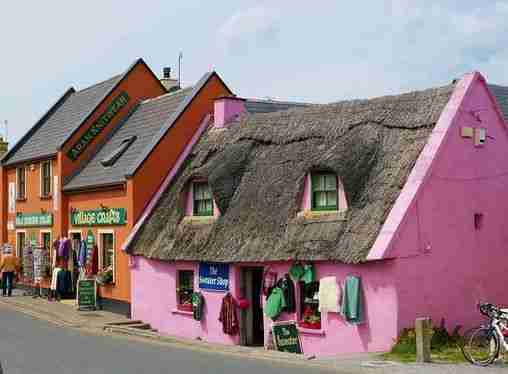
Doolin Ireland, Top attractions in Doolin
Dublin: A Walking Tour of the Main Sights
:max_bytes(150000):strip_icc():format(webp)/reflectivemood-56a3c66b5f9b58b7d0d3ad64.png)
Ready to explore Dublin on foot? Follow this guide to cover the compact Irish capital and see all of the main sights without needed to hop on a guided Dublin tour.
Starting Out on O'Connell Bridge
TripSavvy / Jamie Ditaranto
A walking tour of Dublin, self-guided, does it need a lot of preparation and map-work? Actually, it does not, as Ireland's capital is ideal for a leisurely stroll that will take in most of the top attractions too.
Most of the best sights of Dublin are situated in a comparatively small area. To get a good impression of this lively and historic city you only need to take a walk. And you can travel light as shelter from rain and refreshments can be found virtually everywhere. The whole tour of Dublin's Fair City should take anything between two and six hours - two hours for energetic walkers and without lingering too long at any place, six hours including stops, the Trinity College tour and a pause or two in a café. So put on your walking shoes and off we go ...
Start your walk on O'Connell Bridge, the nearest equivalent of a central place Dublin can boast. Reputed to be one of the only bridge in the world that is wider than it is actually long, this is the heart of Dublin, admire the view for a few minutes, then start walking up O'Connell Street . Cross over to the central reservation and have a good look at the O'Connell Memorial with its magnificent statues full of allegory. See an angel crushing a serpent, spot the faithful Irish wolfhound and notice some bullet holes. These were caused by gunfire during the fighting in 1916 and have never been repaired.
O'Connell Street and the General Post Office
Further statues and "The Spire of Dublin" await you—the latter was erected to mark the millennium and is also known as "The Stiletto in the Ghetto."
Of the impressive buildings on O'Connell Street, the General Post Office takes pride of place. This was the central fighting area of 1916 but has been lovingly restored - it is open to the public during daytime as it still is Dublin's GPO. Have a look around and maybe buy some commemorative stamps in the Philatelic Office. Then continue up O'Connell Street, past the trompe d'oeil Carlton Cinema and on to the Parnell Statue.
Charles Stewart Parnell is remembered more low-key than O'Connell but his monument is among the most beautiful in Dublin. Walk around it and read the names of all 32 counties ... including pre-independence "King's County" and "Queen's County". Carry on past the "Ambassador" (a former cinema converted to a rock venue) for a walk around Parnell Square. You will pass a small monument with a broken chain and an Irish inscription commemorating the founding of the nationalist Irish Volunteers in 1913 on your left.
The Garden of Remembrance and Moore Street Market
Continue towards the magnificent Presbyterian Church and reach the Garden of Remembrance . These were established to honor all the victims of the fight for Irish independence - at all times. The theme is mythical. The large pond, forming a cross, has representations of discarded bronze age weapons at its bottom. The focus of attention will almost invariably be on the massive statue showing the transformation of the "Children of Lír", an evocative and fitting memorial.
When you leave the Garden continue the walk by turning left and then left and left again, passing the historic (and still very busy) Rotunda Hospital and the low-key headquarters of Sinn Fein until you hit Parnell Street. Turn right and then left again into Moore Street , noticing how Dubliners have elevated jaywalking to an art form. Moore Street itself is a semi-pedestrian zone and a collision of Dublin old and new. Traditional street traders hawk their wares from barrows and you might jostle for a place with a horse looking for a snack. The modern ILAC-Centre is on your right, countless Asian, African and East European "supermarkets" are on your left. Smuggled tobacco and cigarettes are sold next to butchers who do a mean breakfast roll. Take some time to enjoy this truly cosmopolitan and colorful area and then take a right into Henry Street to see South Dublin's premier shopping street.
Ha'penny Bridge, Temple Bar and the Bank of Ireland
TripSavvy / Jamie Ditaranto
Now turn left into Liffey Street and walk down to the river of the same name. You will see the "Hags with the Bags" on your right just before having to cross the river using Ha'penny Bridge (officially "Liffey Bridge"). Dublin's most photographed river crossing was originally financed by a toll of one Halfpenny, hence the name. Today crossing is free.
On the south bank, a small (and sometimes very smelly) thoroughfare will take you straight into the "bohemian" Temple Bar area, the hub of Dublin's trendy nightlife. Assuming you will make this walk during the daytime you may wonder what the fuss is all about - especially in the mornings Temple Bar is near deserted. Most of the action would be in the streets to the right - have a look and judge for yourself whether to come back later.
For now, you may well walk straight on past the looming Central Bank until you reach Dame Street. Take a left here and walk to College Green. On your left is the stately building that once was Ireland's parliament and now is the Bank of Ireland - take a look at the slightly dated security measures including small cannons. The Irish parliament is known as the only democratic representation that voted itself out of existence, effectively accepting direct British rule at the start of the 19th century.
Trinity College and Environs
TripSavvy / Kathleen Messmer
Exactly opposite to the Bank of Ireland, the entrance to Trinity College can be found - do not, under any circumstances, attempt to cross the road without using the regulated crossings. Even hardened Dubliners only attempt this in utter desperation!
After the crossing, you will want to enter the inner courtyard of Trinity College through the arch. It will be a revelation - a wide-open space with the impressive campanile at its center awaits you. The effect can be stunning, so watch out for fellow visitors stopping dead in their tracks right in front of you. Also, watch out for the more daring students trying to cycle through the narrow entrance! Immediately after coming out into the open again you will be invited to join the tour of Trinity College for a fee of € 10. As this includes the entrance fee for the library and the Book of Kells it is a worthwhile option. Should you have no time or restricted funds just have a look around the college grounds and then exit through the same gateway again.
After leaving Trinity College and turning left you will have to brave throngs of people waiting to catch a bus. On your right, you will see a statue of Molly Malone in a very kitschy music hall style. Nearly every tourist has his or her photo taken here and some scurrilous street "performers" regularly frequent the site. Watching for a few minutes before continuing to Grafton Street can be very amusing.
Grafton Street, Stephen's Green and Merrion Row
Further on you will then find the pedestrian zone of Grafton Street, Dublin's "posh" shopping area. Do some window shopping but also have a look at the magnificent details to be found on the upper facades of the buildings themselves.
At the upper end of Grafton Street, some excellent buskers can occasionally be found performing on the streets for tips. Don't miss the life-size statue of Phil Lynott in a street to the right. The singer of "Thin Lizzy" was Ireland's rock hero long before Bono.
At the end of Grafton Street, the magnificent Stephen's Green Shopping Centre will dazzle you - the faux-Victorian metal and glass building holds dozens of shops plus a good food court and is the perfect place for a quick refresher.
Opposite the shopping center, you'll then notice the Fusilier's Arch, the grandiose entrance to Stephen's Green proper. Take a leisurely stroll through the park and also take in the surrounding areas. In the park, you will find a number of monuments, a garden dedicated to W.B.Yeats (won the Nobel Prize in Literature in 1923) with a cryptic piece by Henry Moore, a quaint lodge and numerous ducks on the lakes. You will also find shop assistants, office workers and students having their lunch al fresco .
Exit the park at the Wolfe Tone Memorial (commonly called "Tonehenge" for obvious reasons) in the northeast corner and then turn into Merrion Row. Here you will find the picturesque Huguenot Cemetery on your left and O'Donoghue's Pub on your right - where the seminal folk group "The Dubliners" started their rise to worldwide fame.
Merrion Square and Kildare Street
When you reach Merrion Street turn left and walk past the impressive Government Buildings, the Natural History Museum (the "Dead Zoo") and the National Gallery . You are now in the center of Georgian Dublin and near the Center of Irish politics. Merrion Square is on your right and in the northwest corner, the strange monument to Oscar Wilde is to be admired - opposite his childhood home. If you are feeling energetic take a stroll around the park, originally earmarked for construction of a cathedral. As the Catholic Church ran out of funds and steam for this project the park was presented to the citizens of Dublin. Today it hosts memorials, flowerbeds, pleasant walks and the buried remains of a bomb shelter.
From Oscar Wilde's statue carry on into Clare Street and then straight on to Leinster Street. At the corner of Kildare Street, the former Kildare Street Club can be admired - look at the curious carvings at the windows, from squirrels playing the lute to monkeys playing pool. Today the French Cultural Institute and the Heraldic Museum are based here. Walk up Kildare Street past the National Library and have a look at Leinster House and the National Museum . On a normal day, you will see protesters in front of Leinster house proclaiming worthy or simply bizarre causes. The gardai on duty seem to have seen it all and are usually visibly bored.
Dawson Street, Burgh Quay and the Custom House
Carry on up Kildare Street and at Stephen's Green take a right and then a right again down into Dawson Street. On your right Mansion House, the official residence of the Lord Mayor of Dublin is seen. A palatial building with the Dublin coat-of-arms on display and frequently used for official functions.
Walking on you cross the road at the bottom of Dawson Street and then bear left, following the footpath right past Trinity College, finally taking a right onto College Street. There you have to cross the street opposite D'Olier Street. Admire the gothic Pearse Street Garda Station to your right, the romantic D'Olier-Building in front and the charming bronze sculpture showing the way to the "Screen" cinema in-between. Walk down Hawkins Street towards the Liffey, passing the faux-Tudor building of the Dublin Gasworks on your left. At the end of the street, you will find a nice memorial to a policeman who died saving the lives of Victorian workmen trapped underground.
You are now at Burgh Quay and will have to bear right to walk downstream along the Liffey. Do not worry if the Liffey seems to flow in the opposite direction, this will be just a strong tide coming in. After a short walk, you will have a splendid view of the faithfully restored Custom House on the north bank of the river. Cross over to the Northside using the modern Talbot Memorial Bridge and you will see the International Financial Services Centre on your right, dwarfing the moving Famine Memorial just beside the river.
Back to O'Connell Bridge ... or Further?
From the bridge, you might also see the replica "famine ship" Jeanie Johnston lying at berth in the redeveloped Dublin Docklands to the right. Have a closer look if you like, then head back westwards (or upstream) along the quays, passing Custom House until you come to the unashamedly ugly Liberty Hall (the Trade Union Headquarters) and turn right. Tucked away under the railway overpass and facing Liberty Hall is a memorial to James Connolly, the Irish-American socialist who fought and died with his small Irish Citizen Army in 1916.
Near the tram tracks take a left turn into Abbey Street and you will be guided towards the Abbey Theatre - Ireland's national theatre founded by W.B.Yeats. Unimposing on the outside but still putting on top-notch productions, though the scandals of O'Casey's days seem to be truly a thing of the past. Just a few yards more will bring you to O'Connell Street and O'Connell Bridge is to your left.
Your walking tour of Dublin has ended.
If you still feel energetic (maybe after a coffee and some cake) you could hop on a LUAS tram going westwards. This will take you to the Four Courts, the National Museum in Collins Barracks and on to Kilmainham Gaol. You will also be able to see the sprawling Guinness brewery and could even walk up to the Phoenix Park .
Dublin in 1 Day Itinerary
Walking Through Dublin Along the Liffey
20 Best Things to Do in Dublin
How to Spend 5 Days in Ireland
How to Visit Dublin on a Budget
Dublin's Must-See Architecture
Dublin Guide: Planning Your Trip
Boston Irish Heritage Trail
Sightseeing on the Number 11 London Bus
20 Best Things to Do for Free in Dublin, Ireland
One Day Los Angeles Self-Driving Tour
Parks and Gardens in Central Dublin
Romantic Dublin, Ireland's Sights and Attractions
Merrion Square, Dublin: The Complete Guide
15 Best Pubs in Dublin
The 10 Neighborhoods You Need to Know in Dublin

Free & Self-Guided Dublin Walking Tour
By: Author Sophie Nadeau
Posted on Last updated: 4th January 2023
Categories Ireland , walking tour
Last Updated on 4th January 2023 by Sophie Nadeau
As the capital of the Emerald Isle, Dublin is a beautiful destination worthy of a stop-off on any European adventure. Filled with quirky coffee shops, plenty of museums, and oodles of culture, the city is best explored on foot over the course of several days. Here’s a free and self-guided Dublin walking tour you’ll want to follow by way of introduction to Dublin.

Self-Guided Dublin Walking Tour: Practical Advice, Tricks, and Tips
The brazen head, christ church cathedral, dublin castle, queen of tarts, ha’penny bridge, river liffey, trinity college dublin & the book of kells, national gallery, st stephen’s green, marsh’s library, st patrick’s cathedral & st patrick’s green, enjoyed reading this dublin walking tour pin it now, read it again later:.
While total walking time is less than an hour, I highly recommend setting aside at least a few hours to undertake the guided walk as there are plenty of things to visit and even more places to see!
While you’ll still experience plenty should you attempt this walk in under sixty minutes, you’ll likely want to enter into some of the attractions and snap some photos along the way. If it’s a rainy day in Dublin during your visit, that’s even more of a reason to make stops en route of this tour.
When it comes to stopping off for refreshments, Dublin has plenty of quirky and quaint coffee shops which are well worth a stop off in. Highlights along the way include Peacock Green & Co. (specialising in tea) and Queen of Tarts (whose sweet delights lie in the sheer number of cakes on offer) .
Meanwhile, the best time I have when it comes to dressing for the occasion is to wear flat and comfortable shoes, as well as bringing along a rain jacket or umbrella.
After all, Ireland isn’t known as the ‘Emerald Isle’ for nothing (all the green rolling hills are thanks to plenty of rain) and you’ll want some rainproof shoes if you’re planning to spend one day in Dublin or even a weekend in Dublin .
Walking time: 58 minutes.
Distance covered: 4.6 km

The oldest pub in Dublin, and indeed all of Ireland, can be found in the form of The Brazen Head, a drinking establishment dating all the way back to 1198. Historically, the tavern has seen plenty of events over the years.
After all, the pub is referenced in James Joyce’s iconic work, Ulysses, and Jonathan Swift (author of Gulliver’s Travels) is alleged to have drunk here at some point or another. In other histories, the pub was the meeting point for famous revolutionaries such as Robert Emmet and Wolfe Tone. Book now: Brazen Head and Castle City Tour.

Following your foray into Dublin’s oldest tavern, next up it’s a visit to the oldest Cathedral in the city. Located not far from the River Liffey and comprising of centuries worth of history, Christ Church Cathedral is one of those must-see Dublin attractions.
Complete with Ireland’s oldest copy of the Magna Carta in the expansive crypt, Christ Church’s history dates back well over a thousand years. Purchase your Christ Church Cathedral ticket here in advance.

Anyone familiar with Ireland will know that the country is characterised by its castles. But what you may well not know is that there’s a castle in the very centre of the Irish capital.
Now often used as the site of a wedding venue and conference hall, Dublin Castle remains a dramatic and imposing structure on the Dublin skyline. It’s also possible to visit the interior of the castle for a fee, though of course, its exterior can still be admired for free! Book now: fast-Track Access Book of Kells and Dublin Castle Tour.

If you’re on the lookout for some good coffee and even better cakes, then the Queen of Tarts offers all this and more. Founded by sisters Regina and Yvonne Fallon, who first trained as pastry chefs in NYC, they have been in business selling sweet treats across two locations in Dublin since the late 1990s.
Today, the Queen of Tarts makes for the perfect rest stop in the middle of this Dublin Walking Tour to enjoy delicious coffees and even better cakes. While ordering be sure to bear in mind that while the sweets are on the pricier side of things, the portions are incredibly generous and you’ll be full after just one slice of cake!

As the most famous of all of Dublin’s, if not all of Ireland’s, pubs, the Temple bar merits a visit on any trip to the city, if only to pass by and snap a quick photo. While the pub is lively during the day, it truly comes to life at night when the whole place is lit up by a thousand twinkling lights and the sound of live music is continuously drifting out the ever-open door…

So-called because once upon a time travellers had to pay half a penny in order to cross the murky waters of the River Liffey below, no cityscape of Dublin would be complete without a nod to the Ha’Penny Bridge.
First constructed as a pedestrian walkway in 1816, should you choose to cross the bridge today (for free) on the other side of the river you’ll find the Winding Stair (one of the best bookshops in Dublin), as well as the National Leprechaun Museum.

Wending its way through the city centre, should you opt to wander along the River Liffey you can expect to find the traditional Irish architecture of Dublin reflected in the waters below. In Irish, the waterway is known as ‘An Life’ and is referenced in plenty of great literary works and songs, including, of course, Ulysses.

First founded by Queen Elizabeth I in the 16th-century, today Trinity College remains one of the most prestigious seats of learning in the Irish capital. While the grounds are open, free to visit, and definitely worth a peek around (especially in cherry blossom season when the magnolias are in full bloom).
Trinity College Library is one of the most beautiful sets of bookshelves in Europe. A visit to Trinity College Library also includes the chance to peek a glimpse of the Book of Kells, the most important medieval manuscript in Ireland.

Ireland has four national museums, three of which are located in central Dublin. Free to visit, the Irish capital locations feature museums on Archaeology, the Decorative Arts and a spectacular Victorian architecturally designed Natural History Museum.
Elsewhere in the Irish capital city, not far from Sweny’s Pharmacy (a 19th-century pharmacy which has since been transformed into a bookstore), the National Gallery is also free to visit and houses some of Ireland’s greatest masterpieces.

If you’re looking for a great picnic spot surrounded by coffee shops and the place where all the locals hang out, then you simply must head to St Stephen’s Green, a public park in the very heart of the city.
Opened to the public in the late 19th-century, it first started out as a grazing common on the fringes of the city. Today, the green space is filled with landscaped gardens, ponds, and is a real oasis of calm in the middle of the hustle and bustle of everyday city life.

While everyone has heard of the ornate library of Trinity College Dublin, few know about the rather secret spot of Marsh’s Library . Tucked away behind St Stephen’s Cathedral and a solid wrought iron gate, you’ll find the unique Dublin Gem.
Marsh’s Library is where Bram Stoker (author of Dracula) once studied and where Jonathan Swift (writer of Gulliver’s Travels) would sit, research, and read. Today, the centuries-old shelves are not only one of Dublin’s best-hidden attractions, but one of the best-kept secrets of Ireland . If you choose just one paid attraction to visit while in Dublin, I would say that a trip inside Marsh’s Library is well worth the entry fee of a few euros.

Dublin’s other cathedral is tucked away, a short distance from the city centre. While you must pay to enter, the cathedral’s Park is completely free to spend time in and is a source of joy to flower lovers come springtime when the air is perfumed by the scent of dozens of hyacinths.
St Stephen’s Green is a great place to end this Dublin Walking Tour as once there you can simply sit, relax for a little while, and soak up all the history you’ve just strolled through.

This site uses Akismet to reduce spam. Learn how your comment data is processed .

Velvet Escape
go explore. experience. and be inspired.
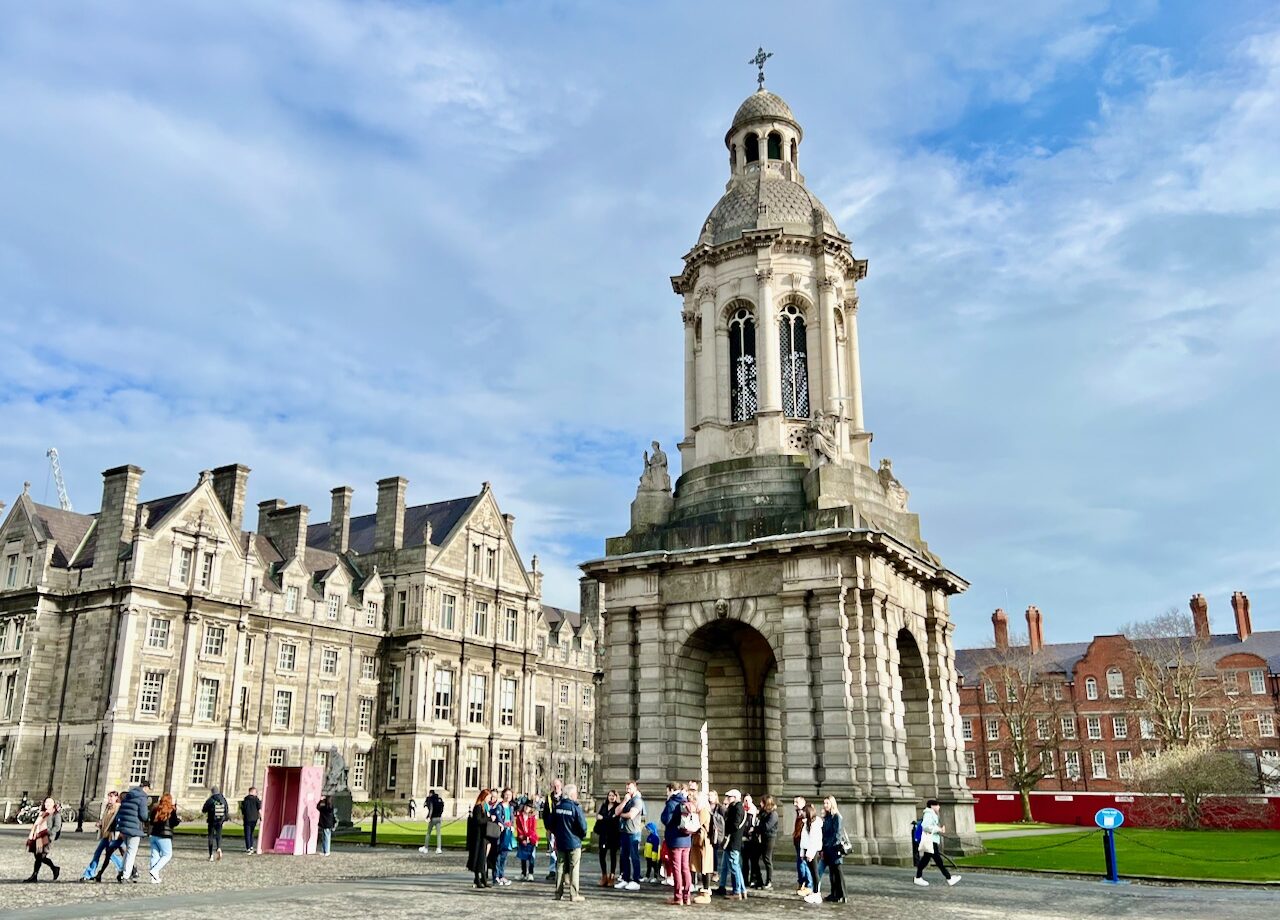
Dublin in a day
Dublin , the captivating capital of the Republic of Ireland, offers a wealth of experiences for visitors. Immerse yourself in the city’s vibrant streets, known for their rich storytelling tradition and lively music scene. As the birthplace of iconic beverages like Guinness and Jameson, exploring Dublin’s pubs is a must. During my recent business trip to Dublin, I set aside an extra day to revisit my favorite spots and embark on a walking adventure through the city center. Join me as I share my self-guided walking tour, highlighting Dublin’s top attractions and the charming pubs I discovered along the way. Whether you’re short on time or seeking a comprehensive day-long exploration, this walking route is an ideal choice.
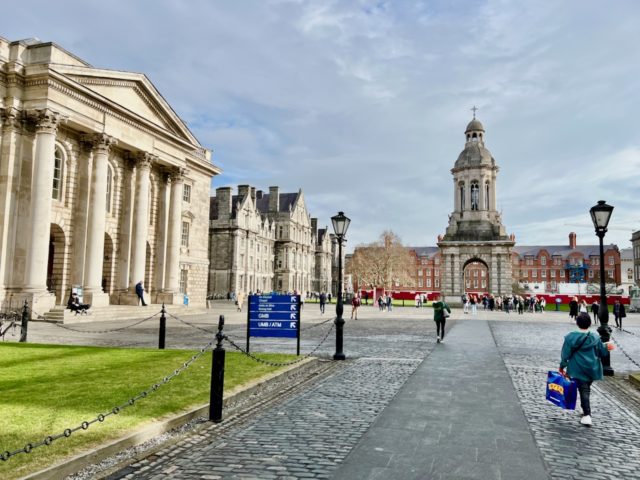
The highlights of Dublin: one day walking tour
This self-guided walking tour of Dublin is approximately 8km (5 miles) long and can easily be covered in a day, including visits to some of the attractions along the way. I ventured off this route many times whenever I spotted something interesting, which resulted in a total walking distance that day of 12+km (7.5 miles). The orange pins in the map represent the top attractions in Dublin covered in the walking route below. The purple pins are Dublin pubs I can recommend.
Dublin Castle
I stayed at the Marlin Hotel , a cool design hotel with a terrific location. From there, it was a short walk to Dublin Castle , my first stop. One of the most important buildings in Irish history, Dublin Castle was constructed in the 13th century on the site of a Viking settlement.
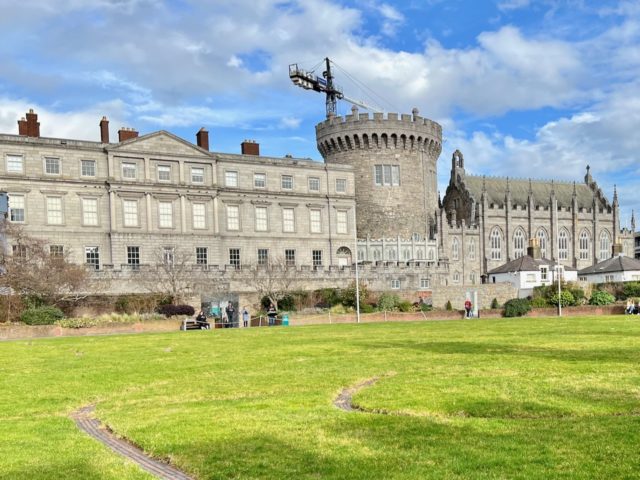
Chester Beatty Library
Within the castle grounds, I visited the Chester Beatty Library , often mentioned as the best museum in Dublin. Formerly the library of Sir Alfred Chester Beatty (a 20th century mining magnate), the museum houses his incredible collection of ancient manuscripts, rare books and miniature paintings. Entrance is free and it’s absolutely worth a visit!
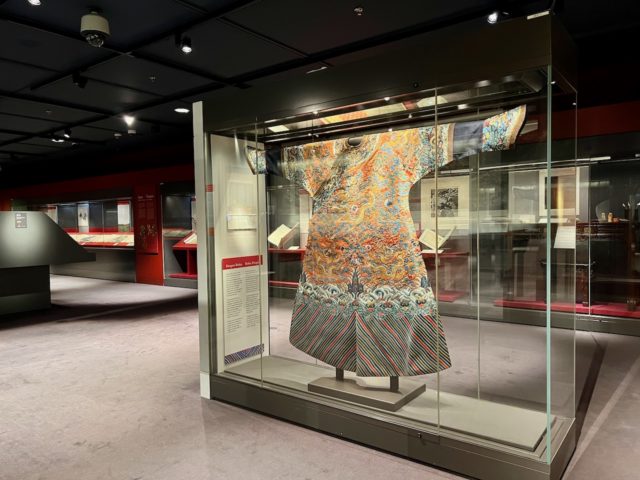
St. Patrick’s Cathedral
From Dublin Castle, I made my way to St. Patrick’s Cathedral and its adjacent park. The national Cathedral of the Church of Ireland, St. Patrick’s Cathedral was built in the 13th century and features a stunning nave and beautiful stained glass windows.
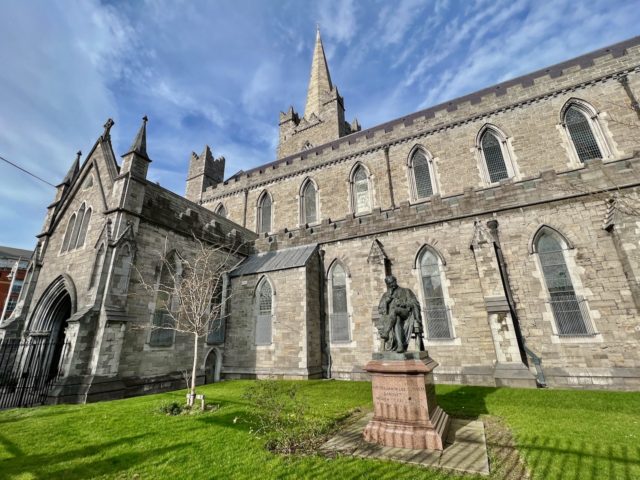
Christ Church Cathedral
I continued my ‘Cathedral Hop’ with a visit to the Christ Church Cathedral (or the Cathedral of the Holy Trinity). Constructed in the 12th century, this medieval Cathedral is even older than St. Patrick’s.
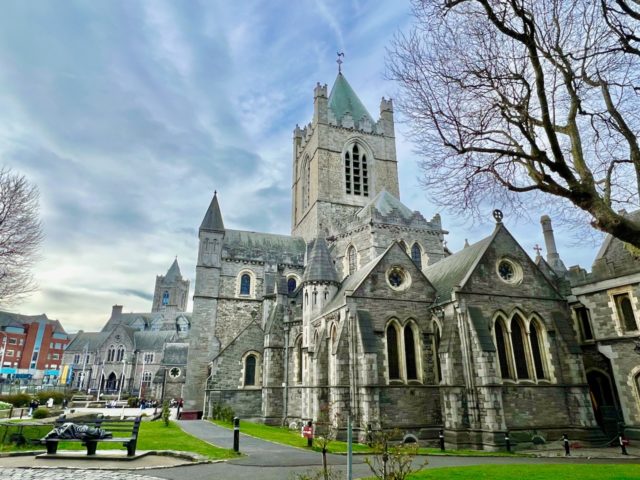
If you have time, continue up Lord Edward Road to the Guinness Storehouse , the famous brewery and museum. There are also panoramic views of Dublin from the Guinness Gravity Bar.
River Liffey
From the Christ Church cathedral, I walked down Lord Edward Street to the Dublin City Hall before turning left towards the River Liffey . The river is lined by beautiful, historic buildings on both banks.
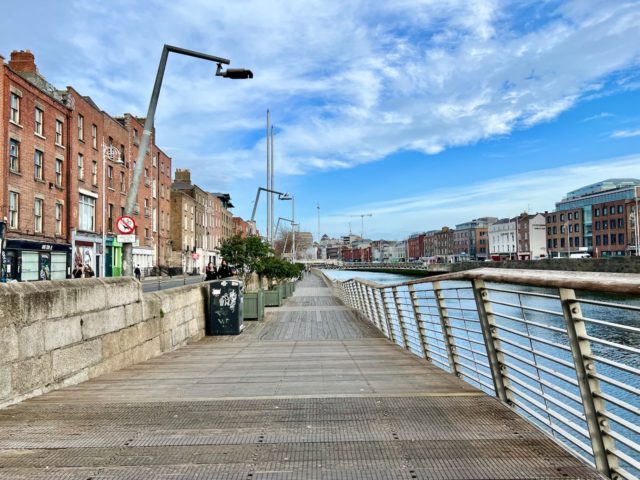
I crossed the river and continued my walk along the promenade to one of Dublin’s most iconic structures, the Ha’penny Bridge . If you’re following this Dublin walking route, consider visiting the Jameson Distillery on Bow Street, not far from the river. You can also buy a combined skip-the-line ticket for Guinness Storehouse and Jameson Distillery.
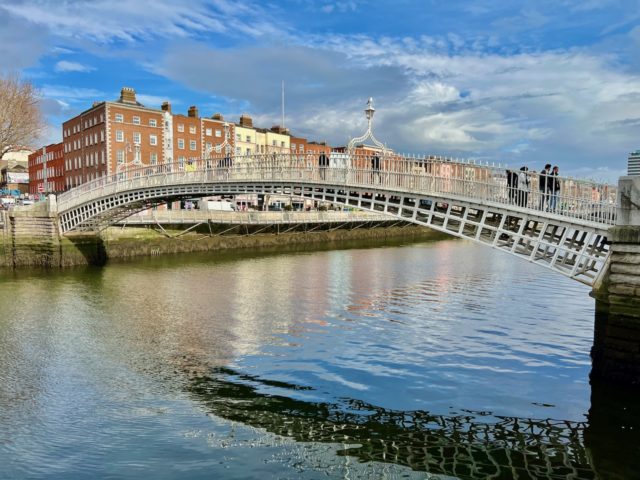
I crossed the Ha’Penny Bridge to the Temple Bar district. It’s one of my favourite areas in Dublin because of its lively pubs, vintage shops and colourful street art. I explored the streets and lanes in Temple Bar, looking for cool street art and simply soaking up the vibes, even if it was early in the afternoon.
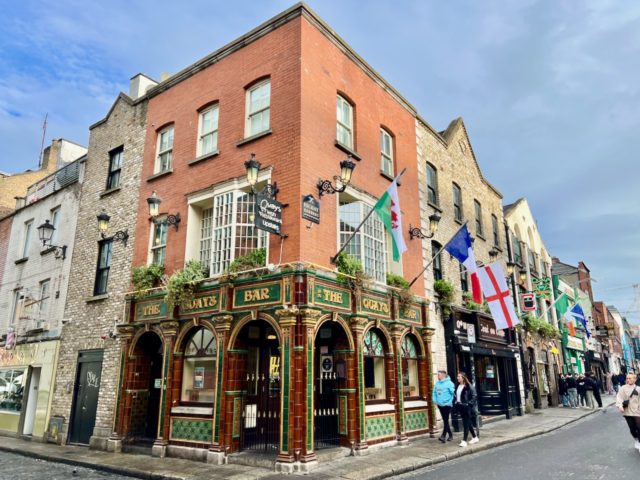
Don’t miss the world famous Temple Bar Pub , where bands often perform. If you have time, check out the Irish Rock ‘n’ Roll Museum in Curved Street. Temple Bar is also the perfect area for a lunch break as there are many restaurants, cafés and pubs serving food. I had a meal at Elephant & Castle .
Molly Malone
From Temple Bar, I walked up Church Lane to St. Andrew’s Street, the location of the Molly Malone statue. Molly Malone is from a song called Cockles and Mussels, the city’s unofficial anthem. A statue representing the character in the song was unveiled in 1988. Over the years, the practice of rubbing her bosom for luck became popular among tourists, resulting in a very polished bosom!
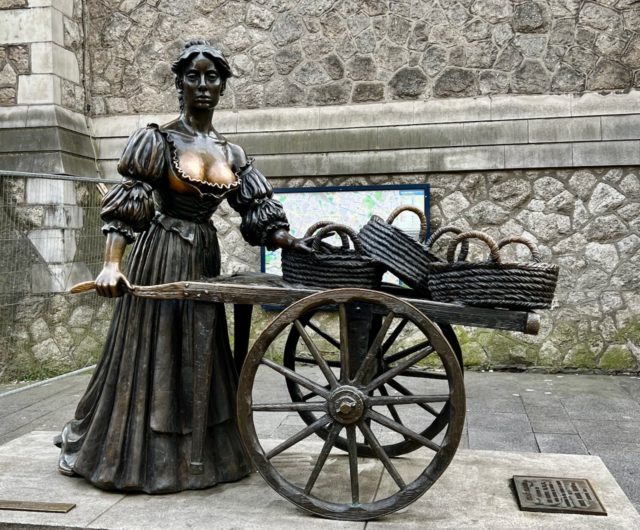
Irish Whiskey Museum
I continued my walk and stopped at the Irish Whiskey Museum . I enjoyed the interactive exhibits that tell the history of whiskey in Ireland, followed by a whiskey tasting.
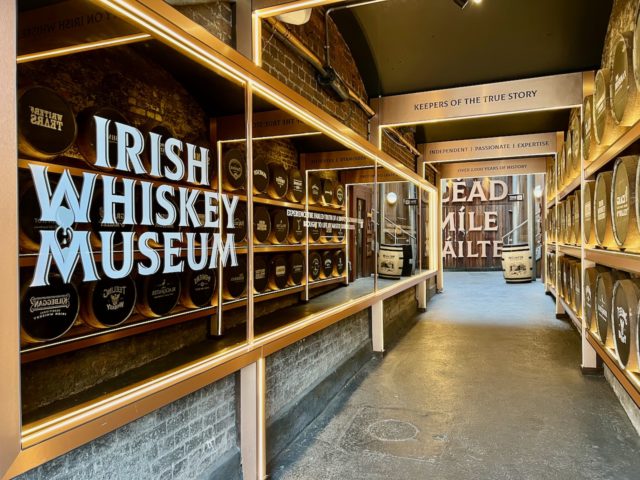
Trinity College
My next stop was Trinity College , across the road from the Irish Whiskey Museum. Established in 1592 by Queen Elizabeth I, Trinity College is another iconic Dublin landmark. One of Europe’s most prestigious academic institutions, the main attraction for tourists is the Library , which houses important artifacts such as the Book of Kells and an ancient wooden harp, the national emblem of Ireland.
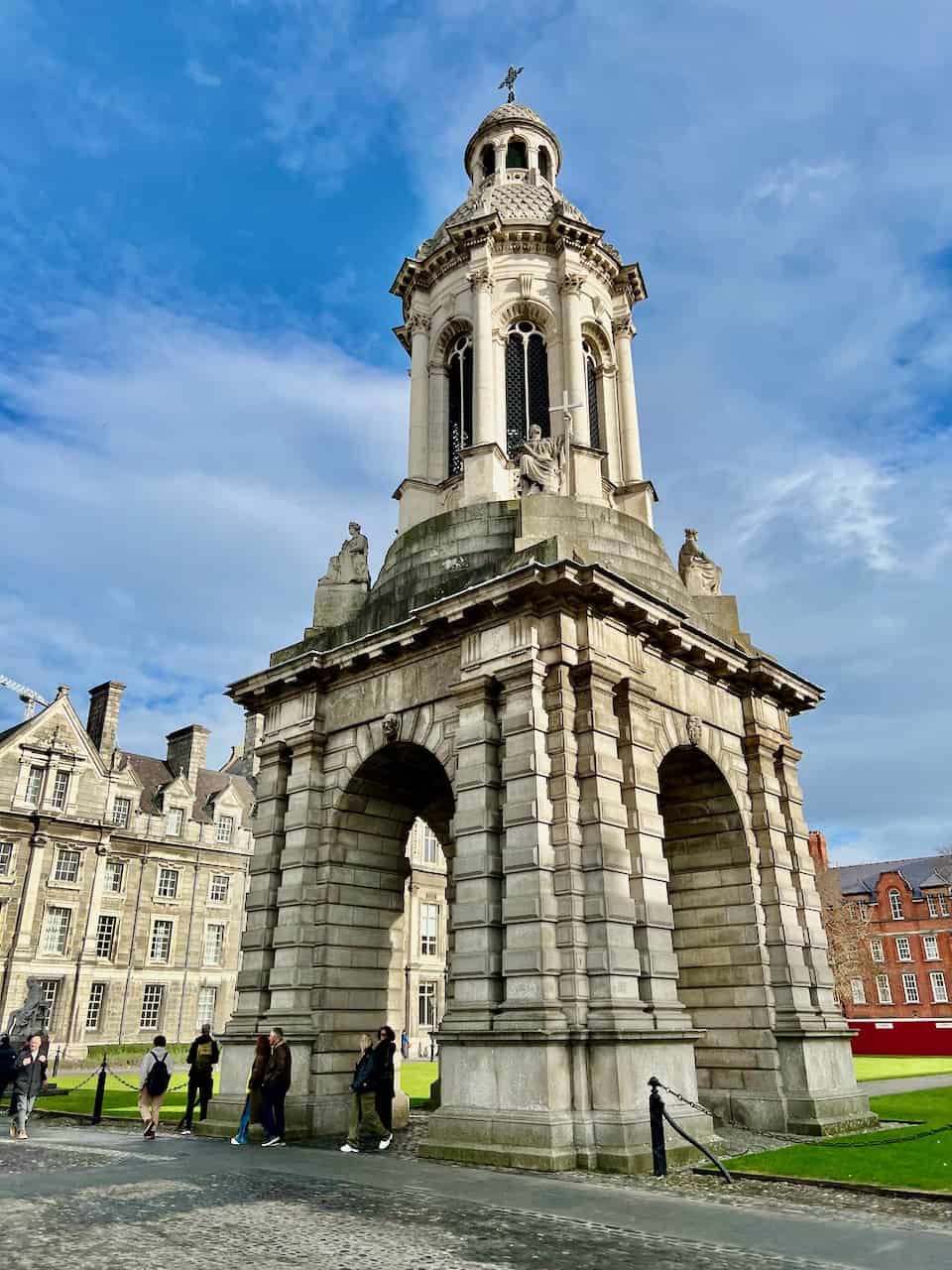
National Museum of Ireland
From Trinity College, I continued my walk along Kildare Street, the location of the Irish Parliament . Surrounding the Parliament are several notable institutions and museums such as the National Library , the National Gallery of Ireland and the National Museum of Ireland . I ventured into the National Museum (free entrance) and found a stunning interior with interesting exhibits and stories of voyages, battles and struggles.
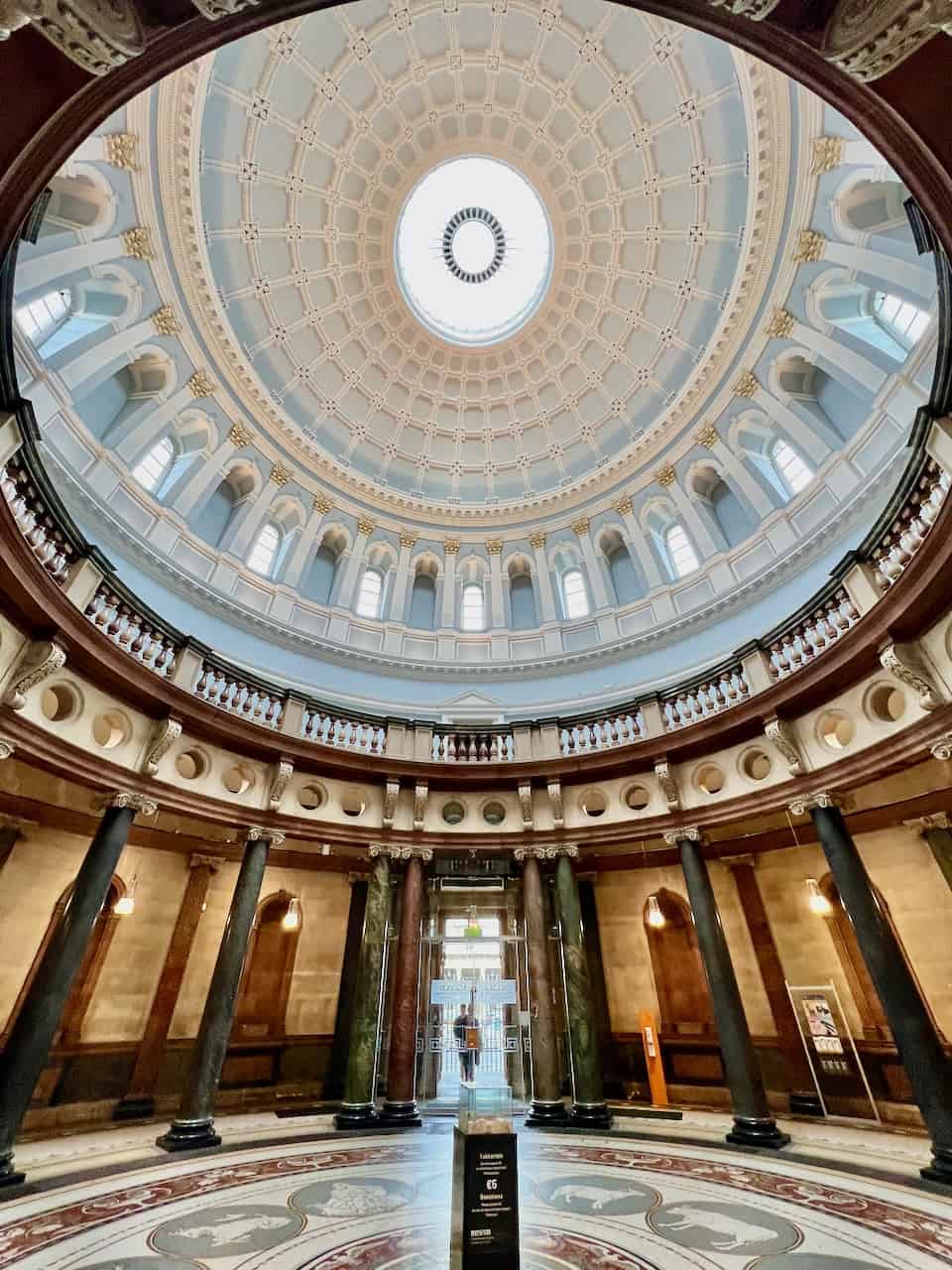
St. Stephen’s Green
After the museum, it was time for another break so I headed to nearby St. Stephen’s Green , one of Dublin’s most popular parks. I found a bench to enjoy the sunshine and beautiful greenery. Instead of the park, if you’d like to visit another nearby museum, I recommend the Little Museum of Dublin opposite the park.
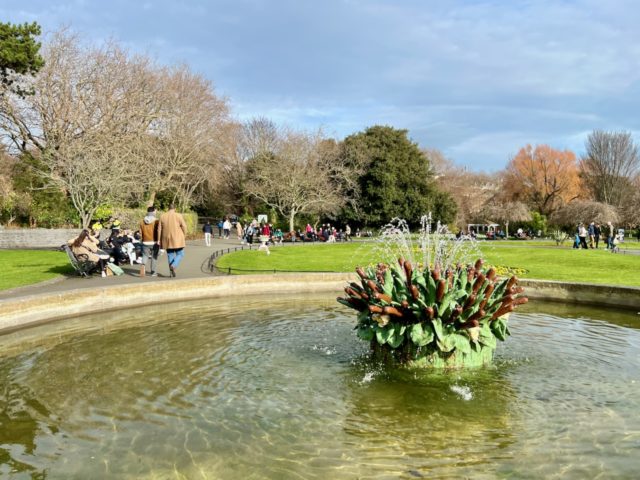
Grafton Street
From the park, I headed for Grafton Street , Dublin’s main shopping street. Near the top of the street, you’ll find Brown Thomas , Ireland’s answer to Harrod’s.
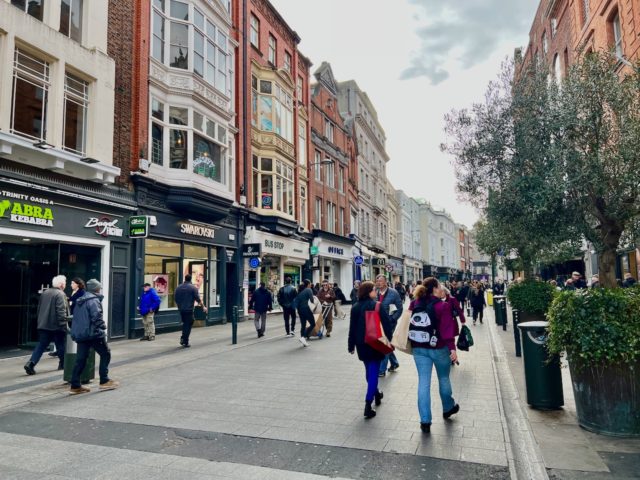
George’s Street Arcade
I turned off Grafton Street into Wicklow Street and explored the surrounding neighbourhood, with its countless restaurants and pubs. On previous trips to Dublin, I visited Mary’s Bar & Hardware (a pub in a ‘hardware’ store!), Grogan’s (a Dublin institution) and the quirky The Hairy Lemon . I ended up at the George’s Street Arcade , a shopping arcade inside a stunning brick building.
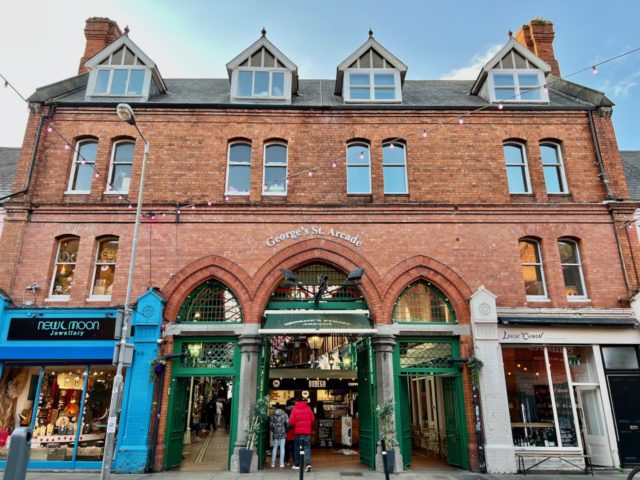
Whitefriar Street Church
I continued up Aungier Street to my final stop: Whitefriar Street Church . A friend of mine mentioned this church to me. One of the most popular churches in central Dublin, Whitefriar Street Church is home to important relics of St. Valentine, a gift from Pope Gregory XVI in the 19th century. Since then, the church has become a popular pilgrimage site especially during Valentine’s Day.
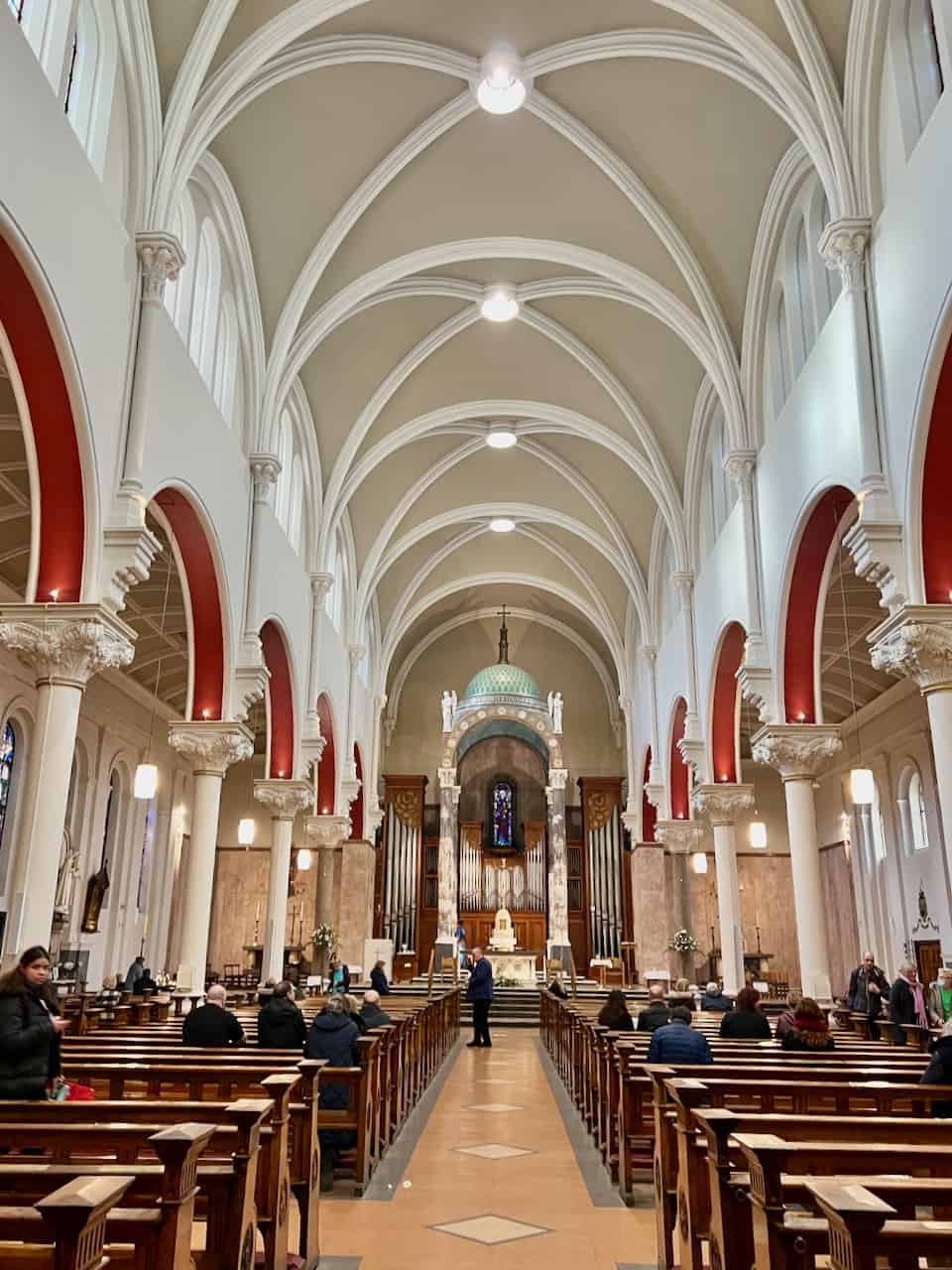
I ended my walk at The Long Hall , just down the road from the Whitefriar Street Church, for a well-deserved Guinness. This historic pub has a striking Victorian interior and a great ambiance.
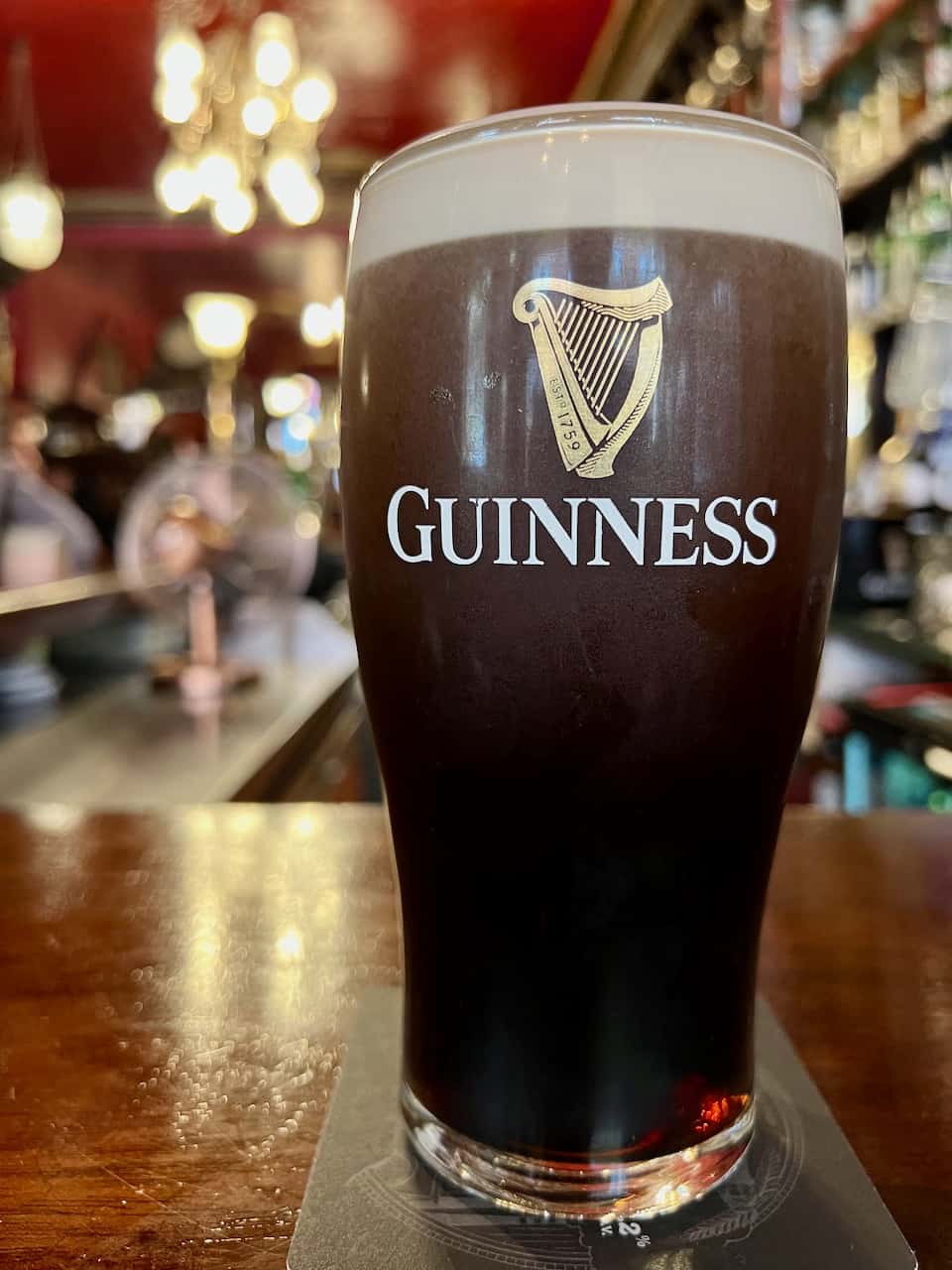
Read bout my drive along the Wild Atlantic Way on Ireland’s rugged west coast and my visit to the stunning Cliffs of Moher .
Related Posts
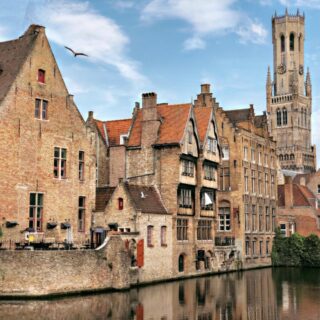
Subscribe to get the Velvet Escape Newsletter in your inbox!
2 Responses
Hello there! I just finished reading your article on the Dublin highlights walking tour, and I must say, it’s a fantastic guide that showcases the vibrant city of Dublin. Your article provides a comprehensive itinerary that allows readers to explore the best of Dublin’s cultural and historical treasures on foot.
I appreciate how you’ve highlighted the must-visit attractions and hidden gems that make Dublin such a captivating destination. From the iconic Trinity College and St. Patrick’s Cathedral to the lively Temple Bar area and the charming streets of Dublin’s Creative Quarter, your walking tour covers a diverse range of experiences. Your descriptions and historical insights add depth to the itinerary, making it even more intriguing.
Furthermore, your practical tips on where to grab a bite to eat and where to enjoy a pint of Guinness along the way are highly appreciated. It’s evident that you have a deep knowledge of Dublin and have curated this walking tour to offer an immersive experience for visitors.
Thank you for sharing this insightful walking tour of Dublin. Your article has sparked my wanderlust and made me eager to explore the city’s rich history and vibrant culture. Keep up the fantastic work, and I’ll be eagerly waiting for more of your travel guides and recommendations.
Awesome walking tour of Dublin! Love this – thanks for this. And yes I love it that you ended the tour with a pint of Guinness!
Leave a reply
Save my name, email, and website in this browser for the next time I comment.
This site uses Akismet to reduce spam. Learn how your comment data is processed .
Appeared In

Routes and Trips Travel Guide with Maps and Photos
Self-guided dublin walking tour: dublin’s top sights.
Posted by: Liisa Nygård
I spent a week in Dublin, walking a lot each day. That made me plan a self-guided Dublin walking tour and mark it on a map. My tour will show you the best of Dublin – in a day, two days or using a week, whatever you like.
Ireland’s cosmopolitan capital draws millions of tourists. The city has something that makes people return, time after time.
Maybe the pubs with live Irish music, or maybe Dublin’s past, present or future? Or is it the Liffey and other waterways with old Georgian houses and Dublin doors?
My walk will take you to the banks of the Liffey were most Dublin sights are and follow the Grand Canal to Dublin’s Georgian streets and coloured doors, like this one:.

Self-guided Dublin walking tour: a Dublin door
Dublin is an ideal city to walk around. It’s not too big to walk as the population is only half a million. Dublin centre is small enough to stroll through and there’s seldom too much traffic. All this makes walking the best way to explore Dublin. though there are hop on hop off buses and arranged Dublin tours as well.
Dublin has a small centre but the whole metropolitan area has almost 2 million people which is a third of Ireland’s total population. Ireland has 5 million people.
It could be more, 10 million people have left the country over the centuries. That makes there are 17 million people with an Irish background spread around the world. So in a way Dublin is the capital of a big nationality.
My Self-guided Dublin Walking Tour on the Map
This is a map of Dublin city centre with the river Liffey running through it. The red marker points at Temple Bar where my self-guided walking tour starts. We first walk south of the Liffey and return north along the Grand Canal that is in west.
North of the Liffey we walk west along the quays and cross the famous Ha’penny Bridge back to Temple Bar. Then we will still visit Dublin Castle and Christ Church Cathedral in the city’s old part.
Of course it’s not mandatory to start at Temple Bar. You can start wherever you like or walk in the opposite direction. This walk has no rules.
Zoom in the map to see more details or zoom it out to see Dublin in another scale.

Self-guided Dublin walking tour: a Temple Bar pub
Temple Bar is the heart of the city that most tourist want to see first and that’s why the self-guided Dublin walking tour starts there too.
What Temple Bar is famous for are the pubs. There are pubs in every street corner and more pubs in between so you can’t visit every pub. Most of them are traditional Irish pubs and look very old.
Temple Bar is one of the oldest areas in Dublin and it dates back to Viking times. Over centuries craftsmen and merchants moved to these narrow quarters that got their name from Sir William Temple who owned the land.
Click on these small photos of Temple Bar to see them in a slideshow:

Walking up and down these cobbled streets you will hear Irish music drift from pubs. Mostly exactly the kind of Irish music you recognize, the kind of music people all over the world love. The Irish that left abroad packed Irish music in their suitcases.
Look inside the pubs and sit down for a while and listen, but not too long. This is a self-guided Dublin Walking Tour and we have to go on. You can come back and you sure want to!

The colourful area of Temple Bar, Dublin
But Temple Bar has more than the pubs, it’s a large entertainment area with theatre, art exhibitions, galleries and so on. And all venues look like pubs, or what do you say about this one?It’s a pharmacy.
This pub fills the narrow gateway that leads to Ha’penny Bridge. We will come back to that well known bridge later.

Self-guided Dublin walking tour: an Irish pub
More Dublin Pubs
As we are in Ireland there are Irish pubs all over the city, not just in Temple Bar. We found great pubs east of St Stephen’s Green (this Dublin walking tour will bring you there too) and those pubs were not touristic at all. In Temple Bar most pub guests are tourists.

Another Irish pub
This pub is next to Trinity College that is what we will see next.
Trinity College

Dublin’s Trinity College
Trinity College is a world-famous university and highly respected. The college was built before year 1600 and for hundreds of years, until the 1970’s, they only let protestants in to study.
The Trinity College courtyard has green lawns for students to sit, an old clock tower and many beautiful old buildings – and a huge tree to give shade. The tree is like a well planned monument.

Even if you are not a student you are free to walk on Trinity College grounds. But to get to the library you will need a ticket.
Trinity College Library
Trinity College Library has a huge 64 metres long room with 200 000 old books and there are more books in other rooms. This is Ireland’s biggest book collection. All books are not Irish and a part of them came from the Dutch prime minister’s book collection.

The old library of Trinity College
Trinity College Library also has Ireland’s oldest harp and the Irish national script, the Book of Kells.
The Book of Kells is a book in four parts that has the four gospels written down in Latin. Monks in other parts of Ireland did the job over 1000 years ago and the book finally came to Dublin in 1653.
Trinity College Dublin

These photos show the Book of Kells, but I can’t show you the original. I only have photos on Book of Kells souvenirs from the bookstore. It was not allowed to take any photos on the real one.
But you can see the writing: the monks wrote in Latin but used Celtic letters. They decorated the each chapter with large initial letters that had many colours. And to end the lines they used decoration as well. Book of Kells also has beautiful picture pages that include a lot of symbols. The exhibition explains that all.

Statues in Trinity College Library
Sooner of later you will want to leave the dusty library. Take Grafton Street south.
Grafton Street is Dublin’s most important shopping street and leads to St Stephen’s Park that has a lot of flowers and a pond. There is another park too, Merrion Square that has beautiful Georgian houses around it.
In general this area has a lot of old Georgian houses that have colourful doors, doors of Dublin.
Doors of Dublin

A Dublin door
The residential area south of Temple Bar and Trinity College was built in the Georgian time in the 1700’s and 1800’s. Dublin was one of the most important cities in the British Empire, second only to London and Dublin needed to grow.
Wealthy families built their houses south of the Liffey and they built them all in the Georgian style. The rules said that all houses have to look the same. That’s what they really do.
But the families didn’t like it that way and made the doors individual. The result was that each door in a house has a different colour.

You can see coloured Dublin doors around Merrion Square and Fitzwilliam Square south of it and on Baggot Street between them. And there are more doors around the Grand Canal.
Emerald green, royal blue, deep purple, bright yellow, black and white, turquoise and of course red doors. And why not pink:

Another coloured door

A typical Dublin iron gate
And Georgian houses all have some great details like iron gates and apartments below ground level. I loved walking around and snapping photos on these Georgian houses and we even stayed in one. We rented an apartment and our Georgian Dublin door was black.
Dublin Museums

Dublin self-guided walking tour: visiting museums
The area south of the Liffey is an interesting place for tourists. There are a lot of Irish pubs that have live music and some great museums. There is the Irish National Gallery, Natural History Museum, the Irish National Museum – Archaelogy, the National Library and a museum called Science Gallery.
The museums I went to happened to be free so it was easy to drop in and have a look. You can do that on rainy days, probably you will have them during your Dublin stay. Dublin weather is hard to predict, or you can predict that it’s going to change in a minute.

National Museum – Archaeology exhibition
The photos are from the National Museum – Archaeology that opened my eyes to Irish history. The museum is full of old findings from prehistoric and Viking times and from medieval Ireland and some of these findings are from places where I have been to in this country so I know where they come from.
That’s imposing, thousands of years old pottery and jewellery from the Irish countryside!
Self-Guided Dublin Walking Tour along the Grand Canal

Dublin self-guided walking tour: walking along the Grand Canal
Did you know Dublin has more waterways than the Liffey? There are the canals that were originally built for transport needs. The Grand Canal is the longest of them. It makes a 6 km loop around Dublin city centre.
There is no traffic more, just occasional house boats. And you can see more Dublin doors behind the canal.

I would like to walk the whole loop but didn’t have time with that. But you can do it if you like. So my self-guided Dublin walking tour only covers a part of the Grand Canal.
We are walking along the canal from the old Georgian part of Dublin to its modern part, the Docklands.

The Grand Canal of Dublin, Ireland
It’s quite a difference if you can walk along a waterway compared to ordinary streets. You hear the birds and sit down for a while like my husband Clas did while I took photos on Dublin doors. There was someone else too, the Irish sculptor Rowan Gillespie.

Two men sitting in a Dublin park
Dublin Docklands
Self-guided Dublin walking tour: Dublin Docklands
This is the Grand Canal Docklands a bit north, a new built area where red sticks are used as a decoration. That reminds me of boating on the lake which is my summer hobby.
The Docklands has mainly office buildings but there are hotels and culture venues as well.

This (below) is Bord Gais Energy Theatre, also called Grand Canal Theatre, on a huge square built in 2007. It certainly brings a lot of energy to the docklands.

Bord Gais Energy Theatre
Self-Guided Dublin Walking Tour: Liffey Riverside

Samuel Beckett bridge
The Grand Canal waterway takes you back to the Liffey that you can cross along s a modern bridge, Samuel Beckett bridge that looks like a harp. Beckett was a writer and a Nobel Prize winner and a Trinity College student. The harp bridge was designed by a Spanish architect inspired by Irish music.

One of the new buildings across the bridge looks like a Guinness glass. But Guinness that is a Dublin sight too, is in west. This is a new landmark in Dublin, the Convention Centre Dublin. An American-Irish architect designed it and building it took a long time. The CCD opened for international business visitors in 2010.
The Convention Centre Dublin says it can take up to 8000 conference guests and there are 22 meeting rooms. The Guinness glass hides a large atrium that has curved walls and many escalators. A great example of what modern architecture can do! I came here many times since Clas was working here the whole weekk.

Convention Centre Dublin
The CCD represents modern Ireland and nearby there is something that takes you back to the old days. The Jeanie Johnston Tallship shows us the hard times Ireland has had.
The Great Famine
The Jeanie Johnston is a museum ship that shows how Irish emigrants left their homes when they were starving during the Great Famine and had to take the weeks long trip on rocky ocean waves and begin a new live in the New World.

Jeanie Johnston, self-guided Dublin walking tour
The Great Famine lasted for years around 1850 and changed Ireland quite a bit. One million people died from the lack of food and one and a half million left the country, most of them with ships similar to the Jeannie Johnston.
These quayside statues by the Dublin sculptor Rowan Gillespie bring back the Great Famine. They touch so much. The sculptor himself sits on a bench by the Grand Canal. Maybe you walked by him?

The quays are a wonderful area to walk along and there are good places to sit down. It’s mostly a modern area, office blocks and so, but old harbour equipment has been saved as well. And there are many bridges across the Liffey for cars, walkers and trains.

Sitting by the Liffey

A Liffey bridge
And you can learn more about the Great Famine and Irish history:
EPIC, the Irish Emigration Museum

EPIC, the Irish Immigration Museum
I said in the beginning that 10 million people have left Ireland and told that one and a half million left in the Famine years. When did all the others leave? You will get to know that in this glass building. It is the Irish Emigration Museum EPIC.
The museum shows Irish history in a modern, interactive way. I was planning just to drop in and finally spent hours in the museum listening to Irish stories and learning about Irish culture.

The focus of EPIC is yet on when, why and how so many people left Ireland, where they went and what they did in their new home country. Very fascinating stories and a very nice way to show it all. The museum has got a lot of praise and I agree. If you can go and see EPIC.
EPIC The Irish Immigration Museum
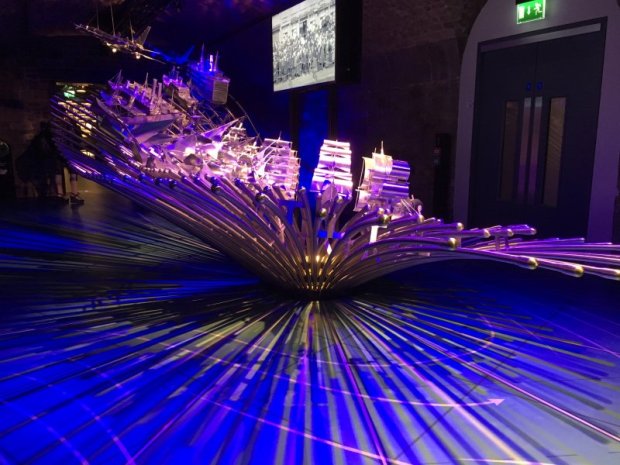
Entrance to EPIC, the Irish Immigration Museum
Self-guided Dublin Walking Tour: North of the Liffey

Dublin’s Custom House
Walking north of the Liffey there is this large building. It is called Custom House but it is a government office. The Irish built this huge custom house but after a while custom business moved to London. Neither is a custom house needed in today’s EU.

These photos show O’Connell Street that is the main street between north and south in Dublin. There is the Old Post Office, in fact it’s only the facade of it. The rest was destroyed in an uprising in 1916 that finally led to Irish independence.

Dublin self-guided walking tour: the Monument of Light.
This is the Spire. Its real name is the Monument of Light. It is 120 m high and made of stainless steel. It’s three metres wide in the beginning and 10 cm wide at the top.
Ha’penny Bridge
On Ha’penny Bridge
Ha’penny bridge is what most people think about when they hear the word Dublin and you can see the bridge here. The bridge links Temple Bar to the north and 30 000 people cross the bridge each day.
There is no fee but there used to be. That’s what the name comes from. For over a hundred years they took a fee for crossing the bridge, a half penny.

The half penny bridge was made by an English iron worker in 1816. He made the bridge of cast iron and painted it white. He designed nice gates and on the top he put iron lanterns. Ha’penny bridge, the symbol of Dublin.

Crossing the Liffey on Dublin’s Ha’penny Bridge
Ha’penny Bridge takes you back to Temple Bar and beyond it, to the old part of Dublin. There is the Dublin Castle.
Self-Guided Dublin Walking Tour: Dublin Castle

Interior of Dublin Castle
Dublin Castle is located in the place Dublin got its name from. There was a dark pool (Dub Linn) that later on got covered. You don’t see much about the old centre of Dublin. But Dublin Castle is left, rebuilt over centuries and added to.
Originally built in 1204 by King John of England the castle was the headquarters of the English that ruled Ireland for the next 750 years. Since Ireland got independent in 1922 Dublin Castle is the place for Ireland’s big state events.

One of the halls of Dublin Castle

Dublin Castle, Ireland
The present Georgian palace was added in the 18th century and there are the castle’s state apartments that you can visit. The state apartments consist of dining and drawing rooms and a throne room. All rooms are very decorative.

St Patrick’s Hall, Dublin Castle
This is St Patrick’s Hall that used to be the castle’s ballroom. Today it is the most important ceremonial room in Ireland. It is a hall with beautiful ceiling paintings and many banners on sides. They are banners of the knights of St Patrick.
Dublin Castle
Christ Church Cathedral

The 1038 Christ Church Cathedral
Christ Church Cathedral is close to Dublin Castle and it is Dublin’s oldest building. A Norse king and an Irish bishop built the cathedral in 1038 after the Normans took over the city.
Christ Church Cathedral has changed its form since but there is an old leaning wall inside and other old parts remain. And you have to see the interior decoration. You can also see that if you go on a concert in the church.

Christ Church Cathedral, Dublin
Self-guided Dublin Walking Tour Ends

Self-guided Dublin walking tour along Dublin waterways
If you followed my Dublin walking tour you have been walking 8 km in a day which is quite a bit. You deserve a beer in Temple Bar, and Irish live music. Hoping to meet you one day in Dublin and have a great evening!

Have a great Temple Bar evening!
More on Dublin and Ireland
- Maybe you want to make a day trip from Dublin? Check out my post Giants Causeway Day Trip from Dublin
- Or rent a car and head to the Wicklow Mountains? Wicklow Mountains Scenic Drive from Dublin
- We also have a guest post about a road trip around Ireland: Road Trip in Ireland: Dublin to Galway, Moher and Cork

Giants Causeway day trip from Dublin
Read about European Cities
- Amsterdam, Antwerp, Bruges and Gent
- Tallinn Old Town
- Palma de Mallorca
Trinity College has admitted Catholics since the 1870s. It was the Catholic Church itself that forbade it’s members from attending without specific permission until 1970.
Thank you for your lovely walking tour and for your information and photos of Giant’s Causeway. We are planning a trip in the near future to Ireland and your site has been very helpful. We can’t wait!
So glad to hear you find my site helpful. I also recommend you go and see Wicklow mountains, I went there too but didn’t write about it yet. You can rent a car or take a bus tour.
This was very helpful! Thank you! We are visiting in May and spending 2 nights in Dublin. How is parking around town? We plan on staying in outer Dublin as the hotel prices are cheaper, but want to go into the city.
I’m sure you will have great days in Dublin, May is a wonderful time to visit! But I have to say I don’t know about parking. We only rented a car to make a day trip to Glendalough and Wicklow mountains so I don’t have any experience in parking in the city.
Leave a Reply Cancel reply
Your email address will not be published. Required fields are marked *
Save my name, email, and website in this browser for the next time I comment.
This site uses Akismet to reduce spam. Learn how your comment data is processed .
- Click to open search
- Open the main navigation
- Newsletter Opens in a new window
The best walking tours in Dublin

Dublin’s lively neighbourhoods and wonderful architecture are reasons enough to encourage a visitor to lace up their shoes and hit the streets. Follow a knowledgeable guide as you learn all there is to know about the city. Choose from tours that focus on history and hidden gems to food and entertainment, or, if you’re feeling especially daring, even tours focused on true crime and haunted places! No matter what your interests are, there’s a walking tour to satisfy you.

Pat Liddy's Walking Tours of Dublin Ltd

Walking Food Tours - Dublin
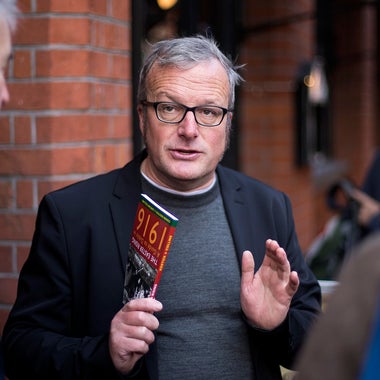
1916 Rebellion Walking Tours

Historical Walking Tours Of Dublin
In our shoes walking tours.
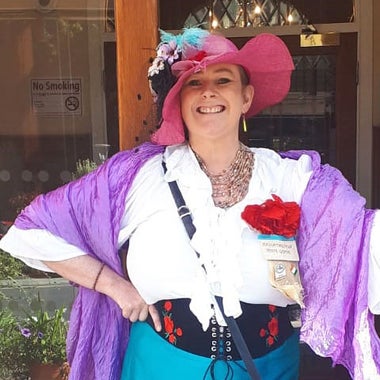
Dalton’s Musical History Tour

A Spasso A Dublino - Italian Tour in Dublin
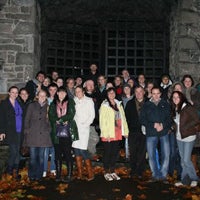
The Haunted History Walking Tour - Hidden Dublin Walks
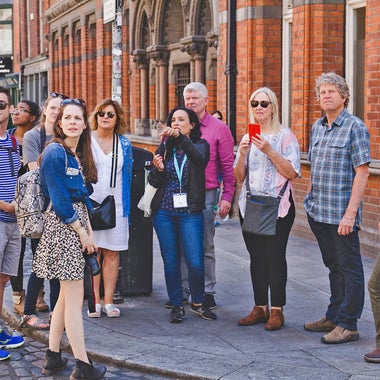
Delicious Dublin Tours
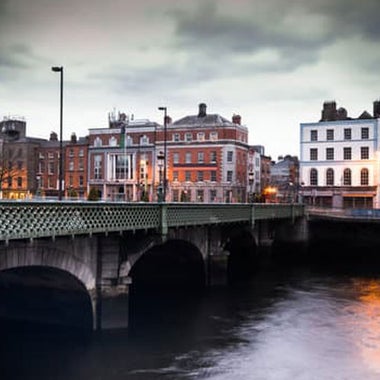
Tours de Dublin en Français

Senza Meta La Dublino dei Dublinesi - Out and About- Tours in Dublin and Ireland
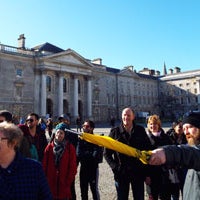
Yellow Umbrella Tours Ltd
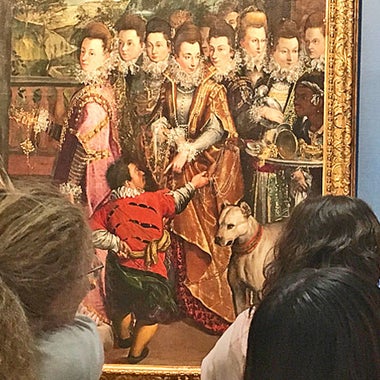
Dublin Decoded Walking Tours

Tailteann Walking Tours

Howth Walking Tours
Account Options
+353 83 067 3393
[email protected]
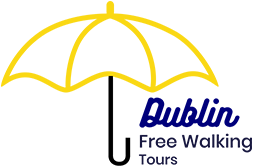
Join Us for the Craic!
Belfast Cork Dublin Galway
We are Yellow Umbrella Tours. We are proud to be local and independent. Join us to experience the best of Dublin.
Best of dublin tour (southside), tips - based, everyday at 10am, 11am & 2pm at the spire (the big needle) on o'connell st..
Join us on this tour to experience the top attractions and get a feel for our charming city.
- Trinity College – Temple Bar – Dublin Castle – Christchurch Cathedral – St. Patrick’s Cathedral
Meet beside the Spire (the big needle) in the middle of O’Connell Street.
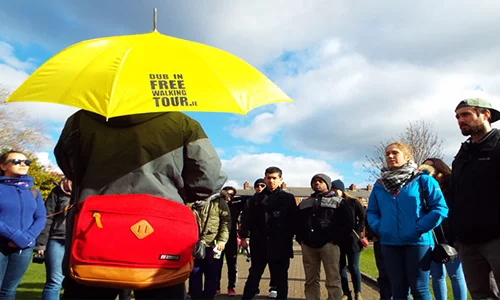
Free Tour Dublin Highlights
Time: 10am, 11am and 2pm every day.
We offer Southside FREE walking tours several times daily. Also check out the Northside FREE walking tour at 3.00pm every...
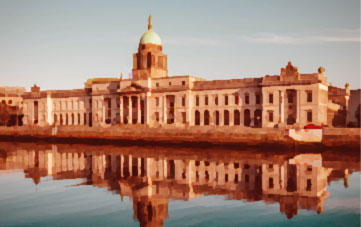
Free Tour Northside
Time : 03.00 pm every day.
On this tour, we will visit famous locations such as The Garden of Remembrance: dedicated to those who gave their...

Tour Gratis Lado Sur
Todos los días a las 11:00.
La calidad de nuestros tours está garantizada porque se basan enteramente en las propinas. Tu guía no recibe dinero de...

Tour Gratis Lado Norte
Todos los días a las 16:00.
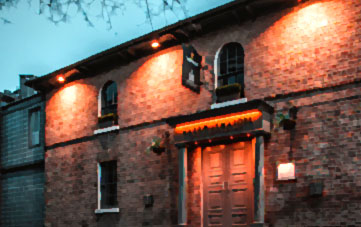
Misterios y Leyendas
Todos los días a las 18:00.
Callejones, leyendas, secretos, misterios… adéntrate con nosotros en el lado oscuro de Dublín para conocer su historia más desconocida.
Explore Our Most Popular Tours
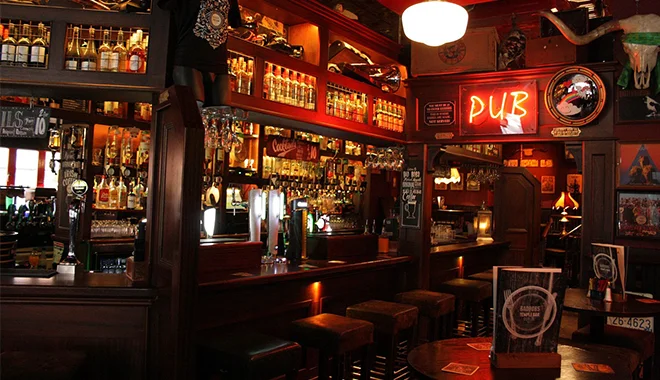
Dublin Traditional Pub Tour
Everyday at 6PM at the Spire (The Big Needle) on O'Connell St.

Private Walking Tours
Want to explore the city on a personal level and from a local perspective?

Testimonials
What people say about us, southside dublin free walking tour.
Southside Tour with Peter was Fantastic. I am all about walking yours in towns and this was one of the best. It lasted about 3 hours, but I could have wandered around with Peter for a couple of more hours and not gotten bored. We got great general history of Ireland and insite to specific sites on the South Doubling tour. Highly recommend.
Absolutely recommend!
During my short trip to Dublin I decided to book a free walking tour with the Dublin Free Walking Tour – South Side. Our guide was Conor (with one ‘n’) who did a great job sharing bits of Ireland’s/Dublin’s history and present in a relatively short amount of time (one can learn a lot in 3 hours) and with some humour. I had lots of fun learning during this tour and I would 200% recommend anyone to book it. I’m sure you won’t regret it!
Great experience
Our tour lasted 2hr45 of the Southside, and was really excellent. Our tour guide gave us lots of information and was happy to answer questions, and was generally very friendly and easy to understand. It’s a contribution at the end as well, but nominally free. Would definitely recommend!
All you need to know within 2 hours
A great mixture between information, fact, cultural insights and first hand tips for pubs and restaurants. Would encourage everyone to go on a tour!
Must-do in Dublin
Had a fantastic South Side tour with Richie on Sunday morning. Very informative and funny, and we learned interesting history about Dublin. It’s three hours but time flies by! Highly recommend to anyone wanting to take a walking tour – best way to get your bearings plus learn about the buildings instead of just looking at them!
Interesting tour!
Very interesting tour about the history of the city of Dublin. Our guide Conor was dynamic and captivating! We recommend to discover the city at the beginning of your stay!
Informative and fun tours with a great guide
We did both the north and south side tours with Peter. He was absolutely fantastic and really knowledgeable, giving an insight into the city we never would have had walking round in our own. He was also really helpful in answering any questions and providing recommendations for the rest of our trip. Great experience and would definitely advise anyone visiting Dublin to book on to both tours.
Educational and fun. Highly recommended!
My hostel recommended this company to me. Incredibly knowledgeable guide for the free morning & afternoon walking tour (tour date 30.11.2021). Did not expect this level of knowledge and presentation skill from a free tour, but will definitely take a closer look at their normal tours next time I am in Dublin. I am sure they are fabulous too. Overall highly recommended!
I agree to the Privacy Policy
+353 87 255 4765

Dublin Strolls
Guided Walking Tours of Dublin City
Daily Tours: 11AM & 230PM

About Dublin Strolls - Guided walking tours of Dublin city
Discover Dublin through the eyes of a local on your guided walking tour. Join your experienced tourist guide, Dermot, to discover Dublin city on foot. We keep our group sizes small to make sure you leave loving Dublin city as much as we do!
Daily Tours at 11:00AM and 2:30PM
Take one of our most popular walking tours; learn about Medieval and Viking Dublin, seek out the grandeur of Georgian Dublin or explore the city's most famous sights on this small group walking tour of Dublin.
We offer customised tours for individuals, families, friends and groups. Have a special interest in literature, history, music? Want to rediscover your city, or your Irish heritage? We will design a bespoke guided walking tour of Dublin city to match your interests, ensuring you have the best day out exploring Ireland's beautiful capital city.

GEORGIAN DUBLIN, SOUTHSIDE
Duration: 2.5 to 3 hours at a leisurely pace
On this guided walking tour discover the delights of Georgian Dublin and delve into its history. Sights include: Georgian Squares, Leinster House, Huguenot Cemetery and much more
Get in touch


Travel with Tourblink
- Tourblinkers

- Santiago, Chile
Buenos Aires
Saint petersburg.
- Buenos aires
Anthropology Museum
- Gardens of Versailles
- Père-Lachaise
Walking tour guides in your phone
What is Tourblink?
We share information and create apps for cities or museums that allow you to do walking tours on your own. When you are alone many times you do not know which route to take nor do you have quality information about what you are seeing. Private tours could be quite expensive and in free tours you have to be at "the group rhythm", specific time, etc. We propose you:
Walking tours through main neighborhoods or museums using images to guide you. No map, no gps. We put the image, the description and where you have to go and see.
Quality and interesting audioguides and information. Our Tourblinkers or local guides tell you the stories and secrets of each place with a unique style and vision.
No internet connection Our applications can work without connection and without GPS. All apps are light-built: no more than 40M.
Share your knowledge and passion for your city with Tourblink
Are you planning your trip to some of these places ? Get all the info you need about it! All free!
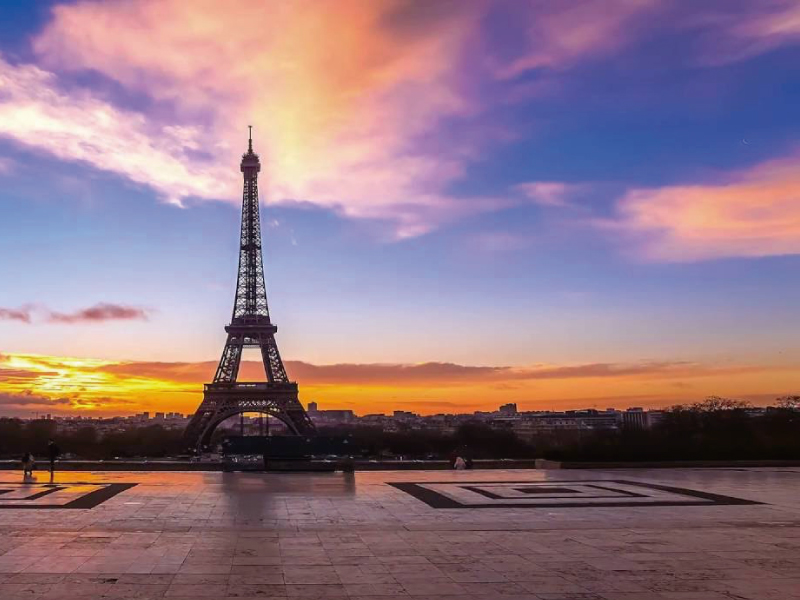
Lorem impsun onsectetur
Consectetur adipiscing elit, sed do eiusmod tempor incididunt ut labore et dolore magna aliqua. Ut enim ad minim veniam.

Louvre Museum
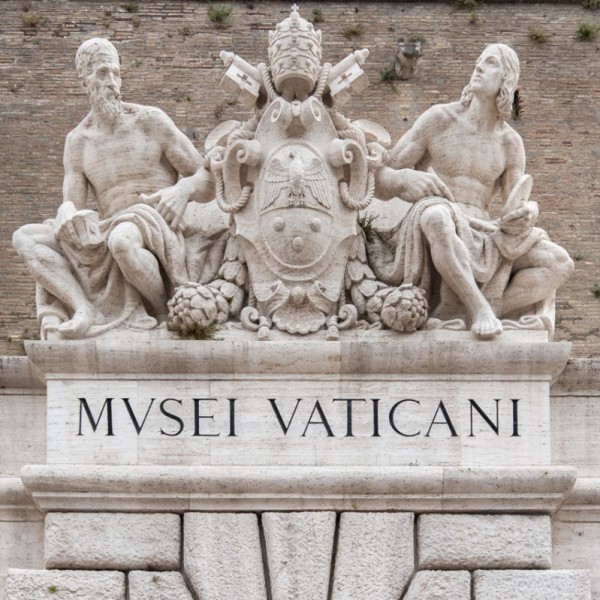
Vatican Museums
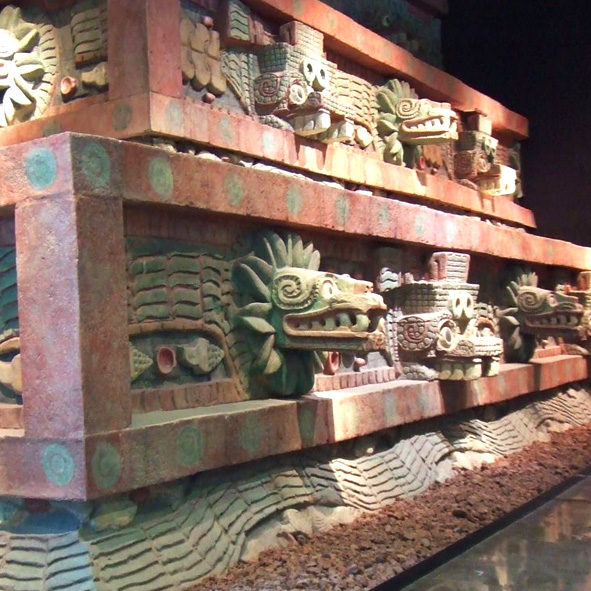
Orsay Museum
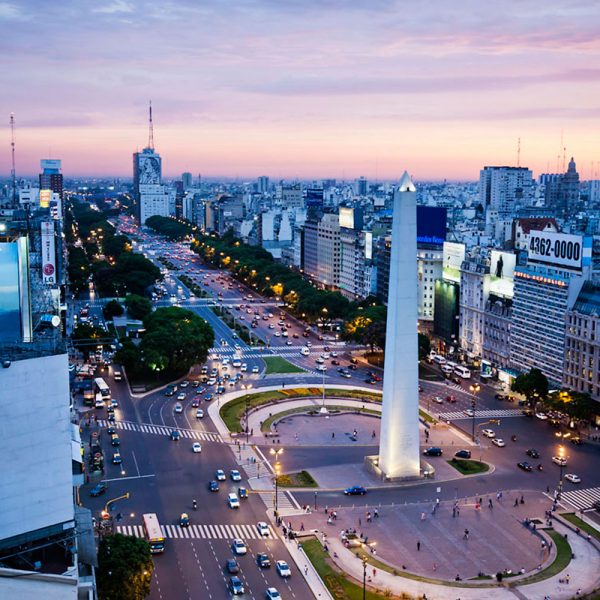
Père Lachaise Cemetery

Versailles Gardens

Best things to see and do in Moscow
Moscow is the capital of Russia and is one of the most popular tourist destinations in Asia. It’s rich and complex history is a constant reminder of its strategic position between Europe and Asia and makes it one of the cities you should visit once in your life. In terms of the many iconic landmarks, the delicious cuisine, and the characteristic, colorful architecture it has, Moscow is full of surprises for first-timers and seasoned travelers. Apart from the main attractions, it has like the Kremlin or Red Square, Moscow has many hidden gems for you to discover on your free walking tour with your local guide.
On any of the free guided tours we offer in Moscow , you will be able to find a selection of many tours which are available in different languages and at different times of day, like the morning, afternoon, and evening. Since Moscow is such a large metropolis, getting your bearings by doing a guruwalk with a local guide who will show you all Moscow’s hidden gems is a great idea. This way you get to learn as much as possible about the local culture and way of life. A trip to Moscow wouldn't be complete without visiting iconic places like St Basil’s Cathedral, Lenin’s Mausoleum, the Pushkin State Museum of Fine Arts, or the State Historical Museum, before getting some fresh air at Gorky Park, the medieval church of Kolomenskoye, or shopping at Izmailovsky Market. Don’t miss visiting the Cathedral of Christ the Saviour, the Bolshoi Theater, or checking out the Tsaritsyno Museum-Reserve.
Many travelers have left their r eviews and opinions about the local guides , gurus, and the routes they walked. If you have any questions about the routes or what is included in the tour, check out their opinions.
Free walking tour near Moscow
Others cities to visit after moscow, where are you traveling to.
Alchemy Tours
Most Recent: Reviews ordered by most recent publish date in descending order.
Detailed Reviews: Reviews ordered by recency and descriptiveness of user-identified themes such as wait time, length of visit, general tips, and location information.
Alchemy Tours - All You Need to Know BEFORE You Go (2024)
- International
- New York/Region
- NYT Front Page
- Crossword/Games
- Dining & Wine
- Fashion & Style
- Home & Garden
- Learning Network
- Multimedia/Photos
- Week in Review
- Editorials/Op-Ed
- Readers' Opinions
- The Public Editor
CLASSIFIEDS
- Real Estate
- All Classifieds
Walking Tour: Kitai Gorod
Kitai Gorod, with its twisting and winding streets, is the oldest section of Moscow outside the Kremlin. The literal translation of Kitai Gorod is "Chinatown," but there has never been a Chinese settlement here. The origin of the word kitai is disputed; it may come from the Tatar word for fortress, but most likely it derives from the Russian word kita, in reference to the bundles of twigs that were used to reinforce the earthen wall that once surrounded the area.
Kitai Gorod begins where Red Square ends. Settlement of this area began in the 12th century, around the time that the fortified city of Moscow was founded on Borovitsky Hill (the site of the present-day Kremlin). By the 14th century Kitai Gorod was a thriving trade district, full of shops and markets. At that time it was surrounded by earthen ramparts, which were replaced in the 16th century by a fortified wall, remnants of which still remain. As Moscow grew, so did Kitai Gorod.
At the time of the Bolshevik Revolution it was the city's most important financial and commercial district, with major banks, warehouses, and trading companies concentrated here. These days the multitude of shops, restaurants, and banks demonstrates the area's reasserted role as an energized commercial center.
A good starting point for your tour is Nikolskaya ulitsa, which begins at the corner opposite the Historical Museum and runs along the north side of GUM. If you are coming from St. Basil's, walk away from St. Basil's toward the Historical Museum alongside GUM. If you are coming from outside of Red Square, get to Nikolskaya by way of Teatralnaya Ploshchad (Theater Square). If you are standing with your back to the Bolshoi on this square, walk straight ahead, cross the street, and enter one of the narrow passageways to the right or left of the Teatralnaya metro station (as you are facing it). Taking a right out of either passageway will bring you to Nikolskaya ulitsa. Go a short way farther to the right, to the cobblestone edge of Red Square, to begin your walk.
Nikolskaya ulitsa, which is named after the Kremlin's Nikolskaya Gate Tower, is one of the oldest streets in Moscow. At the corner with Red Square is the Kazansky Sobor . Leaving the church, take a left to make your way through the teeming crowds of shoppers on Nikolskaya ulitsa to No. 7, the Zaikonospassky Monastyr , the former Slavonic-Greco-Latin Academy now undergoing a slow restoration. Farther down the street, also on the left-hand side, is a once brightly painted white-and-aqua building with an elaborate facade (No. 15). The building was erected in 1810-14 on the site of the 16th-century Pechatny Dvor (Printing Yard), where Russia's first printed book was assembled in 1553. Today the building houses the Moscow Institute of Historical Records and the Moscow Humanitarian University. Cross the street to go down Bogoyavlensky pereulok. Halfway down the block, opposite the entrance to the Ploshchad Revolutsii metro, is the Bogoyavlensky Sobor . Continue down the street to where it intersects with ulitsa Ilinka. Before the 1917 revolution this was Moscow's Wall Street, and it is still lined with the impressive facades of former banks.
On the left-hand corner stands the former Ryabushinsky Bank . As you cross the street, look to your right; ulitsa Ilinka leads directly to the Kremlin's Tower of the Savior. At No. 3 stands the Tserkov Svyatoi Ilii church from which the street takes its name. The church, which dates to 1520, is in disrepair except for its facade. Opposite the church is one of the border streets of the Gostinny Dvor merchant's arcade. Turn left and walk the length of Khrustalny pereulok to reach one of the oldest streets in Moscow, Varvarka ulitsa. The opposite side of the street is lined with quaint old churches and buildings, but the first thing you'll likely notice is the gray bulk of the massive, concrete-and-glass Rossiya, one of Europe's largest and most unattractive hotels.
At the farthest corner of the street, to your right, is the Tserkov Velikomuchenitsy Varvary . Adjacent is the English Court . Next comes the white-stone Tserkov Maksima Blazhennovo . The pointed bell tower situated just before the semicircle sidewalk leading to the upper-level entrance of the Rossiya hotel was once attached to the redbrick Znamensky Sobor on the other side of the sidewalk; with its foundation on the slope below, it is set back from the street. At No. 10 is the Palaty Romanovych v Zaryadye , believed to be the birthplace of Tsar Mikhail Romanov. Before leaving Varvarka ulitsa take note of the last church, the blue Tserkov Georgiya na Pskovskoy Gorke at No. 12.
If you stand to the left of the church (on the walkway leading to the Rossiya hotel) you can glimpse a remnant of Kitai Gorod's 16th-century brick fortification wall. It is to your left, opposite the hotel's eastern facade. Cross to the other side of Varvarka ulitsa and walk a short hop past the final church. Make a right and climb up the narrow Ipatevsky pereulok, which leads to several government and administrative buildings. At the top of the incline to the right is one of Moscow's best-preserved 17th-century churches, the Tserkov Troitsy v Nikitnikach .
Continue down the lane to the right of the church to reach Novaya Ploshchad, or New Square, which is more like a boulevard than a square. To your right, at the far bottom of the hill, Slavyanskaya Ploshchad opens up. At the bottom of the hill is the redbrick Tserkov Vsekh Svyatykh na Kulishkakh . From Novaya Ploshchad stroll for a long block or two past the government buildings, where the Central Committee of the Communist Party once sat. Now these buildings house the Duma of the Moscow Region. Soon you will come to the beginning of a busy intersection. To your right, in the median strip that divides Novaya Ploshchad, is a park that holds the Plevna Memorial, an octagonal, towerlike monument commemorating the Russian soldiers who fell in the Battle of Plevna in the Russo-Turkish War (1878). Keep walking up the street on the left side to go to the Muzey Istorii Goroda Moskvy , a small museum on Moscow's history.
Note the building on the opposite side of the street that takes up the entire block. This is the Politekhnichesky Muzey , a museum of science and technology. Directly north of this museum is yet another museum, Muzey Mayakovskovo , which includes a re-creation of the study of the great revolutionary poet. A short distance from here, Novaya Ploshchad intersects with the circular Lubyanskaya Ploshchad , where you can behold the Lubyanka Prison and the former KGB headquarters, which now house the FSB -- the New Russia's federal security service. On the west side of the square is Detsky Mir, a large department store that used to specialize in toys but now carries all sorts of items.
Walk past Lubyanskaya Ploshchad to the west side, down to where it converges with the broad street of Teatralny proyezd, Moscow's most elite shopping street. On a side street to your right stands the ornate and luxurious Savoy hotel (3 Rozhdestvenka ulitsa), which, like the nearby Metropol hotel, was built in connection with the celebrations in the early 20th century honoring 300 years of the Romanov dynasty. On the left-hand side of the street you will pass a statue of Ivan Fyodorov, the printer who produced Russia's first book at the old Printing Yard on Nikolskaya ulitsa. The arched gateway just to the right of the statue links Teatralny proyezd with Nikolskaya ulitsa, the street on which you started the tour. Teatralny proyezd leads into Teatralnaya Ploshchad, site of three of Moscow's most important theaters.
Taking up the block on the southeast corner, the first building you will encounter to your left as you approach Teatralnaya Ploshchad is the Metropol , an art nouveau hotel. Reaching the square, you will see at the center a large monument to Karl Marx, carved on the spot from a 200-ton block of granite and unveiled in 1961. Across the boulevard stands the Bolshoi Theater , flanked on the left, on the corner farthest away from you, by the Central Children's Theater, and, to the right, by the Maly Theater . Turn left at the corner of the Metropol, and walk by the park and the hotel's main entrance. The large redbrick wall ahead is the other surviving remnant of the 16th-century fortification wall that once surrounded Kitai Gorod.
The wall has been heavily rebuilt, and a new tower has been added. Inside the tower are a couple of restaurants and bars. When you reach the Teatralnaya/Ploshchad Revolutsii metro station, take a moment to admire the exterior of the massive redbrick building on the corner -- the Muzey V. I. Lenina . If you still have some time but not much energy, consider hopping on Trolleybus 2, which can be caught at the bus stop opposite the Bolshoi Theater. The trolley ride takes about 45 minutes and makes a loop passing by Lubyanskaya Ploshchad, Ploshchad Pobedi (Victory Square -- note the obelisk topped by an angel), the Borodino Battle Panorama (in a circular blue pavilion), Kievsky vokzal (train station), the Novy Arbat, and Alexander Garden, before returning to Teatralnaya Ploshchad. You can purchase a ticket for 10R from the driver. Try to have exact change. Make sure to punch the ticket on board the bus.
Taken at a leisurely pace, with stops at least to glance at the interiors of the many churches along the route, this walk should take about five hours. If you intend to take a quick look at the exhibits in the museums along the way, you'll need an entire day. Both the Politekhnichesky Muzey and the Muzey Istorii Goroda Moskvy are worth coming back to for a more leisurely look at their holdings.
Copyright ©2006 by Fodors.com, a unit of Fodors LLC. All rights reserved.
- Copyright 2005
- Privacy Policy
- Corrections
- Work for Us
- Back to Top

IMAGES
VIDEO
COMMENTS
1. Molly Malone Statue. Day 1 of our self-guided walking tour of Dublin kicks-off at the now-iconic Molly Malone Statue on Suffolk Street in the heart of the city. The bronze statue shows Molly, a famous character from the Irish song 'Molly Malone', who sold 'Cockles and Mussels' on the streets of the capital.
Dublin: Explore central Dublin on foot with these three self guided walking tours and map: Dublin Walk 1 - Top 18 Attractions, guide to Dublin City Center, North of the River Liffey Dublin. Dublin Walk 2 - Top 16 attractions, guide to attractions South of the River Liffey, including the Temple Bar Region. The Book of Kells and Trinity ...
We even include a helpful Dublin Walking Tour Map to help you make your way. Free Walking Tour Dublin, Ireland. Our free walking tour of Dublin is a self-guided adventure to top attractions. The walk focuses on downtown Dublin and is an easy, flat stroll through the city center. Our Dublin sightseeing tour, without any stops, should take about ...
7. Temple Bar And The Irish Rock 'N' Roll Museum. Curved St, Temple Bar, Dublin 2. The area you've been walking through is called Temple Bar. For newcomers, the name can be confusing - it's the name of a neighborhood, not a drinking establishment. For the "Bar" part of the name, think sandbar rather than whiskey bar.
G. Saint Patrick's Cathedral. Located 5-10 minutes down St Patrick's Street, Saint Patrick's is Dublin's second cathedral. Jonathan Swift, best known as the author of Gulliver's Travels, is buried under its floor. He was Dean of the Cathedral from 1713 to 1745. Tickets must be purchased to enter the edifice.
Use the Dublin google map below to visit the attractions in Dublin city center. A complete self guided walking tour with map and guide to Dublin attractions, including Cathedrals, Squares, and historic Dublin sites. Follow the walking route to explore the city at your own place. Spend a few hours or two days depending on how long you want to ...
Use the Dublin Self Guided Walking Tour below to visit the attractions in Dublin that are south of the River Liffey. A complete self guided walk, map and guide to Dublin attractions, including Trinity College, Book of Kells, Statues and Squares. Follow the Dublin Self Guided Walking Tour in black below, to explore the city at your own place.
A walking tour of Dublin, self-guided, does it need a lot of preparation and map-work? Actually, it does not, as Ireland's capital is ideal for a leisurely stroll that will take in most of the top attractions too. Most of the best sights of Dublin are situated in a comparatively small area. To get a good impression of this lively and historic ...
The Brazen Head. The oldest pub in Dublin, and indeed all of Ireland, can be found in the form of The Brazen Head, a drinking establishment dating all the way back to 1198. Historically, the tavern has seen plenty of events over the years. After all, the pub is referenced in James Joyce's iconic work, Ulysses, and Jonathan Swift (author of ...
The highlights of Dublin: one day walking tour. This self-guided walking tour of Dublin is approximately 8km (5 miles) long and can easily be covered in a day, including visits to some of the attractions along the way. I ventured off this route many times whenever I spotted something interesting, which resulted in a total walking distance that ...
Self-guided walking tours in Dublin, Ireland. Follow these 11 expert designed self-guided walking tours to explore the city on foot at your own pace. All Cities; ... Each walk comes with a detailed tour map as well as photos and background information for the featured attractions. The app's navigation functions guide you from one attraction to ...
These photos show O'Connell Street that is the main street between north and south in Dublin. There is the Old Post Office, in fact it's only the facade of it. The rest was destroyed in an uprising in 1916 that finally led to Irish independence. Dublin self-guided walking tour: the Monument of Light. This is the Spire.
Choose from tours that focus on history and hidden gems to food and entertainment, or, if you're feeling especially daring, even tours focused on true crime and haunted places! No matter what your interests are, there's a walking tour to satisfy you. With this guide from Visit Dublin, you'll have no problem finding the best walking tour ...
A Self-Guided Walking Tour of Dublin (part 1) A Self-Guided Walking Tour of Dublin (part 1) Sign in. Open full screen to view more. This map was created by a user.
Full description. Discover the real Dublin with this highly-rated walking tour of Ireland's capital. Starting at the Tourist shop at 12 Ashton Quay, Dublin, Co. Dublin, D02 TE81, Ireland , journey along the cobbled streets of Dublin's past and present on this fully guided walking excursion. Revel in the fascinating stories, steeped in history ...
Dublin, Ireland. Northern Ireland Highlights Day Trip Including Giant's Causeway from Dublin. 5,078. from $96.64. Dublin, Ireland. Self Guided City Audio Tour in Dublin. from $5.49. Dublin, Ireland. The Fantastic Walking Tour of Dublin.
Everyday at 10am, 11am & 2pm at the Spire (The Big Needle) on O'Connell St. Join us on this tour to experience the top attractions and get a feel for our charming city. - Trinity College. - Temple Bar. - Dublin Castle. - Christchurch Cathedral. - St. Patrick's Cathedral. Meet beside the Spire (the big needle) in the middle of O ...
Daily Tours at 11:00AM and 2:30PM. Take one of our most popular walking tours; learn about Medieval and Viking Dublin, seek out the grandeur of Georgian Dublin or explore the city's most famous sights on this small group walking tour of Dublin. We offer customised tours for individuals, families, friends and groups.
We put the image, the description and where you have to go and see. Quality and interesting audioguides and information. Our Tourblinkers or local guides tell you the stories and secrets of each place with a unique style and vision. Our applications can work without connection and without GPS. All apps are light-built: no more than 40M.
Beginner's Guide to Moscow - Free Walking Tour. Dileep 14 Apr 2024. Doha. Verified booking. Travelled alone - Apr 2024. Igor is a gresat guy and has given very interesting facts of Moscow Underground metro , I was suprised with the in depth of information he conveyed about the how the metro system was built.
THE 10 BEST Moscow Walking Tours. 1. Moscow Private Tours. We got a good and knowledgeable guide Maria she explained everything in detail and guided us so patient. 2. Moscow Free Tour. We were on a free walking tour around the centre, enjoyed it immensely. The guide was cool and friendly.
Great private guided tour of County Mayo and surrounding area. May 2024 • Couples. We found Neal Doherty's name and recommendation in Rick Steve's Ireland book. I thought people paid Steve's to be listed in his book, but I learned that Neal did not. He had previously lead tours for Rick Steve's in the past and his reputation and high ...
Walking Tour: Kitai Gorod. Kitai Gorod, with its twisting and winding streets, is the oldest section of Moscow outside the Kremlin. The literal translation of Kitai Gorod is "Chinatown," but there has never been a Chinese settlement here. The origin of the word kitai is disputed; it may come from the Tatar word for fortress, but most likely it ...
May 11, 2024. As President Biden prepares to give graduation remarks this month at Morehouse College in Atlanta, a prestigious historically Black institution, the White House is signaling anxiety ...